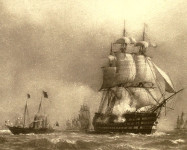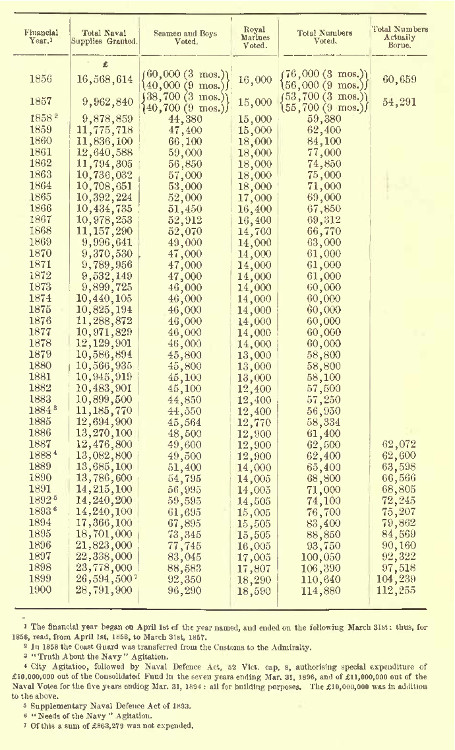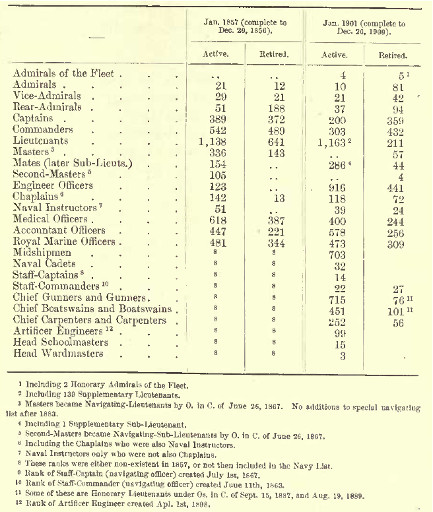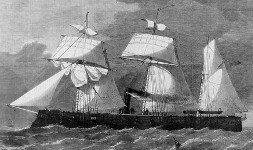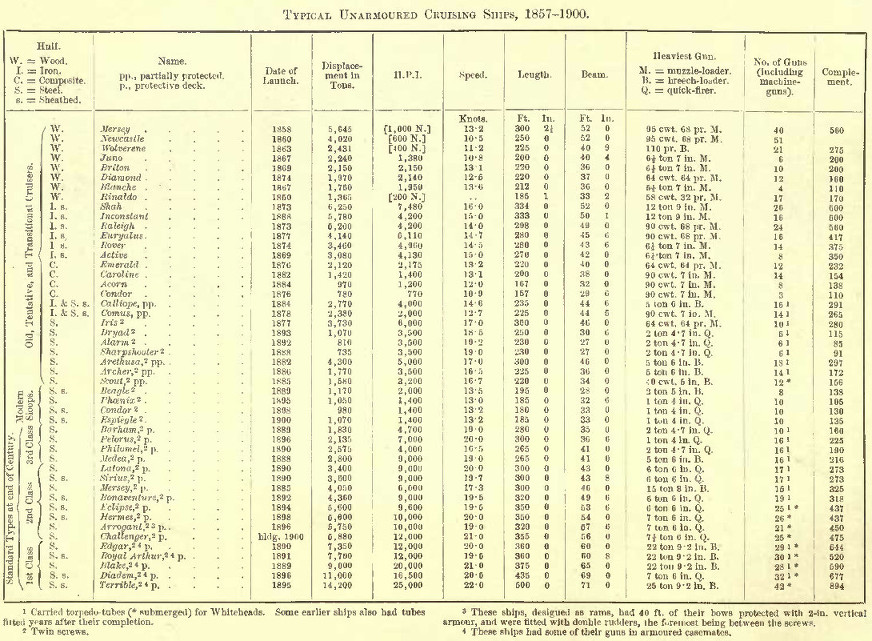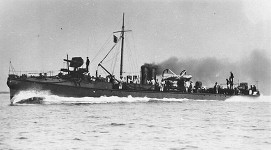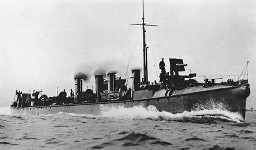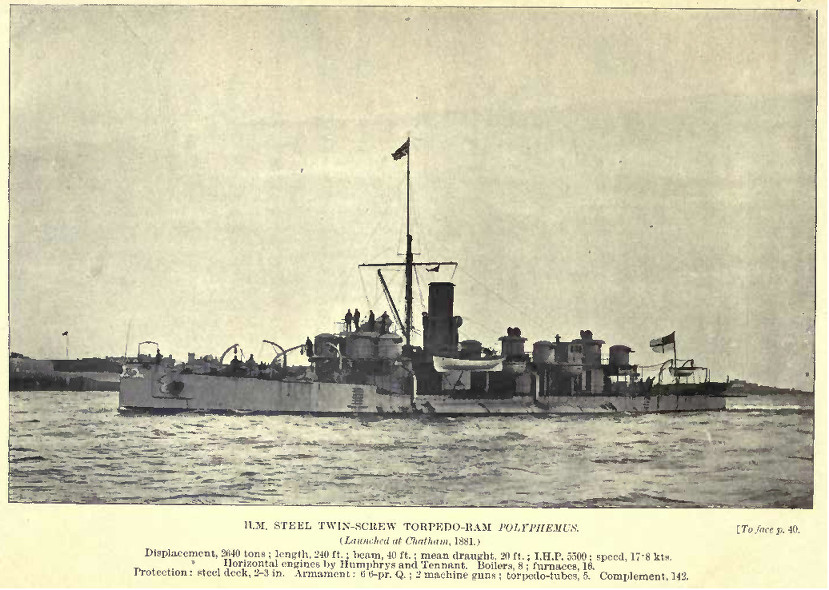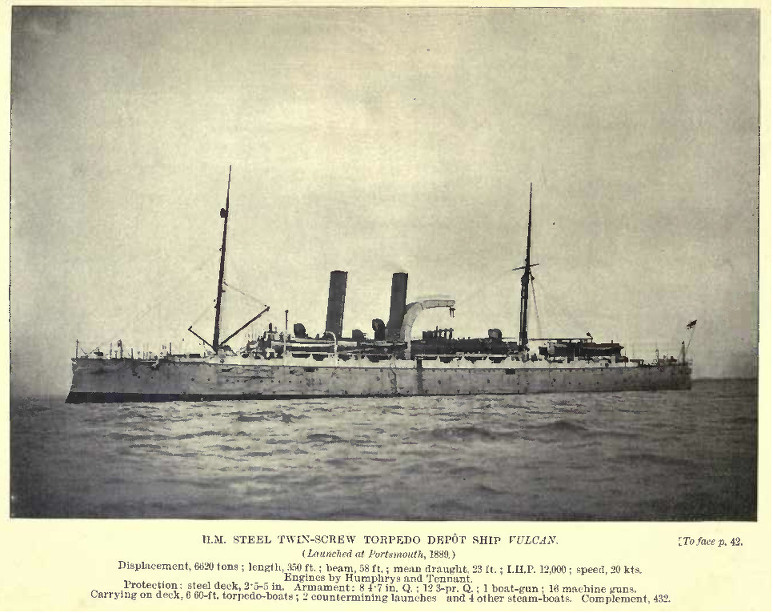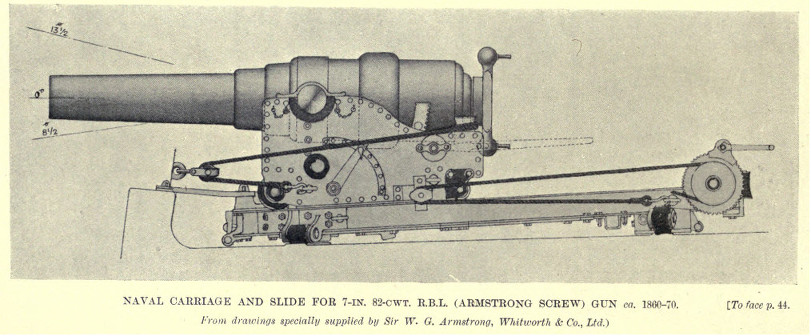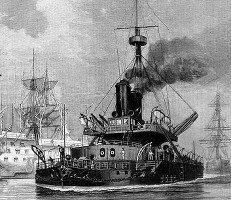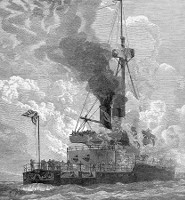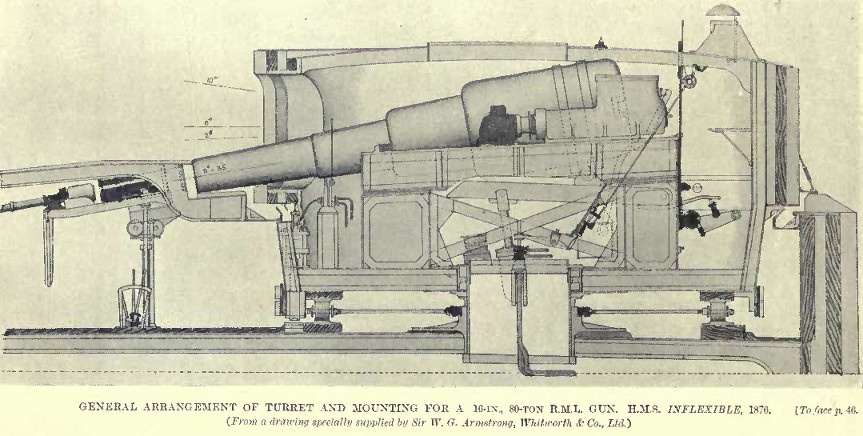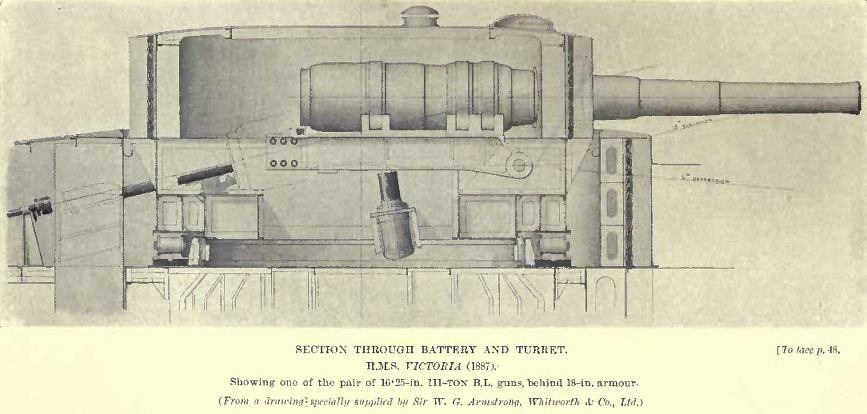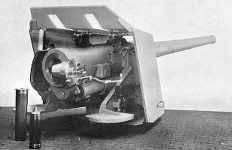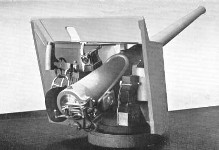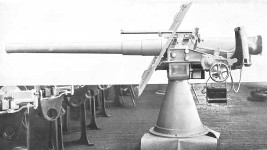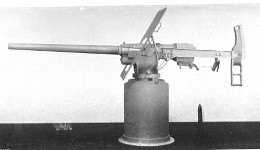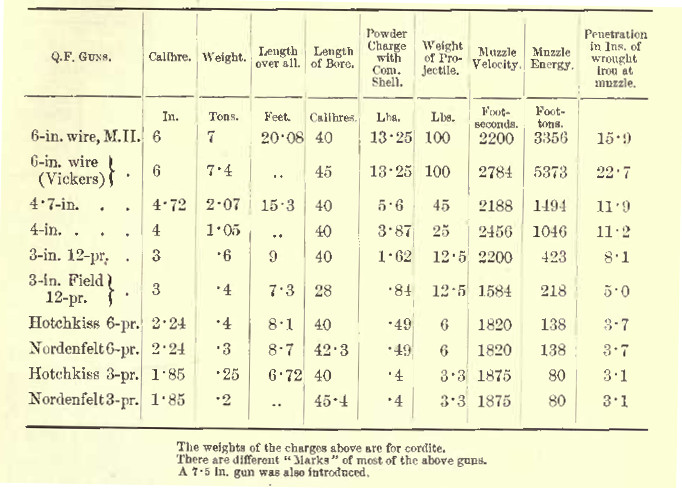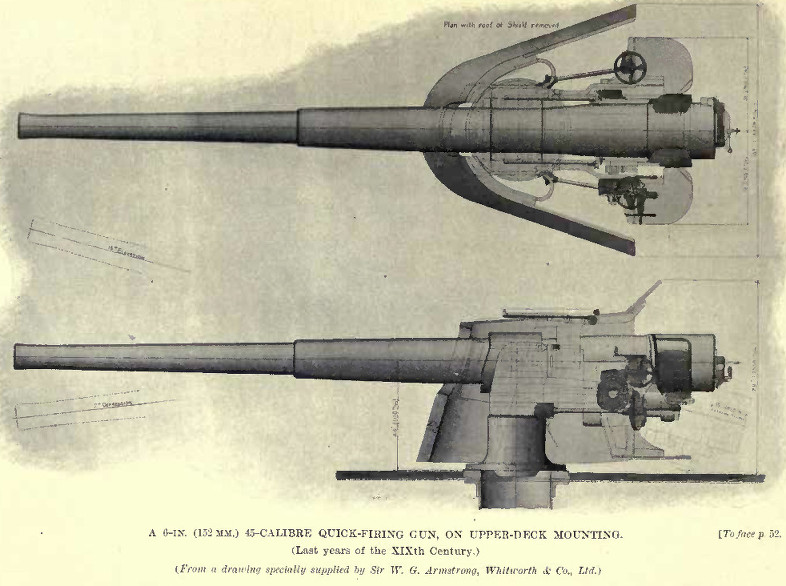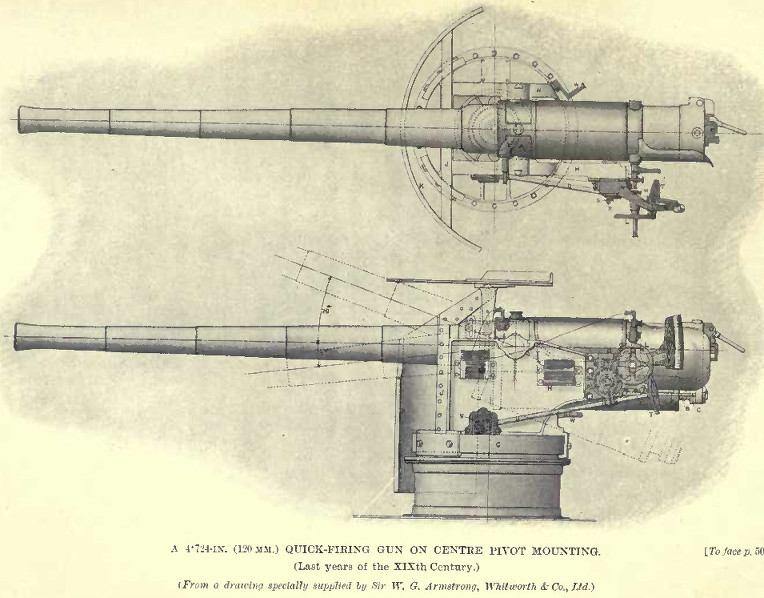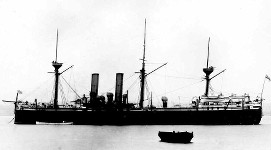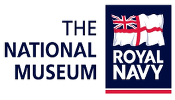|
The frontispiece "Types of the Old Navy" (click to enlarge) |
on
to App to Ch 46, Flag Officers |
|
A Modern Introduction
Forget
your ideas about boring, dense, leather-bound Victorian
tomes. This one puts many modern books to shame with its
clear layout, excellent diagrams and tables, and its
readability. I wanted a good contemporary account of the
Navy in the second half of the 19th century and found
just that in Sir William Laird Clowes last volume. The
book covers so much that I decided to tackle one part at
a time, starting with the Introduction and the "Civil
History" of the Royal Navy.
I
had only heard about Clowes histories by reputation, but
it is certainly deserved. A measure of their importance
can be gained from the fact that two of his "Assistants"
were Capt Mahan, author of the famed "The Influence of
Sea Power upon History" and President Theodore Roosevelt
of the United States. As a comprehensive history of the
Royal Navy from the earliest times up to 1900, my hope
is to present all seven volumes in the manner here,
which includes additional images to assist the visitor.
In reading the technical accounts it is important to note that all the industrial/maritime powers took part in the development of warship technology. Indeed there were times when the Royal Navy lagged behind. For example, Clowes refers to 1885 when the Royal Navy, still mainly equipped with muzzle-loading guns could have found itself in battle with a Russian fleet of breech-loaders.
So many characteristics of the Royal Navy we take for granted in the two World Wars and up to the present time can be traced back to this period, which in my opinion makes Clowes' work even more important.
With thanks to Digital Book Index for making this resource available, and also to those internet sites from which the additional images come. Unless otherwise identified, they are from the excellent "Photo Ships".
The
three chapters and three appendices in VOLUME 7 are in
six separate files with links in the Contents List. I
have taken the liberty of replacing the Roman numerals
used for Volumes, Chapters and Appendices to hopefully
make it easier to follow the contents.
Any
transcription and proofing errors are mine.
Gordon Smith, Naval-History.Net |
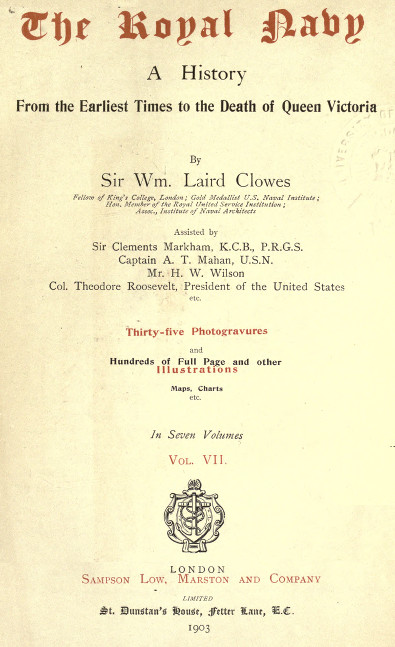
Chapter
46 only |
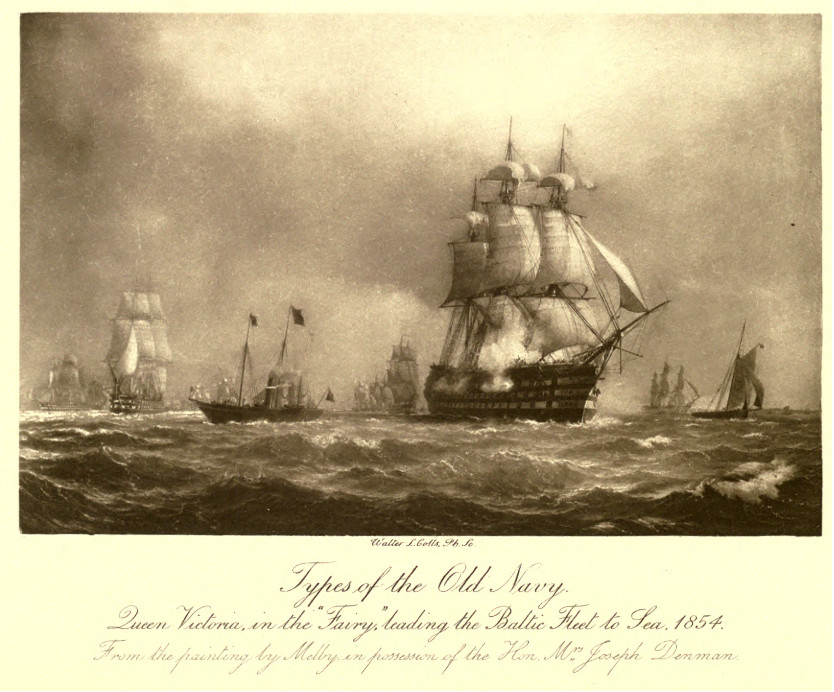
|
Note:
Most of the images are from the original. The ship
images are mainly from Photo Ships. Those that are
not, are identified. My thanks to these sites.
|
CONTENTS
CHAPTER
46.
CIVIL
HISTORY OF THE ROYAL NAVY, 1857-1900 ... 1
By Sir Wm. Laird Clowes.
Page
(sometimes added Section) Headings
Organisation
and Administration:
Admiralty Officials
Superintendents of Dockyards
Reorganisation of the Admiralty
Constitution of the Admiralty
Strength of the Officers' List
Changes in Officers' Rank
Pay and Wages
Naval Reserves
Warships:
The First Ironclads
Iron as a Building Material
Experimental Types of Fighting Ships
Sea-Going Turret Ships
The Forces of Evolution
Transitional Types of Fighting Ships
The Standard Type of Battleship
The "Formidable" Class
Gun-Vessels and Gun-Boats
Torpedo Boats
Destroyers and Special Service Craft
Weapons and
Technical
The Earliest Breechloaders
Reversion to the Muzzle-Loader
Woolwich-Armstrong Breechloaders
Quick-Firing Guns
Gunnery
Screws
Boilers
The Development of Armour
The Whitehead Torpedo
Submarine Boats
Masts and Sails
Signalling
Personnel
and General
Health
of the Navy
Scientific Training
Training of Reserves
The Royal Marines
Naval Clubs
Influence on Foreign Navies
The Character of the Bluejacket
Popular Interest in the Navy
Naval Reviews
Appendix to Chapter 46. (link to different file):
Flag-Officers
Holding the Principal Commands, 1857-1900 ... 85
CHAPTER 47.
(in preparation)
MILITARY HISTORY
OF THE ROYAL NAVY, 1857-1900 ... 91
By Sir Wm. Laird
Clowes.
CHAPTER
48
(link to different file)
VOYAGES AND DISCOVERIES, 1857-1900 ... 562
By Sir Clements E. Markam, K.C.B., P.R.G.S.
Appendix A to Chapters 46-48: (link to different file)
List of Flag-Officers Promoted 1857-1900 ... 569
Appendix B to Chapters 46-48: (in preparation)
List of H.M.
Ships Lost, Etc., 1857-1900 ... 582
INDEX
(not included)
LIST OF ILLUSTRATIONS
in
Chapter 46 only
VOLUME 7.
Photogravure
Plates.
Full-Page
Illustrations
Armour of British Ironclads, 1859-73 ... 24
H.M.S. "Glory," 1899 ... 34
H.M.S. "Viper," 1900 ... 38
H.M.S. "Polyphemus," 1881 ... 40
H.M.S. "Vulcan," 1889 ... 42
Naval Carriage and Slide For 7-in. R.B.L. Gun, 1860-70 ... 44
Turret and Mounting for a 16-in. 80-Ton R.M.L. Gun, 1876 ... 46
Section Through Turret of H.M.S. "Victoria," 1887 ... 48
A 4.7-in. Gun on Centre-Pivot Mounting ... 50
A 6-in. 45-Cal. Q.F. Gun on Upper-Deck Mounting ... 52
Armour of British Ironclads, 1874-94 ... 56
Rear-Admiral H.R.H. Prince George of Wales ... 83
Illustrations
In The Text
The Rt. Hon. George Joachim, 1st Viscount Goschen ... 9
Signature of Sir Edward James Reed, K.C.B., F.R.S. ... 10
Signature of Sir Nathaniel Barnaby, K.C.B. ... 10
H.M.S. "Royal Sovereign," 1857-64 ... 22
Plan of H.M.S. "London" ... 34
Plan of H.M.S. " Essex" ... 35
Plan of H.M.S. "Cressy" ... 37
Egyptian Medal, 1882 ... 84
INTRODUCTION
TO VOLUME 7.
THE present volume completes the History of
the Royal Navy from the earliest times down to the date of the
death of her late Majesty, Queen Victoria, at the beginning of
the year 1901. Publication of the work, which, it was
originally intended, should be finished in about three years
and a half, counting from the summer of 1896, has
unfortunately occupied instead a period of nearly seven years;
and I fear that the unpremeditated delay in the appearance of
volume after volume has been not only a disappointment to many
people who have been good enough to take a lively interest in
the progress of the work, but also a source of great
additional expense to my most courteous and considerate
publishers.
Begun at a time when I was in my usual good
health, Volume I. was still in the rough when I was attacked
by a malady, which, though its action is sometimes slow,
seldom spares the life of its victim; and, in consequence, I
was suddenly ordered away from England, where alone I could
have prosecuted the work under conditions entirely favourable.
Except during brief intervals, I had to remain abroad or in
the Channel Islands until the autumn of 1902. These facts
account for some part of the delay.
Another part is to be accounted for by a
determination, arrived at about the year 1898, that the book
should consist of a larger number of volumes than had been
originally contemplated. The number first fixed upon had been
five: it grew to six, and then to seven. I do not think that
this extension of scope is, upon the whole, to be regretted,
although undoubtedly it postponed the publication of the final
volume for more than two years. It has enabled a more liberal
allowance of space than otherwise would
INTRODUCTION
TO VOLUME 7.
have been available to be devoted to an account of the marvellous material changes which revolutionised naval warfare in the last half of the nineteenth century, and it afforded room for the inclusion of what I trust, will be found to be a sufficiently full history the Navy's share in the important operations in South Africa and China in the closing days of the Victorian era. The lamented death of the great Queen, at the very threshold of a new century immediately after success had been secured in China and assured in South Africa, furnished me with a date obviously suitable, in every respect, at which to bring my task to a halt.
I do not wish to insist too strongly upon
the disadvantages under which, as I have explained, I laboured
almost from the commencement: but it is necessary that I
should ask that any unfavourable sentence which may be passed
upon my work shall be mitigated in consideration of the
hostile circumstances in which I have been obliged to perform
it. I know, far better than anyone who may be my critic, the
numerous shortcomings of these seven volumes. I know, too, how
much fewer those shortcomings would have been, if I had had
good health instead of bad, throughout these seven years.
Excellent searchers, and other
fellow-workers have aided me from the beginning to the utmost
of their power; yet I would have preferred to do for myself
what they have done me; and, had I been in a position to do
so, the results would have been more satisfactory, certainly
to myself, possibly also to the reader; for it hardly needs
saying that notes and documents in one's own handwriting are
less likely to be misunderstood, mis-transcribed in quotation,
and misapplied, than notes and documents copied in a score of
different writings, not all of which are equally legible.
Nevertheless, thanks to the large revision which most of the
history of the events of the second half of the last century
has undergone at the kind hands of those who took personal
part in them, I have reason to hope that, upon the whole, the
contents of this volume are very trustworthy records or the
facts.
During the long and interesting period covered by this final instalment of the work, Great Britain was engaged in no purely maritime war of any importance. She was not called upon to fight one considerable action in the open sea; and such bombardments as her ships were concerned in were far less serious matters than the bombardment of Copenhagen, in 1801, or even the naval attack upon Sebastopol in 1854.
INTRODUCTION TO
VOLUME 7.
Yet at no period has the British Navy been
more continuously engaged, or more widely employed, in small
wars, and in those too soon forgotten police duties, which
confer so many benefits upon the Empire, and often lack,
nevertheless, any chronicler other than the officer who
reports them dryly to the Admiralty. Some hundreds of these
minor operations will be found described in the present
volume; and few readers, I suspect, will fail to be surprised
at the number of them. They give one a new idea of the
wakefulness and ubiquity of the Empire's maritime forces. Here
a rebel tribe is chastised; there a consul is protected and
vindicated; elsewhere a slaver is captured and her cargo of
slaves set at liberty; and much of this is done without the
great public hearing a word about it at the time. The extent
and usefulness of this quiet work of the Navy is one of the
characteristics of the period under review.
Another is the frequency, previously
unparalleled, with which the officers and men of the service,
either with troops or alone, have been employed to do what
should be purely landsmen's work, all over both hemispheres,
sometimes fighting hundreds of miles from the sea. I venture
to think that this employment of them has tended of late to
become far too common. The naval officer and the bluejacket
are expensive servants of His Majesty. They cannot be trained
or replaced quickly, and they are entered and educated for
another object. When a ship disembarks and sends up-country a
large contingent of her people, and possibly also a number of
her guns, she reduces her own usefulness, perhaps to vanishing
point; and, on certain stations, it might be an extremely
serious matter if, in the event of a large man-of-war being
suddenly required to cope with an emergency, she could neither
move nor fight.
One can hardly resist the conclusion that
if the army, regular and irregular, were formed, organised,
armed, and stationed as it should be, the calls for the
assistance of the Navy on shore would be fewer. It is,
however, a subject for congratulation that the Navy, when thus
summoned, has never failed to respond in the handsomest and
noblest manner; and that, whether working single-handed or
with the army, alike in New Zealand, in India, in the Soudan,
in South Africa, and in China, it has gathered to itself fresh
laurels.
INTRODUCTION
TO VOLUME 7.
The Royal Marines, of course, are properly
enough regarded as an amphibious corps; yet the manner in
which, on at least one occasion, they were employed in South
Africa suggests that those generals who recollected that the
Marines are soldiers may have forgotten that they are also
part of every efficient British man-of-war's complement. Even
more than the seamen, if that be possible, have the Royal
Marines added, since 1856, to their magnificent reputation.
Yet another characteristic of the period -
and I greet it as a happy omen is the increasing frequency
with which the officers and bluejackets of the United
States of America have found themselves ranged side
by side with their cousins of the British Navy. In the Pei-ho,
in Japan, in Central America, in the far North-West, on the
Atlantic during the laying of the early cables, in Egypt, in
Chile, in Samoa, and, more recently, in China, American seamen
and marines have been the loyal comrades of British ones; nor,
I believe, has any unpleasantness, jealousy, or friction ever
arisen when men of both nations have served together, as has
often happened, under the leadership and command of a single
officer, British or American.
The naval services of the two
English-speaking nations have shown their trust in, and
sympathy with, one another so repeatedly, and have so often
cemented their good feeling with the shedding of blood and the
sacrifice of gallant life, that one is entitled to hope that
never in the future will the relations between them be less
frank and cordial, and that the general body of the people of
the two countries will soon learn to look towards one another
as generously and confidently as the two navies do already.
Britain and America, acting together, should always be able to
ensure the peace of the world. Their action on opposite sides
would be the greatest catastrophe that could possibly happen
to the interests of civilisation, freedom, and progress.
To name here all those who have encouraged and assisted me in the final stage of my long task would be impossible. His most gracious Majesty has been pleased to show his personal interest in the undertaking by conferring upon me an honour which only his kindness could have deemed me deserving of. From Viscount Goschen, the late, and the Earl of Selborne, the present, First Lord of the Admiralty, I have received help for which I cannot too fully express my gratitude. To the Foreign Office also I am much indebted. The authorities of the British Museum Library, and the Library of the Patent Office, as usual, have given ready help to my assistants; and Sir William Howard Russell has facilitated their researches in certain directions by placing at their disposal, and allowing to be removed from his office, his own file of the Army and Navy Gazette.
INTRODUCTION TO VOLUME 7.
To Mr. A. F. Yarrow, the well-known builder
of fast small craft, I am deeply obliged for the personal
interest which he has taken in .the completion of the work,
and for the sympathetic manner in which he has aided me.
To mention the naval officers who have
furnished me with facts and suggestions would almost involve
the transcription to these pages of the entire list of living
and lately living flag-officers and captains. It has been my
aim, whenever possible, to secure personal narratives, in the
shape of letters, diaries, and private journals, wherewith to
supplement the information, often very meagre and defective,
contained in official despatches: and my efforts in that
direction have brought me into correspondence, during the past
ten years, with no fewer than 741 naval and Marine officers,
who, nearly without exception, have taken much trouble on my
behalf, and have generously placed at my disposal everything
in their possession that could be of use to me. Many valuable
facts relating to the work of the Royal Marines have been
brought to my notice, thanks to the courtesy of the officers
editing the Globe and Laurel, the admirable journal of that
distinguished corps.
Of officers who, though not in the Navy,
were associated intimately with duties in which the Navy was
employed, no one showed me greater kindness, or took more
pains to be of real service to me than the late General Sir
Andrew Clarke.
To Miss E. M. Samson, who has again
undertaken the difficult business of providing the index, I
tender my grateful thanks. To my publishers, Messrs. Sampson
Low, Marston & Co., Ltd., and, in particular to Mr. E.
Marston and to his son, Mr. E. B. Marston, members of the
Directorate, I owe more gratitude than I can express for the
generous and cheerful way in which they have borne with the
numerous disappointments and annoyances incidental to the
association with them in a great and costly undertaking of one
who too frequently has been incapable, for weeks at a time, of
carrying out the letter of his agreements with them. The
kindly allowances which Mr. R. B. Marston, with whom I chiefly
corresponded, was ever willing to make, and the thoughtful way
in which he ever considered my health rather than his
convenience, will never be forgotten by me. If this History,
as I hope it may, be welcomed as a chronicle of affairs which
hitherto have never been chronicled
INTRODUCTION
TO VOLUME 7.
together in a single, work; if it aid, as I
trust it will, in strengthening my countrymen for many a year
to come in their determination that the British Navy shall be
second to none in the world; and if, in the future, the long
story which is told in it shall contribute aught to the
encouragement of Britons who are inclined to despair, or to
the ardour of those who believe in the glorious destinies of
their race, then let the credit be given to the Messrs.
Marston, but for whose patriotic co-operation it could not
have been offered to the public.
WM. LAIRD
CLOWES.
April, 1903.
1
CHAPTER
46
CIVIL
HISTORY OF THE ROYAL NAVY, 1857-1900.
Administrative
Officials at the Admiralty and the Dockyards - Changes at the
Admiralty - Division of Admiralty Work - The Navy Estimates -
Alterations in the Active List - Admirals of the Fleet -
Flag-Officers - Ensigns - The Navigating Branch - New Ranks -
Retirement - Pay - Wages - Naval Reserves - Naval Architecture -
Ironclads - Experimental Types - New factors in Naval Warfare -
Armoured Cruisers - Unarmoured Cruisers - Gunboats -
Torpedo-boats - Torpedo-boat Catchers - Destroyers - Miscellaneous
Craft - Yachts - Mercantile Auxiliaries - Ordnance - The first
Breech-loaders - Improved Muzzle-loaders - The later
Breech-loaders - Quick-firing Guns - Small Arms - Machine-guns -
Gunnery - Engines and Boilers - Screws - Turbines - Water-tube
Boilers - Armour - Projectiles - Torpedoes - Torpedo-nets -
Submarine Boats - Illumination - Electricity - Masts and Sails -
Conning-towers - Signalling - Uniform - Health of the Navy -
Training and Technical Education - The Britannia - Gunnery and
Torpedo Schools - Training-ships - Technical Schools - Guardships
- Royal United Service Institution - Miscellaneous Innovations -
Orders and Medals - Naval Clubs - Influence of the British Navy on
Foreign Services - Attaches - The Naval Intelligence Department -
The Bluejacket - Sailors' Homes - Royal Naval Fund - Influence of
popular Interest in the Navy - Naval Reviews - The Royal Naval
Exhibition - The Navy League - The Navy Records Society - The
Jubilee Reviews.
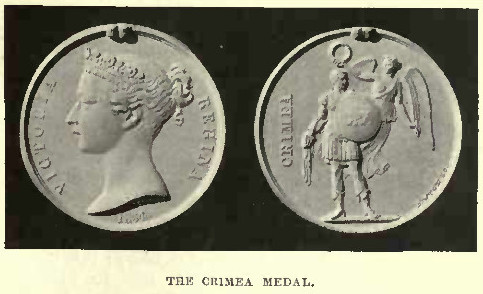
2 CIVIL HISTORY OF THE ROYAL NAVY, 1857-1900.
pages 2-8
ADMIRALTY OFFICIALS
Feb. 25, 1858, Earl of Derby;
June 18, 1859, Lord Palmerston;
Nov. 6, 1865, Earl Russell;
July 6, 1866, Earl of Derby;
Feb. 27, 1868, Mr. Disraeli;
Dec. 9, 1868, Mr. Gladstone;
Feb. 21, 1874, Mr. Disraeli (Earl of Beaconsfield, 1876);
Apr. 28, 1880, Mr. Gladstone;
June 24, 1885, Marquess of Salisbury;
Feb. 6, 1886, Mr. Gladstone;
Aug. 3, 1886, Marquess of Salisbury;
Aug. 18, 1892, Mr. Gladstone;
Mar, 3, 1894, Earl of Rosebery;
July 2, 1895, Marquess of Salisbury (again 1900).
FIRST LORDS OF
THE ADMIRALTY.
Mar. 8, 1858. Rt. Hon. Sir John Somerset Pakington, Bart., M.P. (G.C.B. 1859).
June 28, 1859. Edward Adolphus, 12th Duke of Somerset, K.G.
July 13, 1866. Rt. Hon. Sir John Somerset Pakington, Bart., G.C.B., M.P.
Mar. 8, 1867. Rt. Hon. Henry Thomas Lowry Corry, M.P.
Dec. 18, 1868. Rt. Hon. Hugh Culling Eardley Childers, M.P.
Mar. 13, 1871. Rt. Hon. George Joachim Goschen, M.P.
Mar. 6, 1874. Rt. Hon. George Ward Hunt, M.P.
Aug. 15, 1877. Rt. Hon. William Henry Smith, M.P.
May 13, 1880. Thomas George, 1st Earl of Northbrook, G.C.S.I.
July 2, 1885. Rt. Hon. Lord George Francis Hamilton, M.P.
Feb. 16, 1886. George Frederick Samuel, 1st Marquess of Ripon, G.C.S.I.
Aug. 6, 1886. Rt. Hon. Lord George Francis Hamilton, M.P.
Aug. 23, 1892. John Poyntz, 5th Earl Spencer, K.G.
July 4, 1895. Rt. Hon. George Joachim Goschen, M.P.
Nov. 1900. William Waldegrave, 2nd Earl of Selborne.
SECRETARIES
OF THE ADMIRALTY.
FIRST SECRETARY.
Ralph Bernal
Osborne, M.P.
Mar. 9, 1858. Rt. Hon. Henry Thomas Lowry Corry, M.P.
June 30, 1859. Lord Clarence Edward Paget, C.B., M.P., R.-Adm. (V.-Adm. 1865).
Apr.
30, 1866. Hon. Thomas George Baring, M.P. (Lord Northbrook,
1866).
July 16, 1866. Lord
Henry Charles George Gordon-Lennox, M.P.
Dec. 18, 1868. William Edward Baxter, M.P.
(Title changed to that of Parliamentary Secretary, 1870.)
SECOND SECRETARY
Thomas Phinn.
May
7, 1857. William Govett Romaine, C.B.
June 29, 1869. Vernon Lushington, Q.C.
(Title changed to that of Permanent Secretary, 1870.)
PARLIAMENTARY SECRETARY.
July 12, 1870. William Edward Baxter, M.P.
Mar. 6, 1874. Hon. Algernon Fulke Egerton, M.P.
May 15, 1880. Rt. Hon. George John Shaw-Lefevre, M.P.
Dec. 1, 1880. George Otto Trevelyan, M.P.
May 13, 1882. Henry Campbell-Bannerman, M.P.
Nov. 20, 1884. Sir Thomas Brassey, K.C.B., M.P.
July 3, 1885. Charles Thomson Ritchie, M.P.
Feb. 16, 1886. Rt. Hon. John Tomlinson Hibbert, M.P.
Aug. 6, 1886. Arthur Bower Forwood, M.P.
Aug. 24, 1892. Rt. Hon. Sir Ughtred James Kay-Shuttleworth, Bart., M.P.
July 4, 1895. William Grey Ellison-Macartney, M.P.
Nov. 1900. Hugh Oakeley Arnold-Forster, M.P.
upon the abolition of the office of Naval Secretary.)
May 15, 1882. Robert Hall (3), C.B., retd. V.-Adm., (actg.), (died June 11, 1882).
June 13, 1882. George Tryon, C.B., Capt., R.N. (actg.).
May 3, 1883. George Tryon, C.B., Capt., R.N.
Apr. 2, 1884. Evan Macgregor, C.B. (K.C.B., 1892).
Feb. 7, 1861. Robert Spencer Robinson, 1 R.-Adm.(V.-Adm.l866, K.C.B. 1868).
Feb. 14, 1871. Robert Hall (3), 1 C.B., Capt., R.N.
Apr. 29, 1872. William Houston Stewart, C.B., R.-Adm. (V.-Adm. 1876; K.C.B. 1877: Adm. 1881).
Dec. 1, 1881. Thomas Brandreth, R.- Adm. 1 (V.-Adm. 1884).
Nov. 28, 1885. William Graham, C.B., V.-Adm. 1 (K. C. B., 1887).
Aug. 6, 1888. John Ommanney Hopkins, R.-Adm. 1 (V.- Adm. 1891).
Feb. 2, 1892. John Arbuthnot Fisher, C.B., R.-Adm. 1 (K.C.B., 1894: V.-Adm. 1896).
Aug. 24, 1897. Arthur Knyvet Wilson, C.B., V.C., R.-Adm.1
May 10, 1858. Charles Richards, Paym., R.N. 2
Feb. 1, 1886. Henry Francis Redhead Yorke (late R.N.), (C.B. 1897).
DIRECTOR OF TRANSPORTS AND PRISONERS OF WAR.
Feb. 21, 1855.
William Drew.
(In
1857 the duties of this office were added to those of the
Controller of the Victualling;
but
the services were again separated in 1862.)
DIRECTOR OF
TRANSPORTS.
Apr. 30, 1862.
William Robert Mends, C.B., Capt. R.N. (retd. R.-Adm. 1868;
K.C.B.; retd. V.-Adm. 1874; retd. Adm., 1879; G.C.B. 1882).
Apr. 1, 1883. Sir
Francis William Sullivan, K.C.B., C.M.G., R.-Adm. (V.-Adm.
1885).
Aag. 20, 1888.
Harry Woodfall Brent, Capt., R.N. (retd. 1889; retd. R.-Adm.
1890).
Aug. 20, 1896.
Bouverie Francis Clark, Capt., R.N. (retd. 1897; retd. R.-Adm.,
1899.)
STOREKEEPER-GENERAL.
Hon. Robert
Dundas.
(Title
changed in 1869 to that of Superintendent of Stores.)
SUPERINTENDENT OF
STORES.
Apr. 13, 1869.
Nelson Girdlestone.
Jan. 23, 1872.
Coghlan McLean Hardy.
(Title
changed in 1876 to that of Director of Stores.)
DIRECTOR OF
STORES.
1876. Coghlan
McLean Hardy.
Apr. 1, 1889.
William George Front Gilbert.
Apr. 1, 1895.
Gordon William Miller.
HYDROGRAPHER.
John Washington,
Capt., R.N.
Sept. 19, 1863.
George Henry Richards, Capt., R.N. (R.-Adm. 1870; C.B. 1871;
retd. R.-Adm., Jan. 19, 1874).
Feb. 3, 1874.
Frederick John O. Evans, C.B., retd. Capt., R.N. (later K.C.B.)
Aug. 1, 1884.
William James Lloyd Wharton, Capt,, R.N. (retd. 1891; retd.
R.-Adm. 1895; C.B. 1895; K.C.B., 1897).
CHIEF
CONSTRUCTOR.
Isaac Watts (C.B.
1862).
July 9,1863.
Edward James Reed (C.B., 1868, K.C.B., 1880).
Resigned
July 8, 1870, whereupon the office was left open until:
Aug. 17, 1872.
Nathaniel Barnaby (C.B., 1876; K.C.B., 1885.)
(Title
changed in 1875 to that of Director of Naval Construction.)
DIRECTOR OF NAVAL
CONSTRUCTION.
1875. Nathaniel
Barnaby.
Oct. 1, 1885.
William Henry White.
(Title
of Assistant Controller added Dec. 17, 1885.)
ASSISTANT
CONTROLLER AND DIRECTOR OF NAVAL CONSTRUCTION.
Dec. 17, 1885.
William Henry White (C.B. 1891; K.C.B. 1895).
CHIEF ENGINEER
AND INSPECTOR OF STEAM MACHINERY.
Thomas Lloyd.
(Title
abolished, Feb. 4, 1869.)
SURVEYOR OF
FACTORIES AND WORKSHOPS AND CONSULTING ENGINEER.
Jan. 19, 1869.
Andrew Murray.
(Title
abolished, Feb. 24, 1870.)
ENGINEER-ASSISTANT.
Oct. 20, 1860.
James Wright.
(
Title changed in 1872 to that of Engineer- in-Chief.)
ENGINEER-IN-CHIEF.
Aug. 17, 1872.
James Wright (C.B. 1880).
May 1, 1887.
Richard Sennett, Insp. of Mach., R.N.
May 6, 1889.
Albert John Durston, Insp. of Mach., R.N. (Chf. Insp. of Mach.
1893; C.B. 1895; K.C.B. 1897).
ACCOUNTANT-GENERAL
OF THE NAVY.
Sir Richard Madox
Bromley, K.C.B.
Apr. 1, 1863.
James Beeby.
Oct. 31, 1872.
Henry William Routledge Walker.
June 1, 1878.
Robert George Crookshank Hamilton.
May 8,1882.
William Willis (Kt. 1885).
June 1, 1885. Sir
Gerald Fitzgerald, K.C.M.G.
Dec. 1, 1896.
Richard Davis Awdry, C.B.
DIRECTOR-GENERAL
OF THE MEDICAL DEPARTMENT OF THE NAVY.
Sir John Liddell,
M.D., F.R.S., R.N.
Jan. 21, 1864.
Alexander Bryson, C.B., M.D., R.N.
Apr. 15, 1869.
Alexander Armstrong, M.D., R.N. (K.C.B. 1874).
Feb. 1, 1880. John
Watt Reid, M.D., R.N. (K.C.B. 1882).
Feb. 27, 1888.
James Nicholas Dick, C.B., R.N. (K.C.B. 1895).
Apr. 1, 1898. Sir
Henry Frederick Nor- bury, M.D., K.C.B., R.N.
COMPTROLLER-GENERAL
OF THE COAST GUARD.
Charles Eden,
Commodore.
Aug. 3, 1859.
Hastings Reginald Yelverton, C.B., Commodore.
Apr. 27, 1863.
Alfred Phillipps Ryder, Commodore.
Apr. 9, 1866. John
Walter Tarleton, C.B. (R.-Adm. 1868).
(This
office was abolished in 1869.)
ADMIRAL
SUPERINTENDENT OF NAVAL RESERVES.
Jan. 1,1875. Sir
John Walter Tarleton, K.C.B., V.-Adm.
Nov. 13, 1876.
Augustus Phillimore, R.-Adm. (V.-Adm. 1879).
Nov. 21, 1879.
H.R.H. Alfred Ernest Albert, Duke of Edinburgh, K.G., etc.,
R.-Adm.
Nov. 23, 1882. Sir
Anthony Hiley Hoskins, K.C.B., R.-Adm. (V.-Adm. 1885).
Sept. 6, 1885.
John Kennedy Erskine Baird, R.-Adm. (V.-Adm. 1886).
Apr. 17, 1888. Sir
George Tryon, K.C.B., R.-Adm. (V.-Adm. 1889).
Apr. 21, 1891.
Robert O'Brien FitzRoy, C.B., R.-Adm.
Apr. 25, 1894.
Edward Hobart Seymour, C.B., R.-Adm. (V.-Adm. 1895).
May 10, 1897. Compton Edward Domvile, V.-Adm. (K.C.B. 1898).
May 21, 1900. Sir
Gerard Henry Uctred Noel, K.C.M.G., R.- Adm.
DIRECTOR OF NAVAL
INTELLIGENCE.
Feb. 1, 1887.
William Henry Hall, Capt., R.N.
Jan. 1, 1889.
Cyprian Arthur George Bridge, Capt., R.N. (R.-Adm. 1892).
Sept. 1, 1894.
Lewis Anthony Beaumont, Capt., R.N. (R.-Adm. 1897).
Mar. 20, 1899.
Reginald Neville Custance, C.M.G., Capt., R.N. (R.-Adm. 1899).
SUPERINTENDENTS OF H.M. DOCKYARDS.
Chatham.
George Goldsmith,
C.B., Capt., R.N.
Apr. 1, 1861.
Edward Gennys Fanshawe, Capt., R.N.
Nov. 19, 1863.
William Houston Stewart, C.B., Capt, R.N.
Dec. 1,1868.
William Charles Chamberlain, Capt., R.N.
Jan. 19, 1874.
Charles Fellowes, C.B., Capt., R.N. (R.-Adm. 1876).
Feb. 3, 1879.
Thomas Brandreth, R.-Adm.
Dec. 1, 1881.
Georges Willes Watson, R.-Adm. (V.-Adm. 1886).
May 1,1886.
William Codrington, C.B., R.-Adm.
Nov. 1, 1887.
Edward Kelly, R.-Adm.
Jan. 25, 1892.
George Digby Morant, R.-Adm. (V.-Adm. 1895).
Sept. 2, 1895.
Hilary Gustavus Andoe, C.B., R.-Adm.
Sept. 2, 1899.
Swinton Colthurst Holland, R.-Adm.
Portsmouth.
William Fanshawe
Martin, R.-Adm.
Feb. 25, 1858.
Hon. George Grey (2) R.-Adm.
Feb. 19, 1863.
George Elliot (4), R.-Adm.
July 1, 1865.
George Greville Wellesley, C.B., R.-Adm.
July 1, 1869.
Astley Cooper Key, C.B., R.-Adm.
Nov. 20, 1871.
William Houston Stewart, C.B., R.-Adm.
Apr. 29, 1872. Sir
Francis Leopold M'Clintock, R.-Adm.
Apr. 30, 1877.
Hon. Fitzgerald Algernon Charles Foley, R-.Adm. (V.-Adm. 1881).
May 1, 1882. John
Dobree M'Crea, R.-Adm.
Apr. 6, 1883.
Frederick Anstruther Herbert, R.-Adm.
Nov. 1, 1886. John
Ommanney Hopkins, R.-Adm.
Aug. 6, 1888.
William Elrington Gordon, R.-Adm.
May 21, 1891. John
Arbuthnot Fisher, C.B., R.-Adm.
Feb. 1, 1892.
Charles George Fane, R.- Adm.
Feb. 1, 1896.
Ernest Rice, R.-Adm. (V.- Adm. 1899).
Sept. 1, 1899. Pelham Aldrich, R.-Adm.
Devonport.
Feb. 19,1855. Sir James Hanway Plumridge, K.C.B., R.-Adm.
Dec. 9, 1857. Sir Thomas Sabine Pasley, Bart., R.-Adm.
Nov. 28, 1862. Thomas Matthew Charles Symonds, C.B., R.-Adm.
May 9, 1866. Hon. James Robert Drummond, C.B., R.-Adm.
July 13, 1870. William Houston Stewart, C.B., R.-Adm.
Nov. 22, 1871. Sir William King Hall, K.C.B., R.-Adm.
Aug. 12, 1875. William Charles Chamberlain, R.-Adm.
May 1, 1876. George Ommanney Willes, C.B., R.-Adm.
Feb. 1, 1879. Charles Webley Hope, R.-Adm.
Feb. 23, 1880. Charles Thomas Curme, R.-Adm.
Feb. 23,1885. John Crawford Wilson, R.-Adm. (died).
July 10, 1885.
Henry Duncan Grant, C.B., R.-Adm. (V.-Adm. 1888).
Aug. 4, 1891. Sir
Robert Henry More-Molyneux, K.C.B., R.-Adm. (V.-Adm. 1894).
Aug. 7, 1894.
Edmund John Church, R.-Adm.
Nov. 3, 1896.
Henry John Carr, R.-Adm.
July 7, 1899.
Thomas Sturges Jackson, R.-Adm.
Woolwich
("Commod. in Charge").
(Dec. 31, 1853.)
John Shepherd (2), Commod. 2nd Cl.
Dec. 20, 1858.
Hon. James Robert Drummond, Commod., 2nd Cl.
June 29, 1861. Sir
Frederick William Erskine Nicholson, Bart., Commod., 2nd Cl.
Jan. 1, 1864. Hugh
Dunlop, C.B., Commod., 2nd Cl.
Apr. 9, 1866.
William Edmonstone.C.B., Commod., 2nd Cl.
(Dockyard
closed 1869.)
Deptford.
Horatio Thomas
Austin, C.B., Capt., R.N.
Dec. 12, 1857.
Claude Henry Mason Buckle, C.B., Capt., R.N.
Feb. 9, 1863.
Henry Chads, Capt., R.N.
Apr. 10, 1866. Arthur Parry Eardley Wilmot, C.B., Capt., R.N.
(Dockyard
closed, 1869.)
Sheerness.
John Jervis
Tucker, Capt., R.N.
Sept. 23, 1857.
John Coghlan Fitzgerald, Capt., R.N.
June 9, 1859.
Rundle Surges Watson, C.B., Capt., R.N.
July 3, 1860.
Charles Wise, Capt., R.N.
Apr. 27, 1865.
William King Hall, C.B., Capt., R.N.
Apr. 1, 1869. Hon.
Arthur Auckland Leopold Pedro Cochrane, C.B., Capt., R.N.
May 25, 1870.
William Garnham Luard, C.B., Capt., R.N.
Jan. 9, 1875. Hon.
Fitzgerald Algernon Charles Foley, Capt., R.N.
Jan. 9, 1877.
Thomas Brandreth, Capt., R.N.
Jan. 4, 1879.
Theodore Morton Jones, Capt. R.N.
Jan. 1, 1883.
John Ommanney Hopkins, Capt., R.N.
Apr. 6,1883.
William Codrington, C.B.. Capt., R.N.
July 17, 1885.
Henry Frederick Nicholson, C.B., Capt.. R.N.
July 1, 1886. Sir
Robert Henry More-Molyneux, K.C.B., Capt., R.N.
June 1,1888.
Charles George Fane, Capt., R.N.
Aug. 6, 1890.
Richard Duckworth King, Capt., R.N.
Jan. 25, 1892.
Armand Temple Powlett, Capt. R.N.
Jan. 1, 1894. John
Fellowes, C.B., Capt., R.N.
Jan. 15, 1895.
John Coke Burnell, Capt., R.N.
Jan. 11, 1898.
Andrew Kennedy Bickford, C.M.G., Capt., R.N.
June 28, 1899.
Reginald Friend Hannam Henderson, C.B., Capt., R.N.
Pembroke.
(May 22, 1854.)
Robert Smart, K.H., Capt., R.N.
July 27, 1857.
George Ramsay, C.B., Capt., R.N.
Sept. 1, 1862.
William Loring, C.B., Capt., R.N.
Mar. 21, 1866.
Robert Hall (3), C.B., Capt., R.N.
Mar. 22,1871.
William Armytage, Capt. , R.N.
Mar. 15, 1875.
Richard Vesey Hamilton, Capt., R.N.
Oct. 16, 1877.
George Henry Parkin, Capt., R.N.
Oct. 15, 1882.
Alfred John Chatfield, Capt., R.N.
Jan. 1, 1886.
Edward Kelly, Capt., R.N.
June 22, 1887.
George Digby Morant, Capt., R.N.
Jan. 7, 1889.
Samuel Long, Capt., R.N.
Aug. 28, 1891.
Walter Stewart, Capt., R.N.
Jan. 1, 1893.
Charles Cooper Penrose FitzGerald, Capt., R.N.
Mar. 21, 1895. Charles John Balfour, Capt., R.N.
(In 1895 Capt. William Henry Hall, appointed to succeed Capt. FitzGerald,, died before he assumed office.).
Oct. 4, 1896.
Burges Watson, Capt., R.N.
Oct. 2, 1899.
Charles James Barlow, D.S.O., Capt., R.N.
Gibraltar ("N.O.
in Charge ").
Apr. 14, 1862.
Erasmus Ommanney, Capt., R.N.
Jan. 1, 1865.
James Charles Prevost, Capt., R.N.
Feb. 1, 1870.
Augustus Phillimore, Capt., R.N.
Jan. 1, 1874. John
Dobree M'Crea, Capt., R.N.
Jan. 16, 1878.
William Henry Edye, Capt, R.N.
Jan. 10, 1881.
Hon. Edmund Robert Fremantle, Capt., R.N.
Dec. 27, 1883.
John Child Purvis (2), Capt., R.N.
Dec. 15, 1886. Henry Craven St. John, Capt., R.N.
Sept. 3, 1889.
Claude Edward Buckle, Capt., R.N.
Jan. 7, 1892.
Atwell Peregrine Macleod Lake, Capt., R.N.
Jan. 20, 1895.
John Andrew Thomas Bruce, Capt., R.N.
Jan. 20, 1898.
Charles Carter Drury, Capt., R.N.
Sept. 1, 1899.
William Harvey Pigott, Capt., R.N.
Malta.
Hon. Sir Montagu
Stopford, K.C.B., R.-Adm.
July 27, 1858.
Henry John Codrington, C.B., R.-Adm.
Apr. 6, 1863.
Horatio Thomas Austin, C.B., R.-Adm.
Nov. 26, 1864.
Henry Kellett, C.B., R.-Adm.
May 25, 1868.
Edward Gennys Fanshawe, R.-Adm.
June 6, 1870.
Astley Cooper Key, C.B., R.-Adm.
Aug. 8, 1872. Sir
Edward Augustus Inglefield, Kt., C.B., R.-Adm.
Dec. 22, 1875.
Edward Bridges Rice, R.-Adm.
May 30, 1876.
William Garnham Luard, C.B., R.-Adm (temp.).
Apr. 13, 1878.
William Garnham Luard, C.B., R.-Adm.
July 18, 1879.
John Dobree M'Crea, R.-Adm.
Mar. 24, 1882.
William Graham, C.B., R,-Adm.
Mar. 25,1885. Hon.
William John Ward, R.-Adm.
May 4, 1887.
Robert Gordon Douglas, R.-Adm.
Jan. 10, 1889.
Alexander Buller, R.-Adm.
Jan. 12, 1892.
Richard Edward Tracey, R.-Adm.
Jan. 20, 1894.
Richard Duckworth King, R.-Adm.
Feb. 1, 1897.
Rodney Maclaine Lloyd, C.B., R.-Adm.
Feb. 1, 1900. Burges Watson, R.-Adm.
REORGANISATION OF THE ADMIRALTY. 9
Some of the changes in the administrative methods of the Admiralty may be traced in the foregoing. Under the rule of Mr. Childers it was felt that the position of the Controller, who had not then a seat at the Board, was anomalous and unsatisfactory; and, by an Order in Council of January 14th, 1869, the Board was accordingly reconstructed, as follows:
|
THE OLD BOARD. The First Lord. Four Naval Lords. The Civil Lord. The First, or Parliamentary
Secretary. The Second, or Permanent Secretary. |
THE NEW BOARD. The First Lord. The First Naval Lord. The Third Lord and Controller. The Junior Naval Lord. The Civil Lord. The Parliamentary Secretary. The Permanent Secretary. |
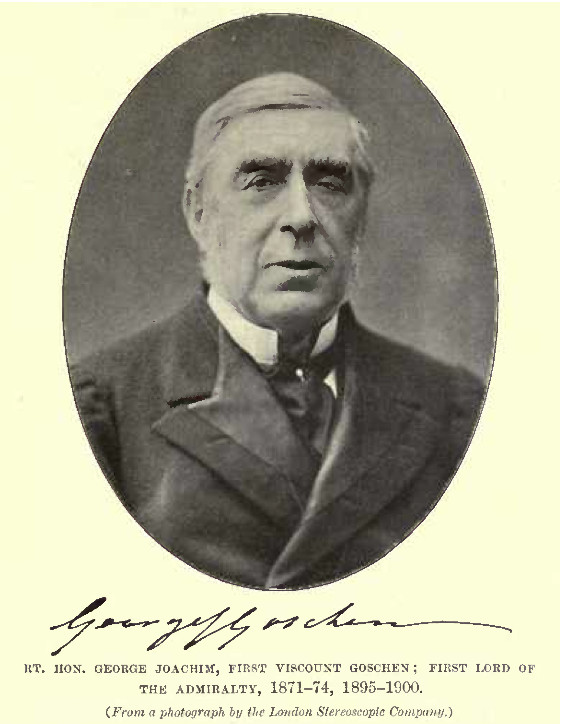
10 CIVIL HISTORY
OF THE ROYAL NAVY, 1857-1900.
The Order, however, besides effecting this reconstruction, restricted each Lord to the peculiar business assigned to him, and so rendered meetings of the Board almost unnecessary. An embarrassment of affairs resulted. It was sought to reduce this by creating temporarily a "Chief of the Staff," by establishing the Contract and Purchase Department, and by transferring the offices of the Civil Departments from Somerset House to Whitehall and Spring Gardens.
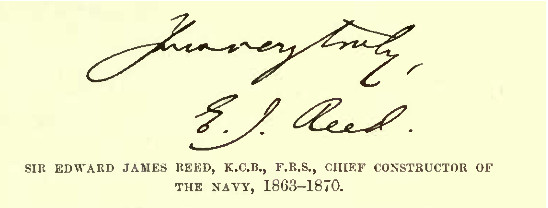
Under Mr. Goschen, a new Order in Council, of March 19th, 1872, made all the Lords directly responsible to the First Lord, appointed a Second Naval Lord, deprived the Controller of his seat, and added to the Board a Third, or Naval Secretary. But under Lord Northbrook, by Order in Council of March 10th, 1882, the Naval Secretary disappeared, the Permanent Secretary was revived, the Controller resumed his seat at the Board, and a non-parliamentary Civil Lord was given him as his assistant. This non-parliamentary Civil Lord (Mr. George Wightwick Rendel) disappeared in 1885; and, at about the same time, the Accountant-General of the Navy was ordered to act as deputy and assistant to the Parliamentary and Financial Secretary (O. in C. of Nov. 18, 1885).
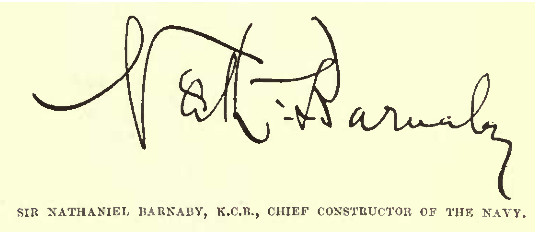
The Board as thereafter constituted consisted of:
The First Lord
(salary £4500, with house).
The First Sea Lord
(salary £1500, with house, and naval pay).
The Second Sea
Lord (salary £1200, with naval pay).
The Third Lord and
Controller (salary £1700, with naval pay).
The Junior Sea
Lord (salary £1200).
The Civil Lord
(salary £1000).
The Parliamentary
and Financial Secretary (salary £2000).
The Permanent Secretary (salary £2000).
CONSTITUTION OF
THE ADMIRALTY. 11
The manner in which the business of the Board
is divided, and the relationship of the various Lords and the
Parliamentary Secretary to the subsidiary departments, is shown
in the following table, which is adapted from Admiral Sir E.
Vesey Hamilton's useful volume on 'Naval Administration' (1896):
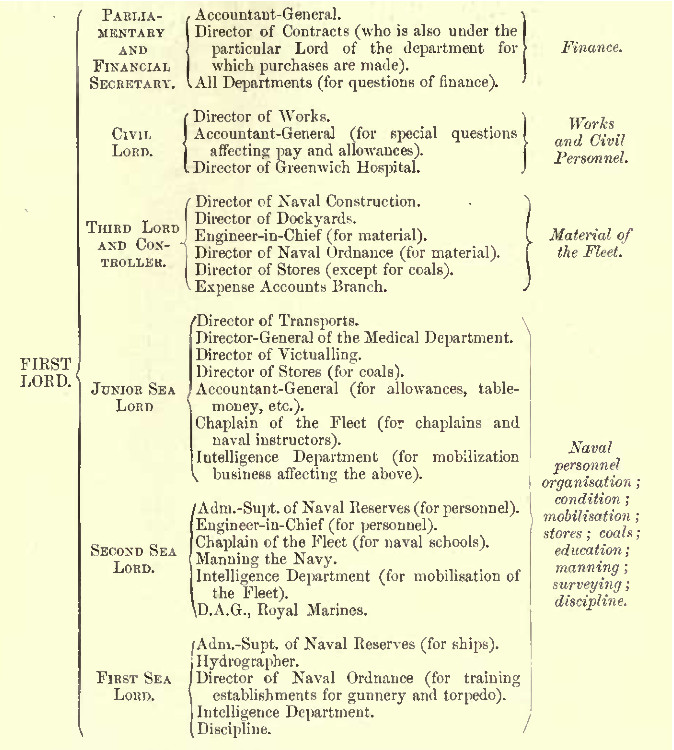
The business of the Permanent Secretary is to
superintend all correspondence in the name of the Board; to
prevent independent action by any department; to provide for the
transmission and execution of orders; and to keep unbroken the
administrative machinery of the Admiralty.
12
CIVIL HISTORY OF THE ROYAL NAVY, 1857-1900.
The sums voted for the service of the Navy, and the numbers of seamen and Royal Marines authorised to be borne each from 1856-57 to 1900-01 inclusive were:
STRENGTH OF THE
OFFICERS' LIST. 13
During the changeful and progressive period
under review, immense alterations, as might be expected, were
made in the constitution of the active list of officers. For
convenience of reference, the numbers of officers of the various
ranks, both active and retired, included in the official lists
for January, 1857, and January, 1901, respectively, are here
given side by side:
Although there was no Admiral of the Fleet at the beginning of 1857, the rank was in temporary abeyance only. Admiral of the Fleet Sir Thomas Byam Martin had died in October, 1854, leaving Admiral Thomas Le Marchant Gosselin at the head of the active list. Gosselin, though in the early part of his career he had been on full pay for twenty-nine years, had subsequently been on half-pay for no fewer than forty-five years in succession, and had never hoisted his flag. Moreover, he was eighty-nine years of age. He lived, nevertheless,
14 CIVIL
HISTORY OF THE ROYAL NAVY, 1857-1900.
until nearly the last days of 1857. Not until
then was the officer next on the list, Admiral Sir Charles Ogle,
Bart., promoted. Ogle had hoisted his flag more than once; and
his claim to promotion, when his turn came, could hardly have
been resisted. Nevertheless, be it noted, although Gosselin had
not been promoted, he had not been passed over. While he lived
he simply, as it were, blocked the way.
For many years after 1857 the flag-officer at
the top of the list of Admirals always received promotion as a
vacancy occurred; and in 1862 a second Admiral of the Fleet was
appointed, a third being added in 1863. Three remained the
extreme number until nearly the close of the century. In making
the appointments, provided that the officer next on the list had
served as a Commander-in-Chief, or had commanded at sea as a
flag-officer for two years, seniority was never ignored until,
in 1892, came the turn of Admiral Algernon Frederick Rous de
Horsey, who had been Commander-in-Chief in the Pacific for
nearly three years, and, in addition, had been senior officer in
the Channel for about five months.
On that occasion, her Majesty the Queen,
exercising her right of selection, saw fit to pass over de
Horsey, and to promote Sir John Edmund Commerell, whose name
stood next on the active list. Thenceforward seniority, subject
to the provisions above indicated, was not interfered with,
except in the case of H.R.H. the Duke of Edinburgh, 1
until 1898, when Sir Frederick William Richards 2
was promoted as a fourth Admiral of the Fleet, although, at the
time, he was not next on the list, but third on it. This
promotion, however, differed from that of Commerell in that it
was an extra one, and was not made to the permanent prejudice of
any other officers; for when, in 1899, the turn came of the
officer, Sir Nowell Salmon, who had all along stood first for
promotion (assuming an establishment of only three Admirals of
the Fleet), he was promoted.
It may be noted here that the rank of
Honorary Admiral of the Fleet was first created in 1887 in
favour of his present Majesty, then Prince of Wales, on the
occasion of Queen Victoria's Jubilee, and that his Majesty,
William II., German Emperor, was honoured with the like dignity
in 1889.
1
O. in C. of Nov. 23, 1893.
2 O. in C. of Nov. 29, 1898.
CHANGES IN
OFFICERS' RANK. 15
On July 9th, 1864, an Order in Council
discontinued the time-honoured classification which had
previously subdivided the various ranks of flag-officers into
those of the Red, the White, and the Blue Squadrons
respectively; and by an Admiralty circular of August 5th
following it was directed that, for the future, all
flag-officers should wear a white flag with a red Cross of St.
George therein, with, in the case of Vice-Admirals, one red
ball, and, in the case of Rear-Admirals, two red balls, in the
upper part, near the staff.
At the same time it was ordered that all
Commodores should wear a white broad-pennant, with a red St.
George's Cross therein; that all her Majesty's ships in
commission should fly the White Ensign; that the Blue Ensign
should be borne by vessels " n the service of any public
office," and by ships commanded by officers of the Royal Naval
Keserve, 1 and having
a fourth part of the crew composed of reserve men; and that the
Red Ensign should continue to be flown by all other British
vessels, with the exception of certain yachts, and craft
authorised to bear distinguishing flags.
An Order in Council of June 26, 1867,
transformed the then existing
Masters into
Navigating-Lieutenants;
the Second Masters
into Navigating-Sub-Lieutenants;
the Masters'
Assistants into Navigating-Midshipmen; and
the Naval Cadets,
2nd Class, into Navigating-Cadets.
The title of
Sub-Lieutenant was substituted for that of Mate in 1861.
The commissioned
ranks of Chief Gunner, Chief Boatswain, and Chief Carpenter were
created by an Admiralty Circular of July 25th, 1864.
It is impossible to say much here on the
large subject of naval retirement. The chief Orders in Council
which affected it during the period under review are those of:
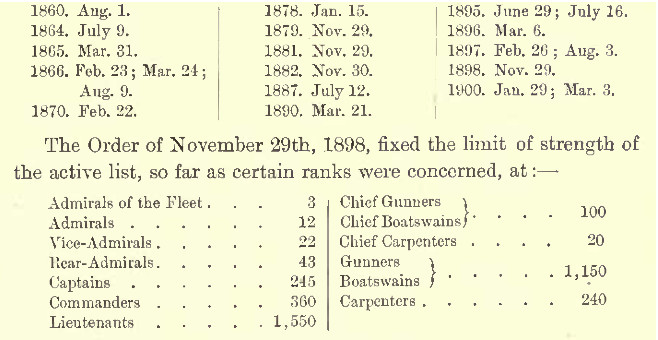
1
See also Circ. of Aug. 3, 1864.
16 CIVIL HISTORY
OF THE ROYAL NAVY, 1857-1900.
and made provision for the rate at which the
flag-officers', Captains', and Commanders' lists were to be
increased annually. In several of the ranks at the end of the
century (see Table on p. 13) the numbers fell far short of what
they then should have been.
Under the regulations which remained in force
at the end of 1900:
Admirals of the
Fleet were compulsorily retired at seventy;
Admirals,
at sixty-five (or seven years after last active service);
Vice-Admirals at
sixty-five (or seven years after last active service);
Rear-Admirals at
sixty (or seven years after last active service);
Captains at
fifty-five (or six years after last active service);
Commanders at
fifty (or five years after last active service);
Lieutenants at
forty-five (or four years after last active service);
Chief Inspectors
and Inspectors of Machinery at sixty (or seven years after last
active service);
Fleet Engineers,
Staff Engineers, and Chief Engineers at fifty-five (or five
years after last active service);
Engineers at
forty-five (or five years after last active service);
Assistant
Engineers at forty (or five years after last active service);
Chaplains and
Naval Instructors at sixty;
Inspectors-General,
and Deputy Inspectors-General of Hospitals at sixty;
Fleet Surgeons,
Staff Surgeons, and Surgeons at fifty-five; and
Fleet Paymasters,
Staff Paymasters and Paymasters at sixty.
All things considered, the pay of naval
officers underwent singularly little alteration during the
period. The good executive officer of 1857 was, relatively
speaking, little more scientific than his predecessor of 1805.
It was not necessary that he should know much about steam; the
gunnery requirements of the day were simple; and hydraulics,
electricity, Morse signalling, and torpedoes were unknown in the
service. On the other hand, it was required of the good
executive officer of 1900 that he should be not only a seaman
and a gunner, but also something of an engineer, something of a
physicist, something of a chemist, and much more.
Yet his emoluments were hardly increased in proportion. Still more modestly were the emoluments of the Accountant branch added to. The most notable advances were in the pay of officers of the purely and avowedly scientific branches, the engineering and the medical. It is impracticable to give here a full statement of all such changes as were made; but the full pay received by officers of a few typical ranks and standings in 1857 and 1900 respectively is shown in the appended table:
PAY AND WAGES. 17
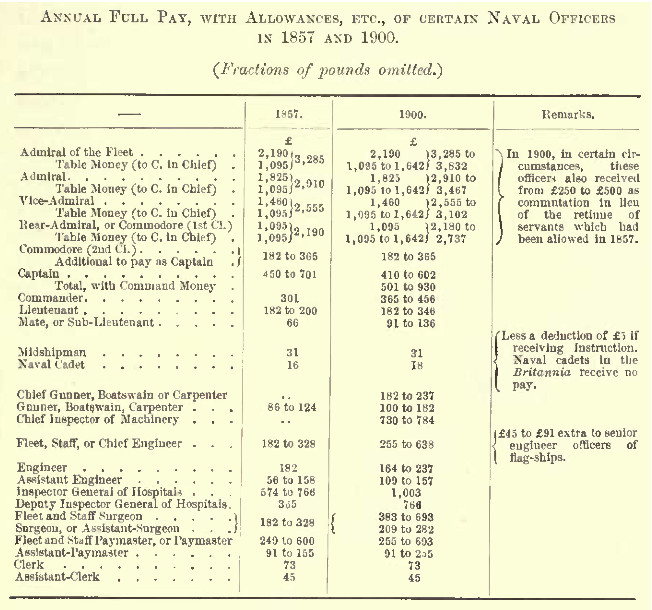
The continuous service
(annual) wages of Able Seamen (£28 17s. 11d.),
Ordinary Seamen (£22 16s. 3d.), and First Class Boys (£10 12s.
11d.), fixed in 1853, were not altered ere the end of the
century; but the introduction of extra pay for good conduct
badges, for re-engagement, etc., and the creation of numerous
new and specially paid ratings, gave the ambitious and capable
seaman many opportunities of increasing his wages from time to
time, and vastly ameliorated his financial prospects.
Up to 1859 the naval reserves of the country consisted of:
(a) Royal Marines
quartered ashore;
(b) the Coast
Guard, which in the previous year had been transferred from the
control of the Customs to that of the Admiralty;
(c) the Royal
Naval Coast Volunteers l;
and
(d) short service
pensioners.
In spite of the introduction of the
Continuous Service System, 2
in 1853, and of the entry of seamen for ten years,
considerable difficulty was still
experienced in manning the fleet. For example, the Diadem,
commissioned in August, 1857, could not complete her crew until
January, 1858; the Renown, commissioned in November 1 detained
by lack of men for 172 days, and then sailed 62 short of her
complement; and the Marlborough, commissioned in February 1858,
was similarly delayed for 129 days.
1
Raised 1853. They died out in 1873.
2
See Vol. VI. p. 207.
18 CIVIL HISTORY
OF THE ROYAL NAVY, 1857-1900.
To consider this unsatisfactory condition of
affairs, and to make recommendations for its amelioration, a
Royal Commission was appointed. It reported on February 19th,
1859, advocating among other things, the maintenance of at least
five large training-ships for the preparation of boys for the
Navy; the creation of larger reserves; the better training of
the reserves in gunnery; improvements in the comforts and
dietary of seamen; modifications in the system of the payment of
wages, and of allotments, etc., etc.
The first effect of the report was the issue,
on April 27th, 1859, of an Admiralty Order, which slightly
altered the scale of victualling 1;
authorised the supply to all boys and men on joining of bed,
blanket, and bedcover, free of charge; gave continuous service
men, on entering, and boys, on being rated as men a free part
kit, or money in lieu of it 2;
and promised the gratuitous supply to ships commissioning of
mess utensils, so soon as suitable ones be found.
Other results which followed were the increase of the Marines, and of the Coast Guard, the introduction of training-ships for boys, and the establishment of a corps of Royal Naval Volunteers, a force which ultimately developed into the Royal Naval Reserve, the earliest commissions to which, as such, were dated in February, 1862. Various regulations for the officers this corps were subsequently embodied in Orders in Council dated respectively March 1st, 1864, October 15th, 1872, June 28th, 1 and May 3rd, 1882. These were consolidated and revised by an Order of June 26th, 1886, which was further modified by Orders of February 7th, 1888, July 23rd, 1889, February 23rd, 1891, March 20th 1891, May 9th, 1892, and May 16th, 1893. The whole regulations were again consolidated and revised in 1896; when the number of officers was fixed at 1800.
1.
Allowance of biscuit per man per diem increased from 1 lb to 1
1/4 ib, but savings' price per pound reduced from 2d to 1 1/2
d. Allowance of sugar per man per diem increased from 1 3/4
ozs. to 2 ozs. Extra allowance in middle or morning watch at
Captain's discretion, of 1/2 oz. of sugar and 1/2 oz of
chocolate to men sick or specially exposed.
NAVAL RESERVES.
19
A new force, the Royal Fleet Reserve, designed to consist of seamen and Royal Marines who have been discharged with or without pensions, and eventually to supersede the old seamen pensioner reserve, was planned and decided upon in 1900 but no men were entered until later. In the same year also two important steps were taken towards the creation of additional and more efficient naval reserve forces in her Majesty's dominions beyond the seas. New Zealand initiated the discussion among the Australasian colonies of a project for the establishment of reserves both military and naval; and fifty Newfoundland fishermen belonging to the naval reserve of the island were embarked in H.M.S. Charybdis, Captain George Augustus Giffard, for a six months' training cruise in the West Indies. Concerning the ordinary naval resources of the colonies a few words will be said later. 1
For nearly twenty years, towards the end of
the century, yet another naval reserve existed in the shape of
the Royal Naval Artillery Volunteers, which were raised under an
Act of August 5th, 1873. 2
This body was intended to provide trained gunners for service
within the home seas, and consisted for the most part of
yacht-owners and professional men of good social standing. Its
headquarters and drill-ship (first the Rainbow, and later the
Frolic) was moored in the Thames, off Somerset House. Owing to
regrettable misunderstandings, frictions and jealousies, the
corps was disbanded on April 1st, 1892. A few months before that
date it had included 66 officers and 1849 men. 3
1
See p. 77 and note.
2
Modified in 1882 by the National Defence Act.
3
Report of Sir G. Tryon's Committee, Apr. 7, 1891.
20 CIVIL HISTORY
OF THE ROYAL NAVY, 1857-1900.
THE FIRST
IRONCLADS
For several years after 1856 the construction of wooden men-of-war, 1 of all classes, continued. The lessons of Kinburn, indeed, seemed to produce in England no tangible results whatsoever until the spring of 1859, when the first British sea-going armoured iron ship, the Warrior, was laid down at Blackwall. The armoured wooden floating batteries of the Trusty class, and the armoured iron floating batteries of the Erebus class, 2 built in 1854-56, remained, up to the Warrior's launch in December, 1860, the only ironclads belonging to her Majesty's fleet. Progress was at length forced upon the country by the action of France, which, suspending the completion of the original designs of four large and fast wooden screw ships which she had upon the stocks at Brest and Toulon, had begun to armour them, and to convert them from 90-gun vessels of the line to 36-gun frigates. One of these, the Gloire, was actually launched in November, 1859.
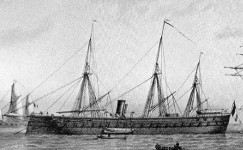 FS Gloire |
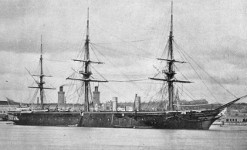 HMS Warrior (Cyber-Heritage) |
Great Britain also adapted as ironclads a certain number of fine wooden ships which were available for the purpose at the time when it became evident that the armoured vessel must be the battleship of the future. These adapted ships were the following:
 HMS Ocean (Wikipedia) |
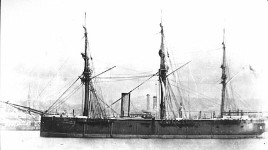 HMS Royal Alfred |
Royal
Oak, Caledonia, Prince Consort, and
Ocean, originally designed and begun as wooden
line-of-battleships of 91 guns, 3716 tons (old measurement), and
800 H.P. nom., but converted, in accordance with an Admiralty
Order of May 14, 1861, to armour-plated ships of about 6400 tons
displacement, and from 3700 to 4240 H.P.I. As adapted, they were
full-rigged broadside ships, with iron armour of a maximum
thickness of 4.5 inches, carrying 24 6.5-ton 7-in.
muzzle-loaders. They had single screws, and an extreme speed of
from 12 to 13 knots. All were launched in 1862 and 1863.
Royal Alfred, originally designed and begun as a wooden line-of-battle ship of 91 guns, 3716 tons (old measurement), and 800 H.P. nom., but converted, in accordance with an Admiralty Order of June 5, 1861, to an armour-plated ship of 6720 tons' displacement, and 3434 H.P.I. As adapted, she was a full-rigged broadside ship, with iron armour of a maximum thickness of 6 inches, carrying 18 6.5-ton 7-in. muzzle-loaders. She had a single screw, and a speed of 12.3 knots, and was launched in 1864.
1
This sketch of the progress of Naval Architecture during the
years 1857-1900 is mainly based upon the following
authorities: King, 'The Warships of Europe' (1878); Very,
'Navies of the World' (1880); Heed, 'Our Ironclad Ships'
(1869); Brassey, 'The British Navy' (1882-83); White, 'A
Manual of Naval Architecture' (1882); The Catalogue of the
Museum at Greenwich, and the Collection of Ship Models
there; Brassey, 'The Naval Annual' (1886-1901); Clowes, 'The
Naval Pocket Book' (1896, etc.); Lloyd's 'Warships of the
World' (annually); Busk, 'The Navies of the World ' (1859);
Armstrong, 'Torpedoes and Torpedo Vessels' (1896); Williams,
'The Steam Navy of England' (1893); and numerous articles
and papers, especially in the Transactions of the
Institution of Naval Architects; The Year's Naval Progress
(Washington); the Journal of the Royal United Service
Institution; the Proceedings of the United States' Naval
Institute (Annapolis); the Engineer; and Engineering.
2 See Vol. vi., p. 198.
THE FIRST
IRONCLADS. 21
 HMS Repulse |
HMS Favorite
|
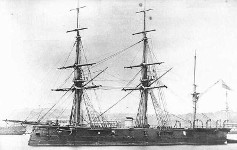 HMS Research |
Repulse,
originally designed and begun as a wooden line-of-battle ship of
90 guns, 3074 tons (old measurement), and 800 H.P. nom., but
converted, in accordance with an Admiralty Order of October 9,
1866, to an armour-plated ship of 6190 tons' displacement, and
3350 H.P.I. As adapted, she was a full-rigged broadside ship,
with iron armour of a maximum thickness of 6 inches, carrying 12
8-in. 9-ton (but later 10 9-in. 12-ton) muzzle-loaders. She had
a single screw, and a speed of about 12 knots, and was launched
in 1868.
Favorite,
originally designed and begun as a wooden corvette of 22 guns,
but converted, according to designs by Mr. E. J. Reed and the
Controller's Department, in 1862, to a rigged, armour-plated
corvette of 3169 tons' displacement, and 1773 H.P.I., with iron
armour of a maximum thickness of 4.5 inches, carrying 10 8-in.
9-ton muzzle-loaders. She had a single screw, and a speed of
11.8 knots, and was launched in 1864.
Research,
designed and begun as a wooden 17-gun sloop in 1861, but
converted in 1862 to an armoured, rigged vessel, and launched in
1863. Displacement, 1680 tons; speed 10.3 knots; thickest armour
4.5 inches; 4 7-in. 6.5-ton muzzle-loaders.
The above, as converted, differed outwardly
in no essential respects from their immediate predecessors, the
wooden screw battleships and frigates. They were still fine
specimens of the old picturesque style of naval architecture,
and were fairly good craft under sail.
The only other wooden ship, the Royal Sovereign, which was converted to an ironclad for the British Navy received very different treatment. She was cut down, armoured all over, supplied merely with three light pole masts, and furnished with four armoured revolving turrets, which were placed on the upper deck in the middle line of the ship. Although herself of little practical use, she was a most important and significant craft, in that she embodied the first British admission of two novel principles which, many years afterwards, obtained universal acceptance; viz., that sail-power had ceased to be useful in vessels intended for heavy fighting; and that the main armament of every ship intended for heavy fighting should be protected as completely as possible, and should moreover be so mounted as to have as near an approach as might be to all-round fire. In addition, possessing a relatively low freeboard, the converted Royal Sovereign had the advantage. of offering but a proportionately small target to an enemy. These features were all due to the advocacy of Captain Cowper Phipps Coles, R.N., C.B.
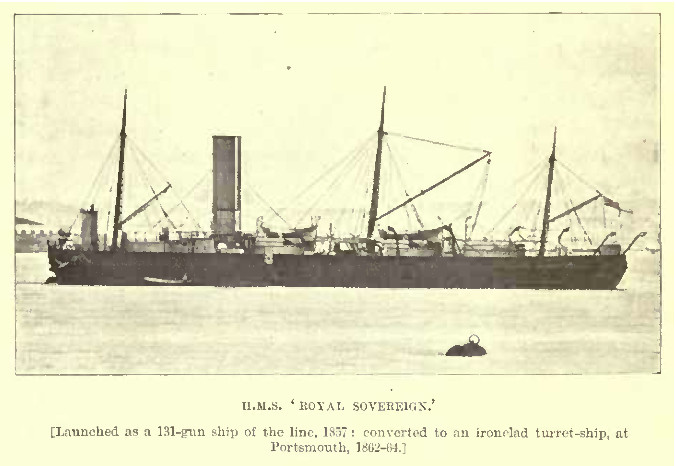
Royal Sovereign, originally launched in 1857 as a wooden line-of-battle ship of 131 guns, 3765 tons (old measurement), and 800 H.P. nom., was converted, in accordance with an Admiralty Order of April 3rd, 1862, to an armoured turret-ship of 4965 tons' displacement, and 800 H.P. nom. As adapted, she had iron armour of a maximum thickness of 5.5 inches, and carried 5 9-in. 12-ton muzzle-loaders, one in each of her three aftermost turrets, and two in the foremost one. She had a single screw, and a speed of 11 knots, and was undocked in 1864.
22 CIVIL HISTORY OF THE ROYAL NAVY, 1857-1900.
It has been said that the iron-hulled armoured ship Warrior was laid down in the spring of 1859; yet it should be added here that, for several years later, the Admiralty seemed unable to make up its mind whether, after all, iron was or was not to be the building material of future heavy fighting ships. In that period of apparent doubt and hesitation it caused both iron-hulled and wooden-hulled armoured ships to be constructed. The wooden-hulled ones are briefly noted below:
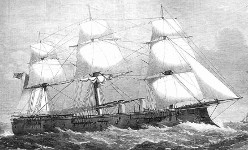 HMS Lord Clyde |
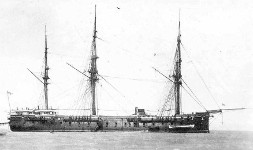 HMS Zealous |
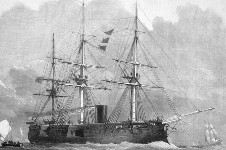 HMS Pallas |
Lord
Clyde and Lord
Warden, laid down in 1863, after designs by Mr. E. J.
Reed, and the Controller's Department, as single-screw,
wooden-hulled, armoured broadside ships of 7602 and 7839 tons'
displacement, and 6034 and 6706 H.P.I, respectively; each fully
rigged, and ultimately carrying 18 6-ton 7-in. muzzle-loaders.
Speed, about 13.5 knots. Launched respectively in 1864 and 1865.
Maximum thickness of iron armour 5 inches.
Zealous, laid down in October, 1859, after designs by the same, as a single-screw, wooden-hulled, armoured, broadside ship of 6102 tons' displacement, and 3623 H.P.I.; rigged; and ultimately carrying 20 6.5-ton 7-in. muzzle-loaders. Speed, 11.7 knots. Launched in 1864. Maximum thickness of iron armour, 4.5 inches.
IRON AS A
BU1LDING MATERIAL. 23
Pallas
(laid down 1863, launched 1865), a single-screw, wooden-hulled,
rigged, armoured, broadside corvette, designed by Mr. E. J.
Reed, and the Controller's Department. Displacement, 3661 tons;
H.P.I., 3581; speed 13 knots; maximum thickness of armour 4.5
inches; ultimate armament, 8 8-in. 9-ton muzzle-loaders.
Enterprise,
laid down in 1862, after designs by the same, as a single-screw,
wooden-hulled, rigged, armoured sloop of 993 tons' displacement,
and 9.9 knots' speed, carrying 4 7-in. 6.5 ton guns. Launched in
1864. Maximum thickness of iron armour, 4.5 inches. In this
case, although the hull was of wood the upper works were of iron
(composite construction).
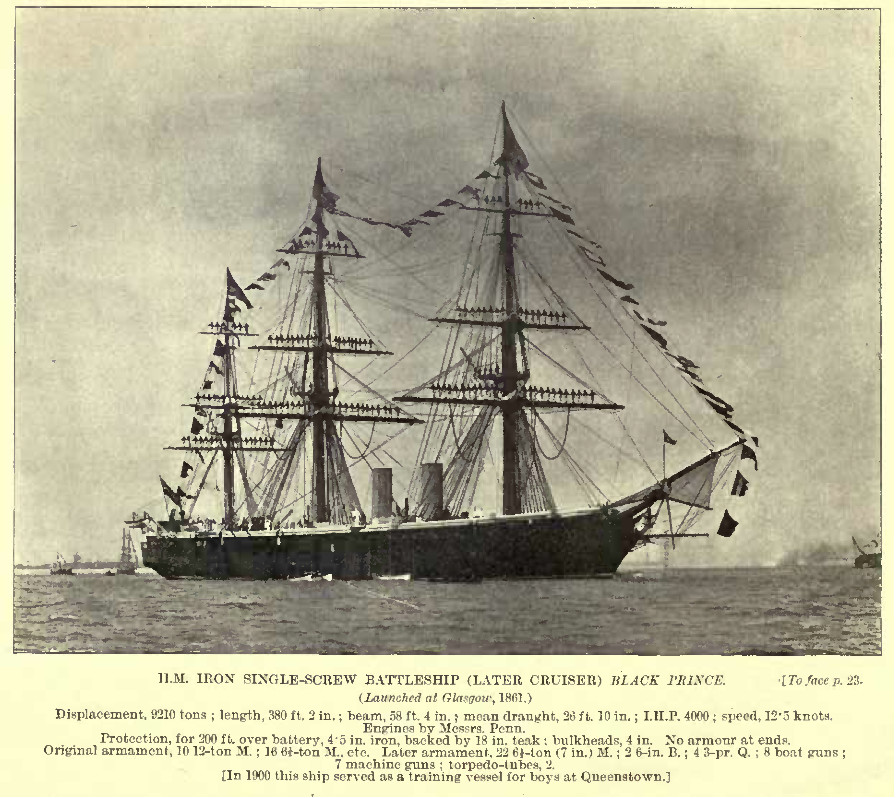
HMS Black Prince, sister-ship to HMS Warrior
Thus, from 1859 until 1866, the Admiralty still thought it worth while either to build wooden ironclads or to armour existing wooden hulls. From 1866, however, that idea was definitely abandoned, the Order for the conversion of the Repulse being the final symptom of official hesitation.
The rise of
the iron-built, sea-going ironclad, and its development may
now be studied without further interruption.
At first the traditions of the old wooden
navy greatly influenced the designs of all new fighting-ships,
and vessels continued to be built not only with heavy rigging
and large sail-power, but also with their guns disposed, as
previously, in broadside along the major parts of their length.
The armoured ships, arranged in order of their launch, which
were constructed on this principle were:
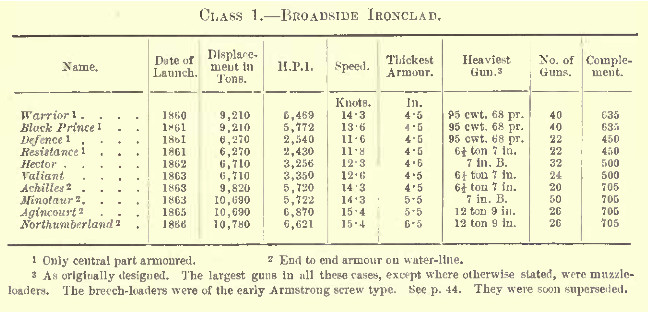
24 CIVIL HISTORY
OF THE ROYAL NAVY, 1857-1900.
The next
developments which were generally adopted were
the confinement of the heavy armament of the ironclad vessel
to a central battery, where it was mounted behind
comparatively thick iron armour, and shut off fore and aft by
armoured bulkheads; and the restriction of armour elsewhere to
the neighbourhood of the water-line. The ships of this class, as
successively launched, are catalogued below. All were, as
before, heavily rigged; and, as regards general appearance, the
old lines were preserved, except that the ram bow, 1
which was not introduced in some of the earliest ironclads, and
which was adopted largely in consequence of the advocacy of
Admiral Sir George Kose Sartorius, had become a regular feature.

Each of the above had a complete water-line belt, with good protection over the central battery. The Alexandra was the earliest of the above to be provided with a substantial deck of steel in the neighbourhood of the water-line; but it was not curved below the water-line at its edges, and was not so arranged as to deflect upwards any projectiles that might enter the vessel near the line of flotation, and thus to protect the machinery. In her case this deck was two inches thick. It was mainly designed as a protection against plunging fire. Save for this belt, the entire hull of the Alexandra, as of the other craft in the list, was of iron, neither compound armour nor steel as a building material having yet come into use.
1 The popular and exaggerated estimate of the value of this (the ram) was greatly increased in 1875, when, on Sept. 2, the Iron Duke, in a fog off Wicklow, accidentally rammed her sister ship, the Vanguard, which sank within an hour. As a matter of fact, the ram has proved to be more dangerous in accident than formidable in action. See Author's Lecture at R.U.S.I., Jan. 19, 1894.
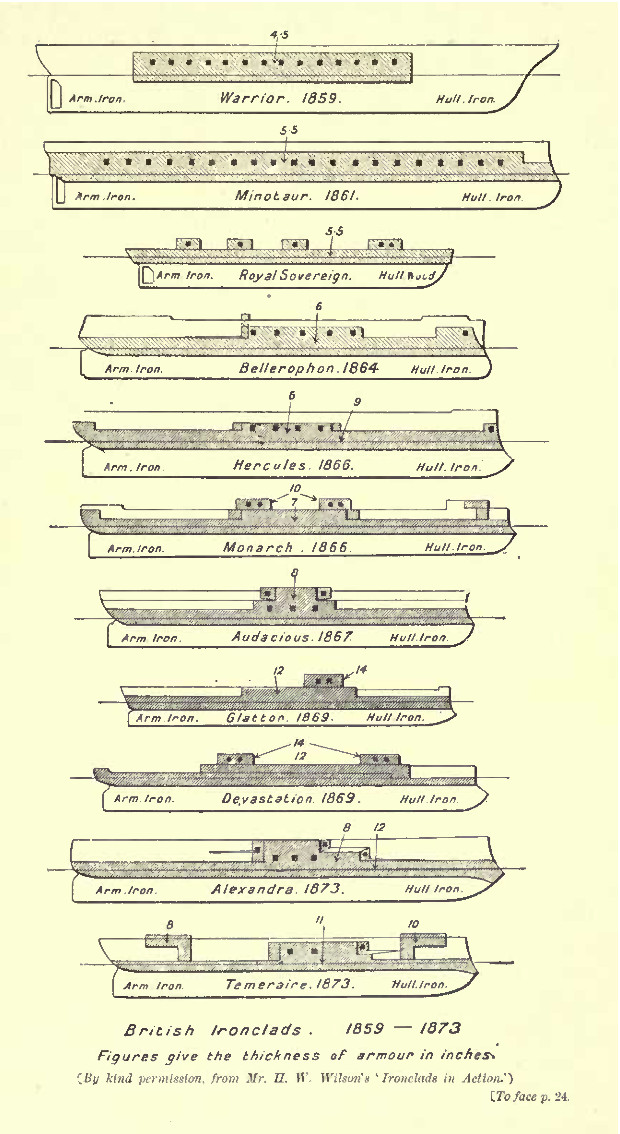
EXPERIMENTAL
TYPES OF FIGHTING SHIPS. 25
Although, for the six years after 1859 the
broadside-rigged iron-clad, and for the ten or twelve years
after 1865 the central-battery rigged ironclad met, upon the
whole, with most favour at the Admiralty, it must not be
supposed that these types of heavy fighting ships were ever
without competitors. Captain Cowper Phipps Coles, who had been
mainly responsible for the cutting down and conversion of the
Royal Sovereign in 1862-64, was still a living and very active
advocate of the turret principle; and Mr. E. J. Eeed, who was
Chief Constructor from 1863 to 1870, while disagreeing with
Captain Coles on most points of detail, realised that the plan
of giving the maximum protection and the maximum arc of fire to
an armoured ship's heaviest guns was one which deserved the most
favourable consideration. Moreover, the battle of Hampton Koads,
in March, 1862, and numerous other actions during the Civil War
in America, demonstrated that, for work of certain kinds, the
monitor, or turret-ship, was a most useful and formidable craft.
Other ideas, also, were abroad as to the best
methods of compromising the claims of the various new factors
which, as time went on, seemed to demand inclusion in the ideal
fighting ship, yet which, it was amply evident, could not all
receive equal consideration. Very heavy guns were called for by
some; very thick armour was considered indispensable by others;
and while one party asked for a complete water-line belt,
another party urged the naval architects to devote even more
attention to the protection of the armament than to the
protection of the life of the ship. Yet other conflicting and
almost irreconcilable claims were put forward on behalf of high
speed, of great coal-capacity, of large sail-power, of lofty
free- board, of seaworthiness and steadiness of gun-platform,
and of small size, shallow draught, and comparative invisibility
to an enemy's gunners.
For
nearly twenty years these and other problems troubled the
minds of naval architects all the world over. In Great
Britain they led to the construction of numerous armoured ships
which are catalogued below. Some of them were not sea-going;
others, though sea-going, were scarcely fit, even in their best
days, for the line-of-battle; but they are all included, for the
reason that each one may be deemed to have contributed
something, if only a little, either to the development of that
type of heavy fighting ship which was generally acknowledged to
be the best at the end of the nineteenth century, or to the
establishment of certain doctrines which began to be accepted
about the years 1870-74, and which led later to the subdivision
of all new vertically-armoured warships into three definite
groups, viz., battleships, armoured cruisers, and coast-defence
ironclads.
26 CIVIL HISTORY OF THE ROYAL NAVY, 1857-1900.
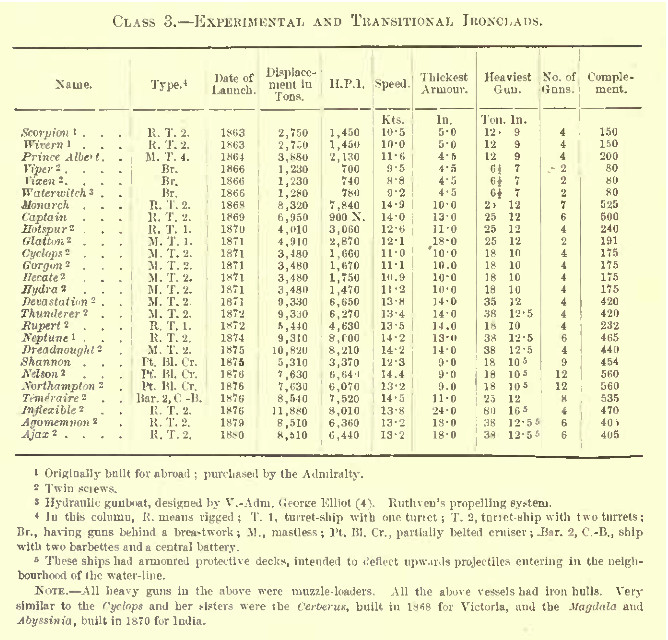
The most interesting and significant ships in
the above list were the Monarch, the Captain, the Devastation
(with her two kindred ships, Thunderer and Dreadnought), the
Shannon, the Temeraire, and the Inflexible (with her smaller
cousins, Agamemnon and Ajax). It has been already pointed out
that in the ten or twelve years after 1865 the central-battery
rigged ironclad (class 2 above) met upon the whole with most
favour at the Admiralty as the best type of heavy fighting-ship.
The vessels in class 3
may be regarded as experiments in the direction of finding a yet
better type.
SEA-GOING TURRET SHIPS. 27
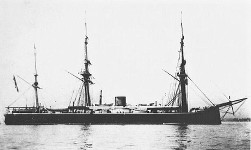 HMS Monarch |
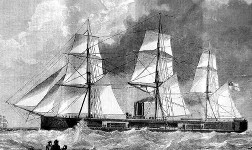 HMS Captain |
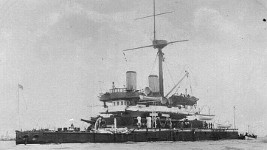 HMS Devastation |
The Monarch,
designed under the direction of Mr. E. J. Eeed, embodied an
attempt to combine the advantages of a high-freeboard masted
ship with those of a turret vessel. In addition to her four
heaviest guns in the two turrets, she carried somewhat lighter
weapons under her raised poop and forecastle; and in that
respect she differed from previous British turret ships, each of
which had carried the whole of her heavy armament in the
turrets. It was a gain, of course, to be able thus to carry six
or seven guns instead of only four. On the other hand, the
raised poop and forecastle masked part of the fire from the
turrets, and so limited the usefulness of the powerful and
well-protected guns there. This defect constituted the Monarch's
great drawback. Her freeboard of 14 ft. made her a useful ship
at sea.
The Captain,
designed by Captain Cowper Phipps Coles, R.N.,C.B., assisted by
Messrs. Laird, of Birkenhead, was the production of an amateur.
Coles was strongly opposed to the high freeboard, which formed
one of the leading features of the Monarch. He desired a low
freeboard turret-ship, in order that she might present as small
a target as possible to the enemy. Curiously enough, however, he
reverted to masts and sails, and rigged his vessel heavily. Even
with her intended freeboard of 8 ft. 6 in., she would have been
unsafe in a heavy sea unless very carefully handled; but
unfortunately, owing to errors on the part of her designer, her
actual freeboard was but 6 ft. 8 in.
After having made
two cruises in the Channel, and having, by her behaviour, caused
some of her bitterest opponents to modify their opinion of her,
she sailed again with the Channel Fleet under Admiral Sir
Alexander Milne, K.C.B.; and, on the night of September 6th,
1870, during a south-westerly gale, she capsized in a fierce
squall, and went to the bottom, carrying with her the whole of
those on board except eighteen persons. The number of souls who
perished was 475, among them being her commander, Captain Hugh
Talbot Burgoyne, V.C., and her misguided designer, Captain
Coles. 1 This terrible
catastrophe condemned for ever the low freeboard rigged
turret-ship.
The Devastation,
and her successors, the very similar Thunderer and Dreadnought
(all of which were closely allied to the smaller non-seagoing
ironclads, Glatton, Cyclops, Gorgon, Hecate, and Hydra),
forestalled rather than profited by the dreadful lesson taught
by the fate of the Captain, for the Devastation was laid down
ten months before the disaster. The type was designed by Mr. E.
J. Reed, C.B. In it masts and sails were frankly and completely
abandoned, the result being the creation of some most successful
and safe low freeboard turret-ships. But in one respect the new
vessels were inferior to the Monarch. Though they possessed
all-round fire, they mounted only four heavy guns apiece, and
had no secondary armament whatsoever.
1
Proc. of C. M.: Parl. Paper 1871, 42.
28 CIVIL HISTORY OF THE ROYAL NAVY, 1857-1900.
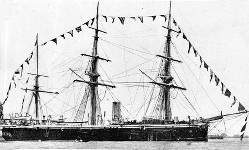 HMS Shannon, armoured cruiser |
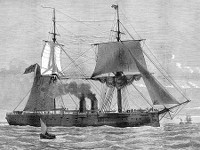 HMS Temeraire |
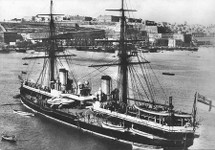 HMS Inflexible |
The Shannon,
with her larger but similar successors, the Nelson and the
Northampton, is interesting for more than one reason; although
the type was not a very successful one. The Shannon was not a
battleship, but she was intended to combine some of the features
of the battleship with those of the cruiser, and she was
specially designed for fighting bows on. Abaft her foremast,
therefore, she had a respectably thick armoured bulkhead with
recessed ports. Forward of this, there was no vertical armour;
but there was an under-water steel protective deck, curving
downwards towards the ram, and shielding the ship's vitals.
Abaft the bulkhead, as far as the stern, ran a water-line belt
of vertical armour, the lower edge of which touched the lower
edge of the protective deck; but, except the forward bulkhead,
there was no protection for the men at the guns, so that the
vessel, if regarded broadside on, might be called a partially
belted cruiser, while, if regarded bows on, she resembled a
central-battery battleship with an unarmoured bow. The
protective deck, as employed in the Shannon, was built into
nearly all subsequent British ironclads, and into all large
cruisers, whether armoured or not.
The Temeraire
marked a great advance, and embodied more than one
valuable new feature, though she was without the protective
deck, and had merely thin horizontal above-water plating to keep
out light plunging fire. Near each end of the ship, above the
upper deck, rose an armoured barbette, or open non-revolving
turret; and in each of these was a heavy gun, which fired over
the edge of the barbette and had a very wide command. The guns
in this case were so arranged as to disappear behind the
protection after their discharge, and to be revolved, and again
brought up to the firing position by hydraulic power.
Between these two
barbettes, with its guns on a lower level, was an armoured
central-battery, mounting six heavy pieces; and lower down,
along the entire length of the ship, was a water-line belt of
thick vertical armour. In this type, the biggest guns of all
were in two barbettes on the upper deck, above the keel-line of
the ship; and a strong secondary armament was in an armoured
box-battery between them. The design, due to Mr. Nathaniel
Barnaby, had in it the germ of ideas which a few years later,
entered into the normal and accepted battleship types of Great
Britain, the United States, Germany, Italy, and Russia, and to
some extent of France also.
THE FORCES OF
EVOLUTION. 29
The Inflexible
and her kindred were set-backs. Each of them had two very
heavily armoured turrets, placed close together diagonally
across the upper deck; and in each turret each had two very
heavy guns. Under and around the turrets, from the deck to below
the water-line, was a thickly armoured rectangular citadel,
forming the central third of the ship, but elsewhere there was
neither vertical armour nor, in the case of the Inflexible,
heavy gun of any sort. The only armoured protection to the long
ends of the ships were steel 3-in. decks, and it was generally
supposed that if one of the unarmoured ends of any of these
vessels were much injured by shot or otherwise in the
neighbourhood of the water-line, the result would be fatal. It
was an extreme instance of taking care of the gun at the expense
of the ship.
At about the time when these last vessels
were in process of construction several significant and
revolutionary facts forced themselves before the attention of
the naval architect:
a. Not only the
automobile torpedo, but also the fast torpedo-boat, had brought
forward factors which could not be neglected. Provision must be
made for defence against them, and also for their due
utilisation.
b. The development
of the power of the heavy gun had rendered the old iron armour
almost useless. If, as in the case of the Agamemnon, 1
it were piled on in some places to a thickness of 18 inches, it
would, it was true, defeat all save the very largest guns, but,
at the same time, it could be carried only on a very small
proportion of the total exposed surface. An armour giving equal
or more resistance with less thickness and weight must be sought
for.
c.
Steel had become available as a building material, and was
about to supersede iron entirely for that purpose.
d. The slowness of
fire of heavy muzzle-loading guns, even when worked
hydraulically, and their other disadvantages, taken in
conjunction with the general
adoption of breechloaders by foreign nations, had long
since called for a change in the armament of British warships.
e. The invention of slow-burning powders for heavy guns, destined to give high velocities to their projectiles, demanded the use of a much longer barrel than could be given to any ship's muzzle-loader; which had necessarily to be sponged and loaded from the forward end, and to be run in-board for that purpose. Therefore, unless high velocities as well as quickness of fire were to be dispensed with, long breechloading guns must be mounted. Long guns, which did not require to be run in, could easily be fought from positions whence even much shorter and vastly inferior guns, if muzzle- loaders, could not be fought at all.
1
Some of the Inflexible's armour was compound.
30 CIVIL HISTORY
OF THE ROYAL NAVY, 1857-1900.
f. The appearance
of the quick-firing gun, and of machine-guns, indicated that it
was time to devote attention to the secondary and subsidiary as
well as to the primary armaments of new ships. The ideal
fighting craft could no longer afford to mount two, four, or six
very heavy guns, and little or nothing else. She must be able to
meet quick-firing gun with quick-firing gun, and machine-gun
with machine-gun, or risk finding herself at the mercy of an
opponent perhaps far smaller than herself. If heavy armour was
necessary to keep out heavy projectiles, light armour was
equally necessary to keep out light ones.
g. Marine engines
and boilers had been immensely improved; and the importance of
speed was becoming clearer daily, from the point of view not
only of tactics but also of strategy. It was obviously not
sufficient that Great Britain's fastest armoured ship should
have a paper speed of only 14.9 knots, and an actual continuous
steaming speed of at least two knots less. Great radius of
action, meaning great bunker capacity, was another desideratum,
if fast vessels were to maintain their speed over long
distances, and so derive full advantage from it.
h. Finally, apart
from many other considerations, masts and yards had ceased to be
useful in heavy fighting ships. They would be sources of danger
in action, especially when exposed to the effect of quick-firing
guns; and besides involving weight to be carried, they involved
weight to be carried in the most inconvenient position. They
also afforded great resistance to the course of a vessel
steaming against a wind. Ships of the Devastation type had
proved that they could dispense with them. At the same time, if
only for signalling and look-out purposes, masts of some sort
were desirable; and if machine-guns could be mounted in their
tops, perhaps so much the better.
The result was the construction in England of a certain number of heavy fighting ships of what may be called tentative types. The time had come when the nature of most of the problems needing solution was recognised, and when it was known what desirable features presented themselves for inclusion in that all-round compromise which, unfortunately, even the finest and largest battleship stands for. The upshot of the work done in this tentative period was:
(a) the
realisation of the fact that many
ironclads of earlier dates
had ceased to be useful save for coast-defence or
guardship purposes, although they had been built originally for
sea-service, and
(b) the appearance
of the fast armoured cruiser as a vessel distinct from
the battleship, yet capable, perhaps, of doing some of her work.
TRANSITIONAL
TYPES OF FIGHTING SHIPS. 31
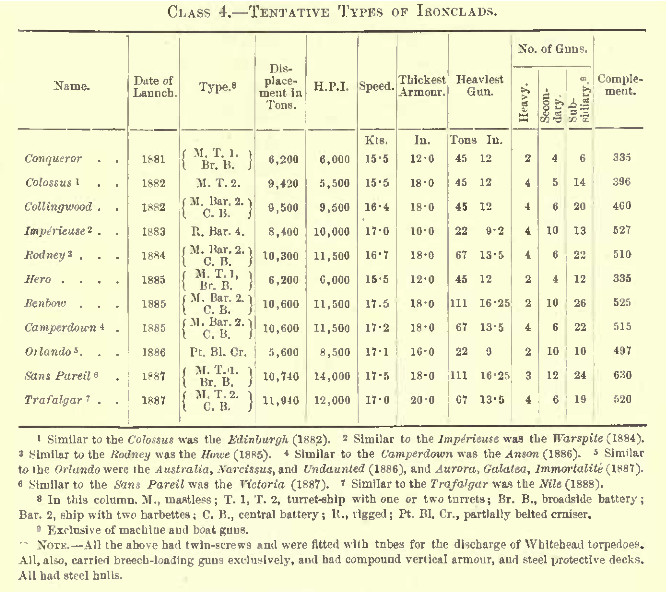
The above vessels, especially so far as the
battleships among them are concerned, represent the efforts of
the designers not only to protect the vitals of the ship and the
primary armament as well as possible, but also to provide a
respectable secondary armament, and to mount it in the best part
of the ship. The Conqueror and Sans Pareil show a tendency in
one direction. In them, as in the Shannon, of Class 3, the plans
were based chiefly upon the assumption that the vessels would do
their main fighting bows on to the foe. Both the heavy armour,
therefore, and the heavy armament were put forward; the
protection of the aftermost compartments was left to the
armoured deck; and the stern fire was relatively weak. The Hero
was to all intents and purposes a replica of the Conqueror,
except that she carried her secondary armament, of 6-inch guns,
on her upper instead of on her main deck. The type soon fell
into disfavour.
32 CIVIL HISTORY
OF THE ROYAL NAVY, 1857-1900.
The Colossus (sister-ship
HMS Edinburgh below) embodied a development of the
Inflexible and Agamemnon types of Class 3, the diagonal
arrangement of turrets being retained, but an effort also being
made to provide in a satisfactory manner for a fairly powerful
secondary battery. The attempt was not very successful; and no
further experiments were made along those lines. The type is one
which died out quickly.
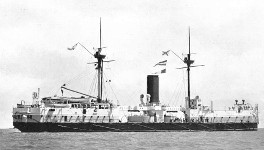 HMS Edinburgh (Cyber-Heritage) |
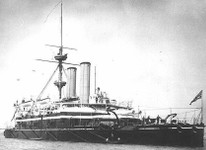 HMS Collingwood |
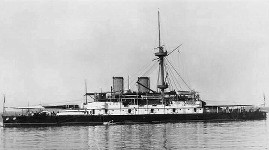 HMS Benbow |
The Collingwood, the earliest of the
"Admiral" type of battleships, was similar in general
arrangement to the Rodney, Benbow, and Camperdown, which
followed her, and, to some extent also, to the Trafalgar. She
may be regarded as a development of the Temeraire type, in Class
3, the Temeraire herself being a kind of compromise between the
central-battery ships of Class 2 and the sea-going monitors of
Mr. E. J. Reed's design, such as the Devastation. It was no
longer assumed by the constructors that the ship would be called
upon to do her hardest fighting bows on to the enemy.
On the contrary, it was sought to give the
ship, so far as it could be managed, equal offensive strength in
all directions. With this aim in view, the primary armament was
equally divided, and placed half at one end and half at the
other end of the ship in barbettes or turrets, where it could
fire both parallel with and at right angles to the keel-line of
the vessel; and the secondary armament, half on each broadside,
in a battery occupying the middle space on deck between the
barbettes or turrets, was so arranged that all the guns on each
side had a wide arc of fire, while the end guns those at each
corner of the central battery could also fire in a direction
nearly parallel with the keel-line.
This type of battleship found favour at once.
The earliest exponents of it had too little water-line
protection. For example, the Collingwood, though 325 feet long,
had only 150 feet of that length protected with vertical armour.
Again, the earliest exponents of the type had no armour
whatsoever to cover the men at the guns in the central battery.
Improvements were presently made in the direction of lengthening
the armoured belt; armouring the central battery; dividing off
the guns in the central battery by means of screens, or by
placing them singly in armoured casemates; sponsoning out the
broadside guns, so as to give them a still wider radius of fire;
giving the ships higher freeboard, and raising the height above
water of the primary armament; and, in cases where turrets were
not used, covering the breech-ends of the barbette guns with
armoured hoods which revolved with them. The outcome of these
and other improvements was the standard type of British
battleship, which held its position almost unchallenged during
the last twelve years of the nineteenth century, although, of
course, it still continued to be improved in detail year after
year.
THE STANDARD TYPE
OF BATTLESHIP. 33
Of the two types of armoured cruisers in
Class 4, the earlier, the Imperieuse type, though it proved
itself useful, developed no further. The later, the Orlando
type, had an arrangement of its primary and secondary armaments
similar to that which formed the peculiar feature of the
Collingwood and her successors. For some years after the
building of the Orlando and her consorts,
the construction of armoured cruisers was neglected in England;
but when it was resumed, in 1897, the standard type selected
bore a strong resemblance, so far as disposition of armament was
concerned, both to the Collingwood and to the Orlando.
It now remains to complete the list of British ironclads up to the end of 1900 by giving tables of the battleships and armoured cruisers of what I have ventured to call the standard types:

34 CIVIL HISTORY
OF THE ROYAL NAVY, 1857-1900.
The modifications in the disposition of the
armour on the citadel in these successive types will best be
understood after an examination of the accompanying plans. It
will be noticed that although throughout the heaviest armour
continued to be concentrated about the vitals of the ship, a
tendency gradually sprang up to armour the forward end of the
ship as well, even although only comparatively thin plates could
be carried there. An increasing amount of protection, also, was
given to the secondary armament.
HMS Formidable (Maritime Quest) |
HMS Venerable |
The Formidable, London (sister-ship Venerable above), and Queen types in the above list were practically identical. Together they constituted a homogeneous group of eight first-class battleships, which may be regarded as the best heavy fighting vessels that British naval architects and ship-builders of the nineteenth century were capable of producing. Some additional description of them should, therefore, be given here. The following details are chiefly from my 'My Naval Pocket Book ': 1

Hull, steel. Hooded barbettes, 2. Funnels, fore and aft, 2. Military masts with 1 top on each, 2.
Length, 400 ft. Beam, 75 ft. Mean draught, 20 ft, 9 in. Displacement, 15,000 tons. H.P.I. 15,000. Extreme speed, 18 knots.
Coal capacity:
from 900 to 2200 tons, giving a radius of action of from 3000 to
7000 miles at 10 knots.
1 Edition for 1901, by L. G. Carr Laughton.
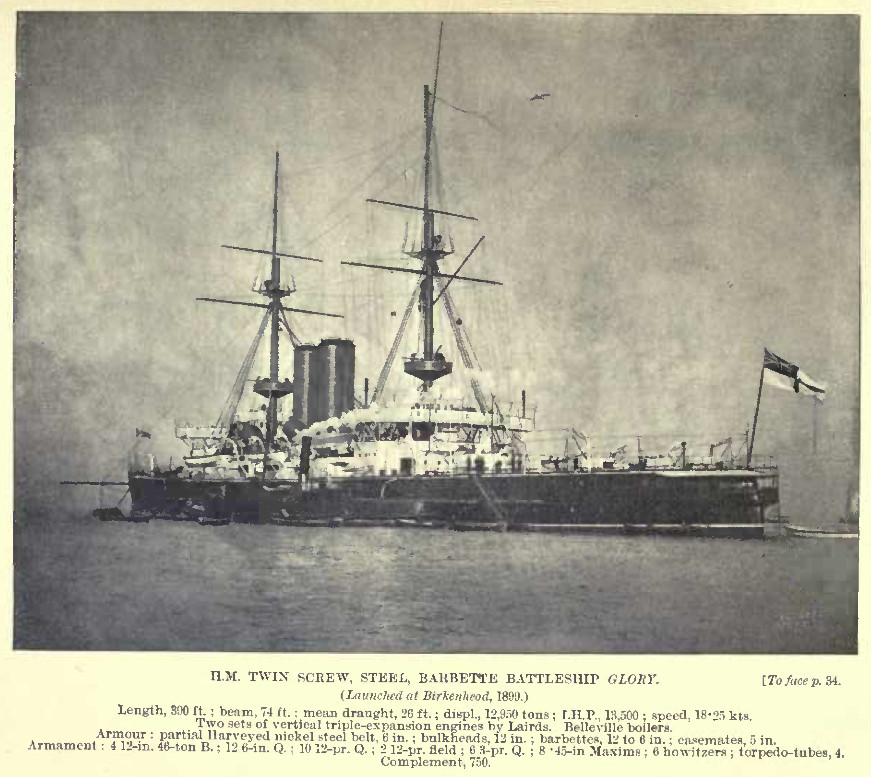
THE "FORMIDABLE"
CLASS. 35
Engines: Two sets
of 3-cylinder triple-expansion. Boilers, for the most part
Belleville water-tube, 20 in number, with economisers, and with
a heating-surface of 37,000 square feet. The Queen was to have
Yarrow boilers.
Armour: Krupp
steel partial belt, 210 ft. long, 15 ft. deep, and 9 in. thick.
Cross bulkheads 9 to 12 in. Barbettes, 12, 10, and 6 in.
Barbette-hoods, 10, 8, and 3 in. Protective deck, 2 to 3 in.
Main deck, 1 in. From fore-end of citadel to point of ram, a 2
in. belt, 15 ft. deep. Fore conning-tower, 14 in., with 8-in.
communication tube. After conning-tower, 3 in., with 3-in. tube.
Armament; 4-12 in.
50-ton wire-bound breechloaders: 12 6-in. 45 calibre
quick-firers in armoured casemates; 16 12-pr. quickfirers; 2
12-pr. boat or field guns; 6 3-pr. quickfirers; 8 .45-in. Maxim
automatic machine-guns. The heavy guns capable of being loaded
in any position. Torpedo ejectors (18 in.) 4; 3 being submerged,
and 1 above water at the stern. Search-lights, 6. Boats, 18, 4
being steam-boats, and 3 being fitted to discharge 14-in.
torpedoes.
The ships were
divided into about 150 water-tight compartments, and had upwards
of 200 water-tight doors. Apart from the main (propelling)
engines, there were about 100 others, for driving pumps, fans,
dynamos, steering-gear, capstans, hoisting apparatus, etc., etc.
The cost of a completed ship of the type, when ready for sea,
was about £1,250,000.
Armoured cruisers
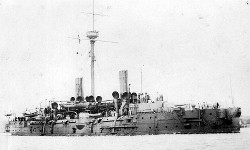 HMS Imperieuse after removal of brig rig |
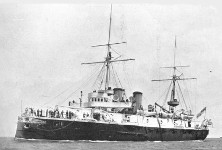 HMS Australia (Cyber-Heritage) |
After the building of the two ships of the Imperieuse type in 1883-84, and of the seven of the Orlando type (including HMS Australia above) in 1886-87 (see Class 4), the construction of armoured cruisers by Great Britain was completely suspended for ten years. The numerous and fine cruisers which were built had no vertical armour whatsoever, except, in some cases, over their principal guns, and, in most cases, on their conning-towers; and they relied for the maintenance of their buoyancy in action upon steel protective decks, and upon the sub-division of their hulls into very numerous water-tight compartments.
By 1897, however, certain foreign powers had embarked so decisively upon a policy of building fast armoured cruisers that the Admiralty could no longer hold back. Accordingly, in the Supplementary Estimates for 1897-98, and in the regular Estimates for 1898-99, 1899-1900, and 1900-1901 respectively, provision was made for the construction of twenty vessels of this class, as follows:
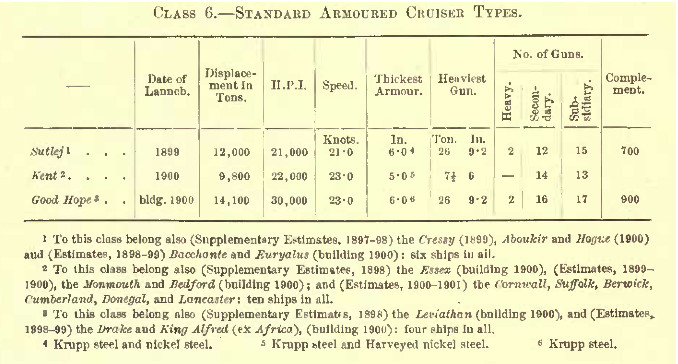
The 9.2-inch guns of the above were of the
Vickers pattern on special mountings on the central-pivot
system, with endless dredger hoists worked by electric motors.
The training was done alternatively by hand or by electricity.
Some ships of the Kent type had four of their 6-inch guns in
pairs in turrets fore and aft, so- arranged that each gun of a
pair could be used independently, or that both could be trained
together and fired as one piece. Later ships of the Kent type
were to carry one 7.5-inch gun instead of each of these two
pairs.
The Sutlej
type (Cressy below),
440 feet long, had 230 feet of that length belted with 6-inch
armour, and the forward end, to the ram, covered with 2-inch
plates. The Kent (or
"County" (Essex below))
type, also 440 feet long, but of less beam, had a 4-inch midship
belt, and 2-inch plating at the bow. The
Good Hope type had a 6-inch midship belt, and 2-inch
plating at the bow, and was 500 feet long between
perpendiculars. Further particulars may be gathered from the
accompanying plans.
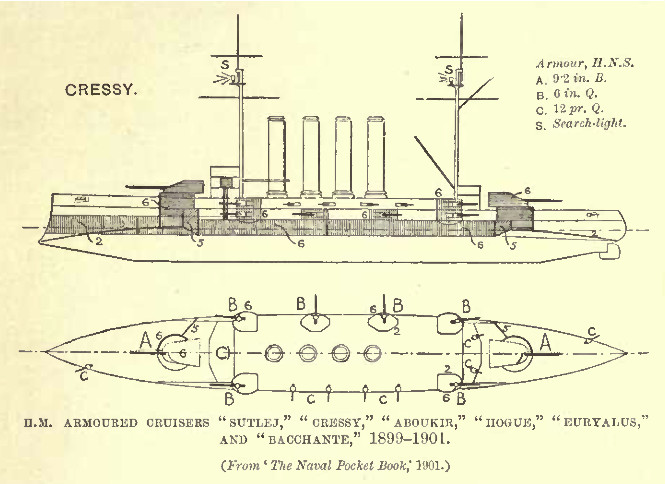
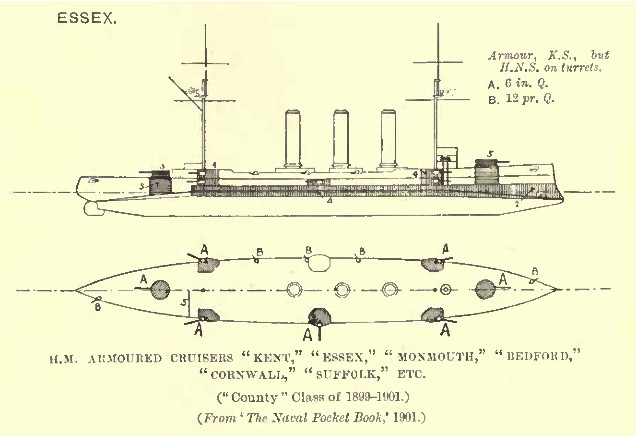
It would be quite hopeless to attempt to
analyse the very numerous designs of unarmoured cruisers which
found favour at various times between the beginning of 1857 and
the end of 1900. All that can be done here is to give a few
particulars of some of the more noteworthy types. These will be
found over-leaf.
GUN-VESSELS AND
GUN-BOATS. 37
(click to enlarge)
Gunboats
The gunboats built previous to 1890 had wood,
composite, or iron hulls. Of sea-going gunboats,
the Pheasant type (1888; composite; 755 tons; 13.2 knots; 1 screw; 6 4-inch B.); and
the Lapwing type (1889; composite; 805 tons; 13 knots; 1 screw; 6 4-inch B.),
may be cited as specimens which showed a
distinct advance upon the types of the period of the Crimean
War. In 1897-98,
the Dwarf class (steel, sheathed; 710 tons; 13.5 knots; 2
screws; 2 4-inch Q.) was built.
Of iron coast-defence gunboats, each mounting from one to three
comparatively heavy muzzle-loaders, and having twin screws but
very low speed, many were built between 1870 and 1882. Their
displacement was in the neighbourhood of 260 tons; and they were
chiefly designed for bows-on fighting. In the last decade of the
century several very shallow draught gunboats were
constructed for use in the rivers of Africa and China. Some of
these were fitted with a single stern-wheel, others, with twin
screws working in raised tunnels. The draught of a craft
displacing upwards of 100 tons was kept as low as 20 inches by
the ingenuity displayed by the designers, a leader of whom in
this branch, as in other special branches of naval architecture,
was Mr. A. F. Yarrow.
38 CIVIL HISTORY OF THE ROYAL NAVY, 1857-1900.
(tables and illustrations
moved)
TORPEDO BOATS. 39
The most important of the special branches in question was called into existence, about the year 1877, by the demand for small fast craft suitable for the most advantageous utilisation of the Whitehead torpedo, which, at that date, was forcing its way into general notice as a weapon with immense possibilities before it. Two or three years earlier fast craft had been constructed for using with a towing-torpedo, a type which speedily became obsolete. In 1877, after the great improvements effected in the Whitehead in 1876, Messrs. Thornycroft built the Lightning (later known as No. 1), and Mr. Yarrow almost simultaneously produced two somewhat bigger and faster boats, subsequently known as Nos. 17 and 18, for the Admiralty.
Large orders for similar vessels were quickly issued; and within
the following twelve months numerous torpedo-boats were
constructed for the British Government, though certain
foreign powers lost no time in acquiring even more; so that for
many years, as regards her torpedo-flotilla, Great Britain was
inferior to some of her rivals. Particulars of a few typical
British boats, arranged so as to direct notice to the
developments in size, and particularly in speed, are appended.
Smaller (2nd class) boats, intended for carrying on board ship,
and capable of being hoisted in and out, were also built, and
were eventually supplied to all battleships and large cruisers.
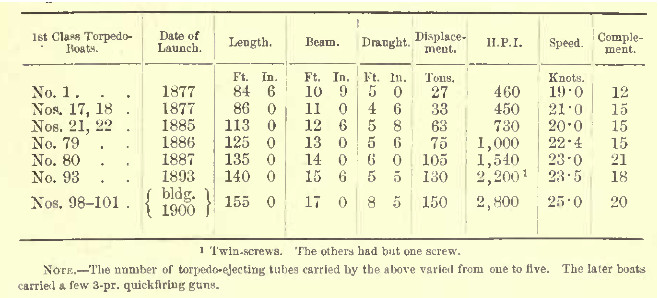
By the end of 1895, Great Britain possessed no fewer than 82 craft of the above and similar types, exclusive of boats less than 100 feet long. On the other hand, France had 195; Germany had 158; Italy had 121; Japan had 124; and Russia had 94 of corresponding classes. About three years before that date Britain's striking weakness in this respect had, however, been somewhat tardily recognised by the Admiralty; and measures had been adopted with a view to providing compensation. These measures involved the creation of yet another class of special vessels.
40 CIVIL HISTORY
OF THE ROYAL NAVY, 1857-1900.
Ever since the introduction of the torpedo-boat, the experts had
sought for a craft wherewith to meet and checkmate it. In 1885
they had evolved the torpedo gunboat, familiarly known in the
Navy as the torpedo-boat catcher, the first of the type being
the Rattlesnake, the precursor of the vessels of the
Sharpshooter (sister-ship HMS
Skipjack below), Alarm, and Dryad classes in the list
of Typical Cruising Ships on p. 38. But the "catchers," small
cruisers in effect, had proved too big, too visible, and, above
all, too slow for their intended mission, which was to overhaul
the torpedo-boat, and sink her by gun-fire, or by running her
down. In the annual naval manoeuvres of 1888-93 they failed over
and over again to protect the fleets to which they were
attached. It became evident that something else must be devised;
and accordingly, in 1893, the first
of the torpedo-boat destroyers were ordered.
The "catcher" had been too large on the one hand, and not large enough on the other, to attain and maintain really high speed. Moreover, she had been an expensive craft, and, while useless as a snapper up of torpedo-boats, had been equally useless as a torpedo-vessel, owing to her visibility and lack of speed. It was determined that the new craft should be a "catcher " and a torpedo-boat in one, a vessel able to overhaul and reduce a hostile torpedo-boat by means of gun-fire or running down, and also able to act as a first-class torpedo-boat of the most effective sort.
(From "The Marine Steam Engine" by Sennett - An example of the results obtained in sister vessels with locomotive and water-tube boilers may be given in the trials of 'Havock' and 'Hornet,' both built and engined by Messrs. Yarrow & Co., the 'Havock' with locomotive boilers having copper fire-boxes and the 'Hornet' with water-tube boilers.)
Mr. Yarrow's pioneer destroyer, the Havock (above),
launched in the autumn of 1893 in response to the requirements
of the Admiralty, was from the beginning so obvious a
success that other craft of the kind were promptly ordered from
various firms; and a considerable flotilla of these boats was
created by Great Britain almost before any other power secured
so much as a single specimen. In the table on p. 41
(below) will be found an epitome of the rapid
development of the torpedo-boat destroyer in the few years which
elapsed between its original evolution and the end of the
nineteenth century.
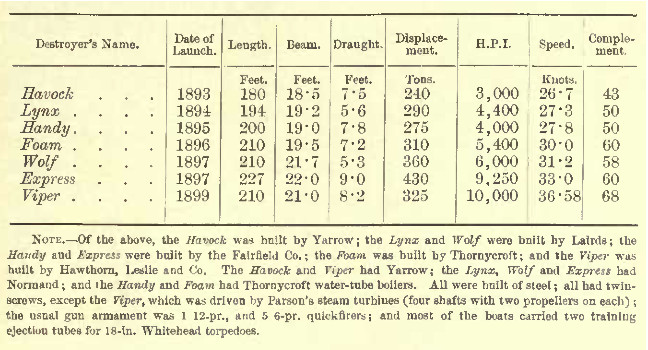
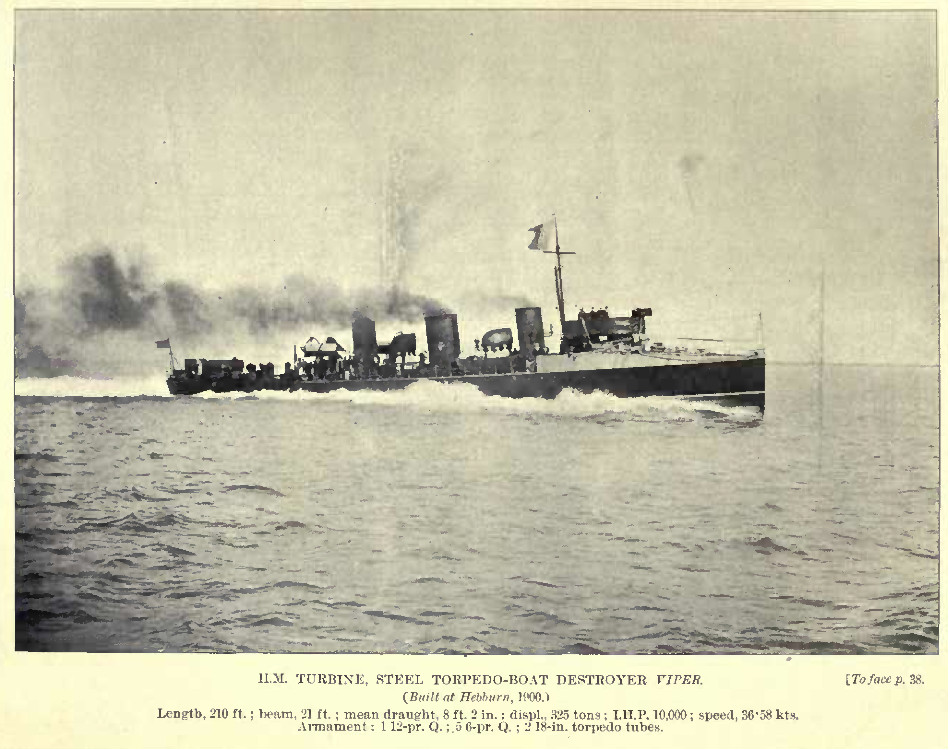
DESTROYERS AND SPECIAL SERVICE CRAFT. 41
A few miscellaneous craft of special nature remain for notice. In 1878 the importunate advocacy of the ram by Admiral of the Fleet Sir George Rose Sartorius, then eighty-eight years of age, induced the Admiralty to lay down the Polyphemus (now page 41 below), a steel twin-screw vessel designed solely for ramming and for discharging torpedoes. She was of 2640 tons' displacement, and had a speed of 17.8 knots. Owing to alterations made in her plans while she was building, she was not launched until 1881, and was not ready for sea until several years later. A most expensive craft, and of doubtful value, she remained the sole representative of her class.
The addition to the Navy of large numbers of torpedo-boats rendered it desirable that a large vessel should be provided to act as a kind of nursing-mother, storeship, and repairing shop for such craft while at sea. In 1878, the iron steamship Hecla, of 6400 tons displacement, was purchased by the Admiralty for this purpose, and adapted as a torpedo depot ship; and in 1889 a second sea-going depot ship, the Vulcan (below), a fast steel twin-screw vessel, of 6620 tons' displacement, was added to the service.
The latter was built expressly for the objects in view, and was also a mining and electric cable depot, a floating workshop, forge, and foundry, and a repository for six second-class torpedo-boats, which she carried on her deck, and could hoist in and out by means of specially fitted hydraulic cranes. In addition, she was an efficient, though lightly armed, cruiser, with protective deck. Despatch vessels, tugs, storeships, troopships, yachts, surveying vessels, and harbour craft served throughout the period as complements of the fighting navy, but were far too numerous for mention here.
A word may be added as to the royal yachts. In 1857 the principal yacht was the second Victoria and Albert (ex-Windsor Castle (above)), particulars of which have been given in Vol. VI, p. 199. A most useful and comfortable craft, she retained her position until the end of 1900, although a third Victoria and Albert, a twin-screw steel ship of 4700 tons' displacement and 17 knots' speed, had been laid down in 1897 and launched in 1899. This fine vessel was nearing completion at the end of the century. At that date, the other royal yachts were the wooden paddle vessels Osborne, of 1850 tons' displacement and 14 knots speed, built in 1870; Alberta, of 370 tons displacement and 13 knots speed, built in 1863; and the little tender Elfin, of 93 tons' displacement and 11 knots speed, dating from as far back as 1849.
During the Russian scare of 1885, numerous fast and large merchant vessels were taken over and employed temporarily as naval cruisers, 1 one, the Oregon, being actually commissioned by officers and men of the Navy. Many years earlier, viz., in December, 1876, the Admiralty had opened a register for ships complying with certain stipulated conditions, and therefore suitable for employment in time of war. In 1885 the number of vessels on this list was 155, of 12 knots' speed and upwards. In the estimates for 1887-88, provision was made for the payment of small subsidies, by way of retaining fees, to the owners of a few of the most serviceable of these craft; and at the same time it was arranged that the subsidised owners should hold other ships at the disposal of the Admiralty without further retaining fee.
At the end of 1900 the number of large fast vessels thus secured as "Royal Naval Reserved Merchant Cruisers," or as additional cruisers for instant use in case of need, was fifty, the contributing companies being the Cunard, the Peninsular and Oriental, the White Star, the Canadian Pacific, the Orient, the Royal Mail, and the Pacific. For each of the subventioned vessels a suitable light armament was stored at the British port to which she belonged.
The end of the Crimean War marks the end also of what may be called the stagnation period in the history of naval gunnery. In the previous half century the use of shells had become more general than before, and the shell itself had been improved, though it was still employed chiefly in mortars; and attention had begun to be directed to the problem of the diminution of windage, with a view to obtaining greater accuracy and velocity by utilising as much as possible of the elastic force of the explosion, and allowing as little of it as possible to pass the projectile and escape without doing its due share of the work.
In certain small arms the problem had been dealt with long before by the adoption of the device of rifling the interior of the barrel, and giving to the grooves of the rifling a slight but constant or even an increasing twist, which was found to increase accuracy by imparting a corresponding axial twist to the bullet in its flight. In the old muzzle-loading days, the bullet of a rifle was hammered, or violently forced down upon the powder; but very little experiment showed that it would be vain to attempt to do with an iron projectile, weighing perhaps 681bs., what could be done easily with a leaden bullet weighing a few grains.
Whitworth and others, therefore, devised an elongated bolt or projectile which, instead of being forced into the bore of a heavy gun by the exertion of main strength, was of size and shape to permit of its being pushed home with comparatively little exertion, but which, nevertheless, acquired a twisting motion in its outward flight by reason of some peculiar correspondence between a cross section of the projectile and a cross section of the bore of the gun, the bore itself being twisted. Whitworth's section was hexagonal; the section chosen by Lancaster was slightly oval. Yet still, as the projectile would not fit with more than approximate accuracy, there was much windage; and at length it became obvious that if windage was to be reduced to the lowest practicable point, the gun must be loaded not at the muzzle but at the breech. 1
In 1858 the first great step was taken. In that year the Committee on Rifled Cannon recommended the introduction of the rifled breechloading Armstrong gun into the naval service. In the earliest days of the new guns there was no improved velocity, 2 but there was immensely improved accuracy. Comparing, for example, the velocities and energies of the 32-pr. smooth bore and of the 40-pr. R.B.L. gun which took its place, Sir Andrew Noble puts the muzzle velocity 3 of the old weapon at 1600, and that of the newer at only 1200 foot-seconds, and the muzzle energy 4 at 570 and 400 foot-tons respectively; but he adds that, using the method of least squares to determine the relative accuracy of the rifled and of the smooth bore gun of approximately the same weight, he found that, at a range of 1000 yards, half the shot from a rifled gun fell in a rectangle about 23 yards long by 1 yard wide, while, in the case of the smooth bore, the corresponding rectangle was about 145 yards long by 10 yards wide.
2 For a discussion of this question, see Noble, 'Rise and Progress of Rifled Naval Artillery'; Inst. of Nav. Arch., July, 1899.
3 Muzzle velocity means the rate in feet per second at which the projectile moves on quitting the gun's muzzle.
4 Muzzle energy means the power developed at the gun's muzzle, as measured by the weight in tons which that power would raise to the height of one foot.
The velocity was afterwards improved, first by using various obturators and "driving bands," the effect of which was to enable the pressure of the gases of explosion to squeeze the basic, or part of the cylindral, periphery of the projectile into the grooves of the rifling, and so prevent those gases from escaping before the expulsion of the projectile; later by the gradual adoption of more suitable powders, which, being of slower combustion, set up growing rather than sudden pressures, and so reduced the violence of the strains; and, last of all, by the adoption of much longer guns, so as to allow of the slower burning powders perfecting their combustion while the projectile was still within the muzzle and fully subject to the pressure.
But these were the improvements of years. Armstrong's first breechloader was a tube, cut into near its rear end so as to admit of the dropping in of a breech block, which then filled the aperture and closed the bore. A hollow screw, working in the tube or bore from the rear, pressed the block home, and held it fast. The gun was loaded through the hollow screw, the block being displaced for the purpose; and for that reason it soon became known as the Armstrong screw gun. The following are particulars 1 of various types of this weapon which were used in the Navy from about the year 1860 onwards:
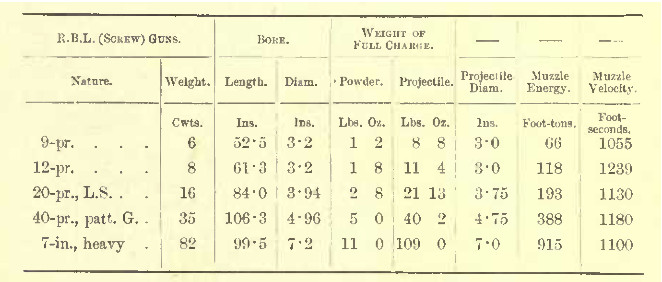
This system, though embodying great improvements, proved unsatisfactory, owing, among other reasons, to the tendency of the breech-block to jump out of its place upon the firing of the gun, and to the general weakness of the breech. 1 With its introduction came the general adoption of iron or steel carriages for naval guns. The new carriages survived the new breech-loaders, which, after they had undergone but little trial in action, and before the system could be applied to weapons of larger calibre than 7 in., were abandoned, mainly on account of their danger. The 7-in. guns, and most of the 40-prs. were quickly got rid of; but some of the lighter guns remained in certain ships for twenty years or longer.
It is a strange thing that, although at the time when the R.B.L. gun was thus discredited the necessity for a breech-loader of some sort was generally recognised by experts, the British Navy reverted to the muzzle-loading system. It was about the year 1865 when the Admiralty realised that it must seek perfection in a new path. Abroad, several excellent breech-loading systems were coming into prominence; yet Great Britain went back deliberately to the muzzle-loader, and, having taken it up again, clung to it devotedly for almost twenty years, in spite of the fact that, in the interim, nearly every other naval power had armed itself with breech-loaders.
The new British muzzle-loader, however, of 7-in. calibre and upwards, was not like the old gun of Crimean war days. In one respect, indeed, it resembled the R.B.L., in that it was a built-up gun, made on the Armstrong, the Fraser, or the modified Fraser system; but it was a far larger weapon than had been employed ever before. In each case wrought-iron coils were shrunk over a steel tube with a solid end which was supported in the rear by a cascable screwed up against it through the breech.
The constructions varied chiefly in the number, arrangement, and cost of the portions shrunk round the inner tube, in the diameter of the cascable, and in the thickness of the inner tube in which were cut the grooves of the rifling. All except the 16-in. 80 ton gun, were rifled on the Woolwich system of wide grooves having rounded sides; and the grooves were fitted, more or less loosely, by projecting gun-metal studs on the circumference of the projectiles, there being, of course, as many rows of studs as there were grooves.
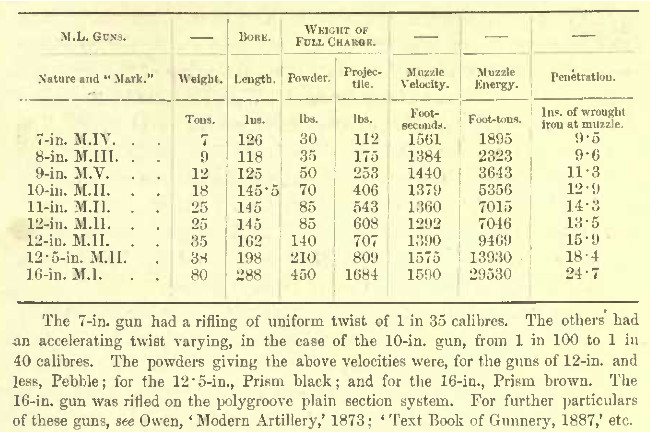
The M.L. gun held its place in the Navy from the middle sixties until about 1881, and, during that period, was supreme. But, as early as 1877, discoveries which had the effect of increasing the initial velocities of rifled projectiles from about 1600 to 2100 foot-seconds, and the energies by nearly 75 per cent., had rendered inevitable another reconstruction of guns and their mountings. The Thunderer gun accident in January, 1879, tended, also, to shake faith in the muzzle-loader. (Sister ship to Devastation, exercising in Sea of Marmora when one of the two forward 12in muzzle-loading guns burst after being double-loaded, killing 10 officers and men - Dawlish Times site)
At the same time, as Sir Andrew Noble points out, from the increase in the length of guns demanded by the slow-burning powders and high energies then introduced, it became necessary to return to the breech-loader. But apart from the mechanical and dynamic considerations which prompted the step, there were, so it appears to me, far more important tactical reasons; one being the impossibility of serving a broadside muzzle- loader in a ship in a hot action without exposing the crew unduly to the small projectiles of the enemy; and another being the fact, well ascertained even when Great Britain foolishly reverted to muzzle-loaders, that, weight for weight, a breech-loader is a much more rapid-firing weapon than a muzzle-loader, no matter how good or how smartly worked.
In the early eighties the new breech-loaders began to be mounted in new battle-ships and cruisers; but only very slowly did they displace the old weapons. In 1885 I went to sea with the Particular Service Squadron, under Sir Geoffrey Thomas Phipps Hornby.
There was at that time some fear of trouble with Russia, and the squadron, one of the best that could then be sent to sea by Great Britain, sailed not knowing whether it might not be in action ere it sighted England again. None of the battleships in it, however and there were thirteen carried so much as a single breech-loader of more than 6-in. calibre; while every one of the big ships in the navy of Russia was armed entirely with breech-loaders.
In 1894 I was again afloat with the fleets which manoeuvred that summer under Vice-Admiral Robert O'Brien FitzRoy, and Rear-Admiral Edward Hobart Seymour. Of twelve battleships then engaged, two still had muzzle-loaders as part of their armament; and on the last day of the century, fully eighteen or twenty years after muzzle-loaders had been finally condemned even by Great Britain, there remained on the active list of the Navy several large vessels armed in the old discredited way. Progress, therefore, was terribly slow; and it should ever be a subject of congratulation that, during the many years when the transition was in process of accomplishment, the British Navy never had to measure itself with one of the great navies, which, ere Britain had begun to move in the matter, had completed their rearmament.
The Woolwich-Armstrong breech-loading guns thus tardily introduced were of the following chief types:
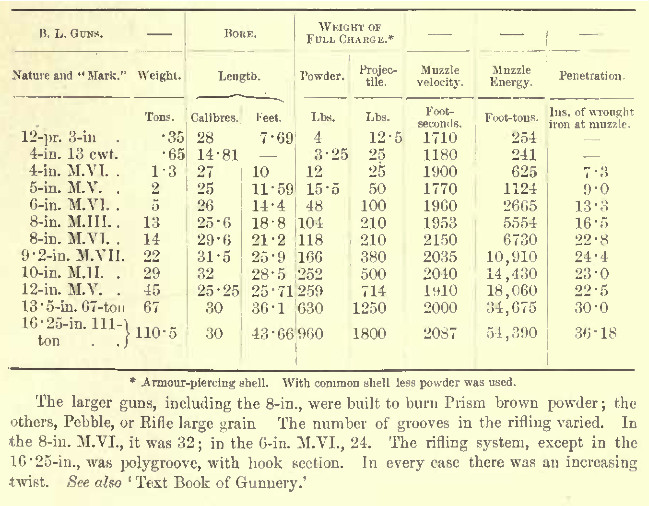
The next improvements in heavy guns were indirectly the outcome of the practical supersession of gunpowder by cordite, ballistite, and similar propellents. These give much greater energy, with no greater chamber pressure, and, producing no smoke, possess manifest advantages; although probably they may yet be vastly bettered.
The new developments were in two directions, namely, in the direction of increased power without relative increase of weight of gun, and in the direction of accelerated rate of fire. An example of development in the first of these directions was the 12-in. 46-ton wire gun, which formed the chief armament of the battleships laid down in 1894-97. This gun, with a length of 37.1 feet, or 35.43 calibres, was built to throw an armour-piercing shell of 850 Ibs., and, with a full charge of 167.5 Ibs. of cordite, gave a muzzle velocity of 2400 foot-seconds, and a muzzle energy of 33,940 foot-tons. It had a muzzle penetration of 36.8 inches of wrought iron; and, though it weighed but 46 tons, was practically as powerful a weapon as the 13.5-in. 67-ton gun which it took the place of. A somewhat heavier and more powerful 12-in. wire gun was introduced for the battleships laid down in and after 1898. It weighed about 50 tons. The developments in the direction of accelerated rate of fire must be dealt with at somewhat greater length.
Towards the end of the year 1881, the British government invited designs for a gun which should fulfil the following among other requirements. The weight of the gun and its mounting should not exceed half a ton; the projectile should weigh six pounds, and should have a muzzle velocity of not less than 1800 foot-seconds; the projectile and powder charge should be made up in one cartridge; the gun should need a crew of not more than three men; and the weapon should be capable of discharging at least twelve aimed shots per minute.
In reply to this invitation, and to a somewhat similar one for a three-pounder from the French government, the Hotchkiss and the Nordenfelt companies, as well as other firms, drew up plans and specifications for what afterwards became known as quick-firing or rapid-firing guns. Weapons of this description were presently adopted as part of the armament of every warship. As soon as it became clear that they were destined to be successful, the Elswick company constructed larger weapons, of 4.7-in. and 6-in. calibre, also on quick-firing principles, and submitted them to the Admiralty. In the case of the larger guns the projectile and the powder charge were not made up into one cartridge; but in most other respects the characteristics of the 6-pr. Q.F. were reproduced.
The new guns speedily gained favour, and within a very few years displaced all others in the secondary batteries of warships. The general effect of the innovation, supplemented by the adoption of greatly improved mountings, was to multiply sixfold a battery's rate of fire. At a trial in 1887 on board the Handy, at Portsmouth, a 4.7-in. gun on centre pivot recoil mounting, the whole weighing 4 tons 12 cwt., fired ten rounds in 47.5 seconds. The gunboat Mastiff was subsequently ordered to fire ten rounds as rapidly as possible from her service 5-in. B.L. gun. These rounds took six minutes sixteen seconds to discharge; so that the new gun fired ten times while the old one fired twice. The new gun afterwards fired fifteen rounds in one minute. 1
It would be tedious, and, in a work like the present, unnecessary, to describe in detail the various types or "Marks" of British quick-firing guns, and of the mountings which have been devised for them. It will suffice to give the appended general particulars of some leading varieties of these guns 2:
2 'Naval Pocket Book,' 1899.
Small arms
In the meantime there were equally important improvements in the small-arms which were used in the Navy. At the close of the Crimean War, the service rifles were on the Delvigne-Minie principle, and of the 1851 pattern. These had a calibre of 0.702 in., and were muzzle-loaders. In 1856 and 1858, new patterns were adopted for different branches of the Navy; and the calibre was reduced to 0.577 in. Then, about the year 1861, came the Enfield small-bore rifle of the experimental pattern, with a calibre of 0.453 in.; but still the muzzle-loader only was employed.
The first breech-loader used in the Navy was the Snider; and in 1864 a number of muzzle-loaders were converted on Snider's principle from 0.577-in. muzzle- loaders, the calibre remaining as before. A new Snider naval rifle of 0.577 in. calibre was also issued. Many years afterwards followed the Martini-Henry rifle, with a calibre of 0.45 in., to be superseded in the last decade of the century by the Lee-Metford, and the closely related Lee-Enfield, of only 0.303 in. calibre. These last were adopted nearly simultaneously with the general substitution of cordite for black powder in all arms, small as well as large. The following are some particulars of the Martini-Henry and the Lee-Metford:

The Franco-Prussian War of 1870-71 brought the mitrailleuse into celebrity. The weapon seems to have accomplished little in that campaign; but its use directed attention to the far more serviceable Gatling gun, another variety of small-arm battery, or "machine-gun," the object of which was to pour out a rapid and continuous hail of comparatively small bullets. Gatling guns had been shown at the Paris exhibition of 1867 by their inventor, R. J. Gatling of Indianapolis, and had attracted much notice. They were of 1 in. and 0.58 in. calibre, with six barrels revolving round a central axis. By turning a crank, cartridges, supplied by feed boxes, could be discharged at a great rate. Yet other types of machine-guns, and especially the Nordenfelt, the Gardner, and subsequently the Maxim single-barrelled automatic, won their way to favour, all
being used in the Navy during the last years of the nineteenth century, although the Maxim was then rapidly displacing the others. The leading particulars of them are set forth below:
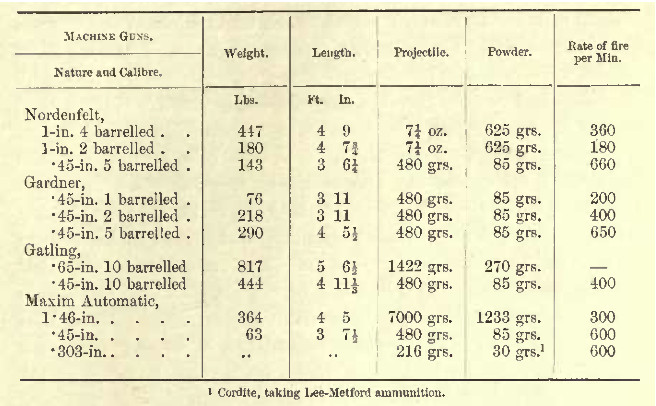
In spite of the introduction of the torpedo, and of the fact that all large ships of war built towards the end of the nineteenth century were designed to serve as rams, the gun maintained its ancient position as the first and principal weapon of the Navy. While, however, the unshaken position of the gun was frankly recognised by all the most respectable authorities on naval tactics, the importance of good gunnery was, in practice, still strangely and culpably neglected throughout the British fleet (see "Fifty Years in the Royal Navy" by Admiral Percy Scott and his battle to introduce higher standards): so much so, indeed, that, according to the prize-firing returns for 1900, the mean percentage of hits scored by all the ships in commission in that and the previous year was no more than the following:
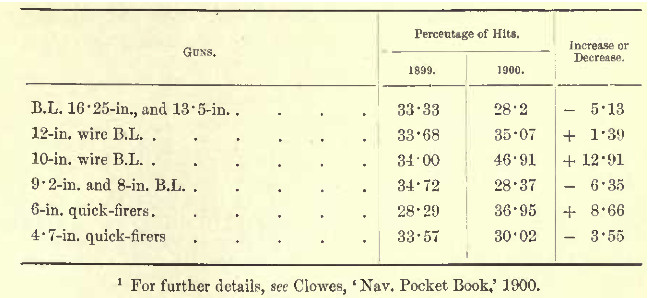
Looking to the easy conditions under which prize-firing was carried out, and bearing in mind that the speed of the firing ship was always relatively low, that the range was never great, and that the target, instead of being an enemy's vessel, which could retaliate and confuse the gunners, was only a floating screen of spars and canvas, these results were certainly indifferent. But in the year 1900, one ship, the first-class cruiser Terrible, Captain Percy Scott, 1 distinguished herself by making no less a percentage than 76.92 of hits, and so showed how very far short of attainable efficiency was the gunnery of other vessels. Her efficiency was due not only to the ingenious devices which were invented or employed 2 by Captain Scott, but also to the personal attention which he and his officers devoted to the training of their men. The consequences were that almost immediately the Admiralty turned its attention to Captain Scott's inventions, with a view to their general adoption, and that the Terrible's brilliant example engendered a healthy emulation which promised to lead to a very notable heightening of the standard of gunnery in every ship in commission.
The subject of engines and boilers is one into which it is not possible here to enter very deeply. Those specially interested in it will find it dealt with in a manner worthy of its importance in various technical works, to some of which the note 3 below will refer them.
Suffice it to say, as regards engines, that, at the beginning of the period under review, nearly all British men-of-war were fitted either with trunk or with return connecting-rod engines; that, in the early "sixties," compound engines were experimented with, notably in the case of the Constance (built in 1846, and converted to a screw-ship in 1862), but were not then sufficiently understood to be worked successfully; and that the earliest efficient application of compound engines to a British war-ship was made in the case of the small wooden ironclad Pallas, of 1865.
2. Including the Barr and Stroud Range-finder.
3 Sennett, "The Marine Steam Engine" (1888) (later edition, excerpts only); Seaton, "A Manual of Marine Engineering '' (1893); Yeo, "Steam, and the Marine Steam Engine" (1894); Williams, "The Steam Navy of England " (1895); S. W. Barnaby, "Marine Propellers" (1885); Bertin, "Machines Marines" (1899); Busley (tr. by Cole), "The Marine Steam Engine"; Oldknow, "The Mechanism of Men of War" (1896); "Notes on Steam Engineering" (Annapolis, 1901); Tompkins, "Text Book of Marine Engineering"; Bourne, "Catechism of the Steam Engine"; Murray, "Marine Engines and Steam Vessels" (1886), etc.; and works on Boilers, for which see note on p. 55.
These were two-cylinder engines, by Messrs. Humphrys, with surface condensers. Not, however, until several years later were compound engines generally adopted by the Navy, for the next ironclad to be provided with them was the Alexandra, of 1875. At first such engines were horizontal, in order that the cylinders and machinery might be kept low in the hold, and enjoy the protection of the water; but it was all along recognised that the vertical was the proper position, and in the Dreadnought and the Shannon, both launched, like the Alexandra, in 1875, vertical engines were employed.
To Captain Robert Anthony Edward Scott, 1 better known for his inventions in connection with gun-mountings, belongs, I believe, the credit of suggesting the use of a curved steel deck and armoured coamings over a ship's engine-room as protection for the upper parts of vertical engines, and of thus enabling such engines to be fitted in cruisers as well as in vertically-armoured vessels. Triple-expansion engines were first given in the Navy to the torpedo gun-vessel Rattlesnake, of 1886, and then to the battleships Victoria, Sans Pareil, and Nile (1887-88). Soon afterwards they became the ordinary service engines throughout the British Navy, subject, however, to various modifications. To the Blake and Blenheim, first- class cruisers of 1889-90, four sets of triple expansion inverted cylinder engines were given. Two sets remained, however, the more usual number until the close of the century.
Twin screws were fitted in numerous small craft in the later "sixties"; and in 1868 they were also given to the ironclad Penelope, the first of her class to have them. Not, however, until about ten years afterwards did the Admiralty make up its mind that they were necessary to all large men-of-war. It may be noted that the earlier twin screws rotated outwards, and the later ones inwards.
The earlier single screws, as applied to large vessels with full sail-power, were so fitted that they could be disconnected from the machinery, and either left to revolve with but little friction while the vessel was under canvas, or, in other cases, raised entirely out of the water, a well, generally from the upper deck, being made above them for that purpose. Yet other screws fitted to sailing vessels had feathering blades, which, when the screw shaft was not rotating, could be unlocked, and left to trail in such a manner as to offer a minimum of resistance to the water.
Besides their main engines, all the large ships of the close of the century had numerous others, often in duplicate, for various purposes. Thus, for example, the Vulcan had 98 separate engines, with, in all, 194 cylinders; the Powerful and Terrible had each 85 auxiliary engines; and the battleships of the Royal Sovereign class (1891-92) had each 86.
During the whole period the machine-driven screw-propeller, single or twin, advanced in favour; and, ere the beginning of the last quarter of the century, it had entirely ousted the paddle-wheel as a warship motor, although the paddle-wheel was still retained in certain tugs, surveying-vessels and harbour-craft which were not intended for fighting purposes or general service. More than once, however, experimental craft with other forms of motor were tried by the Admiralty.
The armoured gun-vessel Waterwitch, of 1866, designed by Rear-Admiral George Elliot (4) and the Controller's Department, was driven hydraulically, but was a complete failure. The second-class 66-ton torpedo-boat, No. 98, built by Messrs. Thornycroft in 1883, was also driven hydraulically, and proved a disappointment to her projectors. Some years later, however, the success of a vessel called the Turbinia, the motor of which was the invention of the Hon. C. A. Parsons, drew the attention of the Admiralty to the merits of the compound steam turbine as a substitute, in certain kinds of craft, for the ordinarily driven screw.
The Turbinia created an immense impression on the occasion of the Diamond Jubilee Eeview of 1897, when she appeared among the British and foreign men-of-war assembled at Spithead, and astonished all observers by her speed. The result was the fitting of somewhat similar turbines to the torpedo-boat destroyer Viper which was built in 1899, and which attained the extraordinary speed of 36.58 knots, or upwards of 42 statute miles, an hour at her trials on July 13th, 1900. She had 4 shafts with 2 propellers on each, and Yarrow water-tube boilers; and on the occasion in question, with 200 Ibs. of steam pressure, her propellers made 1180 revolutions a minute. Another destroyer of much the same type, the Cobra, built in 1900 at Elswick, for sale, if successful to the Admiralty, did almost equally well at her first trials in June that year; and, although the new system of propulsion was not without some defects and drawbacks, it then became evident that it had established itself firmly as a means whereby speeds not otherwise attainable might be secured for craft of certain classes.
Triple screws, though fitted in the warships of more than one foreign power, and in several of the larger and faster of foreign merchant steamers, failed to recommend themselves to British naval constructors.
The marine boilers l of the period were first of the square box type, and, later, of short cylindrical or ellipsoidal shape, having, as a rule, furnaces below and in front, and fire-tubes above and behind. In all these boilers the tubes conducted the heat through the water. Other boilers of the same class had furnaces at both ends. To produce more rapid combustion in the furnaces, and quicker evolution of steam in the boilers, what was known as "forced draught" was at length employed. The stoke-holds were closed, and by means of fans, air was pumped into the stoke-hold ends of the furnaces, the air-pressure in the stoke-holds being thus increased, and additional oxygen, in proportion, being fed to the fires.
The use of forced draught, however, was found to be very trying to the tubes, and especially to the tube-plates at their ends; and it was to protect the tube-plates and the ends of the fire-tubes that a strengthening device, commonly called "the Admiralty ferrule," was adopted. This enabled forced draught to be used with less damage to the boilers. Another method of feeding additional oxygen to the fires was by Mr. W. A. Martin's system of "induced draught." In this system, the air was drawn through the furnaces and tubes by means of fans placed at the bottoms of the funnels. The results aimed at were in both cases the same.
But, in practice, forced or induced draught was so seldom used in men-of-war, except at their trials; it added so little, comparatively, to their speed; and it was, in spite of everything, so destructive to the boilers, that the wisdom of providing apparatus for it was never conclusively demonstrated. It might be important, it was recognised, to enable a ship to add a knot or two to her speed at a critical moment; but if the effort was to be accompanied by a risk of a subsequent total breakdown, possibly in presence of an enemy, it was urged, and with some justice, that the temporary extra speed might be too dearly purchased.
see also Sennett, "The Marine Steam Engine" (1888) (later edition, excerpts only);
These and other considerations led to experiments with boilers of new types, which promised to permit of the use of higher pressures, and to facilitate a more rapid raising of steam, than the old boilers. The new types were many, but those of them which obtained any degree of success had all one feature in common. Instead of having tubes which conducted the heat through the water, they had tubes which conducted the water 1 through the heat. Of these water-tube boilers, the chief varieties which, experimentally or otherwise, were fitted in ships of the British Navy were, the Belleville, the Yarrow, the Thornycroft, the Normand, the Reed, the White, the Blechynden, the du Temple, the Babcock and Wilcox, the Mumford, and the Niclausse, though at least half a dozen other kinds were in use elsewhere.
It was recognised from the beginning that these water-tube boilers were especially suitable for destroyers, and other light fast craft, which, in all probability, would not be required to remain under steam for long periods at a time, and which, therefore, would enjoy frequent opportunities for overhauling, cleaning, and repairing their generators. When, however, upon the laying down of the gigantic first-class protected cruisers, Powerful and Terrible, which were launched in 1895, Mr. Albert John Durston, Engineer-in-Chief of the Navy, determined to fit them with batteries of Belleville boilers, fears were very widely expressed as to the unwisdom of the scheme.
He persisted, however, in giving Belleville boilers not only to these vessels, but also to other large cruisers, both protected and armoured, and to all the battleships which were laid down in and after 1897. Mr. Durston won a K.C.B. in 1897 on the strength of his bold departure; but opposition to his principles continued to grow, and by the end of the century it had become clear that the Belleville was not, upon the whole, the best of the water-tube boilers for use in big ships, while many grounds had arisen for the conviction that, although water-tube boilers possessed some striking advantages, they were in some respects unsuited for heavy war vessels from which prolonged steaming and very varying speeds would, in the nature of things, be demanded. 2 It must be remembered, however, that at the end of the nineteenth century all the naval powers were freely fitting water-tube boilers of one type or another to their warships, both small and large.
2 The risk of breakdown may be estimated to some extent from the fact that in each of the armoured cruisers of the King Alfred class there were 5348 tubes in the 43 Belleville boilers, and 5328 tubes in the economisers.
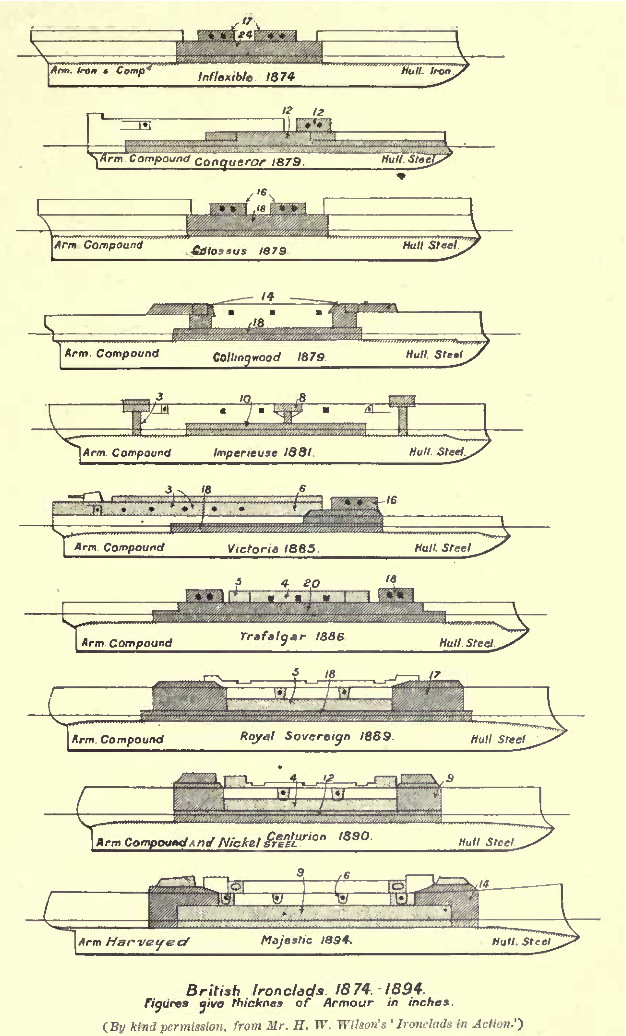
The development of armour has already been touched upon incidentally in the sketch which has been given of the history of battleship building. Until about 1875 all British vertical armour for ships of war was of wrought iron. Compound armour, or, in other words, iron armour with its face steeled, was introduced for the turrets of the Inflexible, which was launched in 1876. Thenceforward compound armour was generally used for about thirteen years To some of the ships of the Royal Sovereign class (1891-92) nickel-steel armour was applied as protection for the central battery, nickel-steel being steel with a small toughening admixture of nickel; but the thicker belt and barbette armour continued to be compound.
In the Renown, launched in 1895, Harvey steel was employed for the heavy armour. This is steel the surface of which, to a slight depth, has been rendered intensely hard by a process of supercarbonisation. The effect of the hardened surface was to distribute the blow of the projectile over a comparatively large extent of the softer steel beneath. In the battleships which were laid down in the last two years of the nineteenth century, Harvey steel gave place to Krupp steel, a steel surface hardened and highly tempered by a process analogous to Harvey's, but of better quality than the steel or nickel-steel which had previously been treated in England.
Speaking roughly, the relative resisting powers of the various armours were as follows: 1-inch Krupp steel = 1.25-inch Harveyed nickel-steel = 1.5-inch Harvey steel = 2-inch compound armour = 2.5-inch mild steel = 3 inch wrought-iron armour. Therefore the thickest wrought-iron armour of the Inflexible (24 inches) may be considered as, upon the whole, inferior to the 9-inch Krupp steel belt of the ships of the London class, the thickest armour of which (12 inches) represents something like 36 inches of wrought-iron - an armour which, on account of its weight, could never have employed afloat, except over very small areas indeed. (Note: Krupp armour was not supplied by Krupps, but manufactured by the Krupp process.)
During the period which witnessed such vast improvements armour, there was, strange to say, no commensurate improvement in the projectiles 1 designed to attack it. Guns improved, and gunnery improved; but, after the introduction of face-hardened armour, projectiles made but little progress. Indeed, the armour-piercing shells (shells with small bursting-charges and hardened points), and common-shells (shells with large bursting charges and thinner walls)
used in 1900 were very little different from those used in 1890, except in one feature, which, however, was extraneous to the shell itself. About the year 1894, the device of capping projectiles with a small mass of soft steel was invented by Mr. Isaac G. Johnson, in America, and, it is said, almost simultaneously in Russia. The capped projectile, when striking at right angles, was found to have a penetrating force 10, 15, or even 20 per cent, greater than that of the uncapped one. Several theories were advanced to account for this, but what seems to be the true one may be thus stated:
The invention was quickly adopted by the United States, Russia, and France, but at the end of the century it had not fully commended itself to the British Admiralty, although official experiments had been made with it in England. In fact, with regard to nearly all new inventions bearing upon naval warfare, Great Britain showed herself intensely conservative.
Upon the whole it may be said that no invention of the latter part of the nineteenth century exercised a greater influence upon the principles of naval warfare than that of the automobile torpedo. As has been shown in previous volumes, torpedoes or "infernal machines," of one kind or another, were employed by or against the Royal Navy from the middle of the seventeenth century onwards. Prince Rupert's semi-piratical attempt to blow up the Leopard 2 involved the use of a device of this sort; the "machine" 3 of 1694 was of similar character; the Americans endeavoured to explode mines or torpedoes under British vessels in both their wars with the parent country; the "catamaran" 4 of 1804 was a towing torpedo under another name; and the Russians did some little damage with their stationary torpedoes 5 or mines in 1855.
2 Vol. ii., p. 127.
3 Vol. ii., p. 467 n.
4 Vol. v., p. 69.
5 Vol. vi., p. 483.
The forms of torpedo principally used in the British service after the Russian war were five in number, viz.,
spar torpedoes, or explosive charges carried at the end of a spar at a boat's bows;
towing torpedoes, of which class the best known example was the short-lived and unsatisfactory Harvey;
automobile torpedoes, such as the Whitehead; and
controllable torpedoes, such as the Brennan.
In the earlier days the charge was gunpowder; in the later ones, guncotton or some other "high explosive."
The first and most successful of all automobile torpedoes was the Whitehead, so called from the name of its inventor, to whom belongs the great credit of utilising hydrostatic pressure to regulate the depth of the weapon's immersion in the water. It seems to have been in 1864 that Mr. Whitehead's attention was originally directed to the subject, it having been then suggested to him by Captain Luppis, of the Austrian Navy, to build a surface-floating vessel which, without the aid of a crew on board, could be propelled against an enemy.
Whitehead used as his motive power compressed air, which he stored in a strong steel receptacle, and which, on being released, drove an engine and worked a screw. He passed four years in study and labour, spent about £40,000 in experiments, and then produced his invention. It was still very imperfect, although of wonderful ingenuity; but after its adoption by the British Navy it was continuously improved until it became a most efficient and trustworthy weapon of considerable range and great speed. Full accounts of its history and development may be found in the works mentioned in the note below. 1
At the end of the century two sizes of these torpedoes were used in the British service, the 14-inch, and the so-called 18-inch. The real diameter of the latter was 17.71 inches, or 45 centimetres. Torpedoes for the Navy were at that time made not only at Fiume, where Mr. Whitehead's parent works were, but also at the Royal Gun Factory, Woolwich 2 (R. G. F. type), at the Portland Harbour Torpedo Works (Mr. Whitehead's), and by Messrs. Greenwood and Batley, of Leeds.
2 They had previously been made at the Royal Laboratory (type R. L.).
All were then, however, manufactured according to the R. G. F. specifications, it having been decided to discontinue the use of other designs. Among the improvements of the last few years of the century was the fitting to the torpedo of the Obry gyroscope steering apparatus, for the automatic correction of any tendency on the part of the weapon to deflect from the original line of fire.
Particulars of a few of the numerous types of automobile torpedoes which were produced at different times for the Navy are appended.
The ranges given in the table are those to which the torpedo would travel with fairly sustained speed; but some of the perfected long 18-inch weapons, fitted with the gyroscope, would travel accurately, although at a very much diminished velocity, up to about 2000 yards. The explosive charge in all of them consisted of guncotton. The air-chamber, of finest Whitworth compressed steel, from .275 to .365-inch thick, contained air compressed by means of special pumps fitted on board the discharging ships, the pressure in some of the later "marks" of torpedo running as high as 1350 Ibs. per square inch.
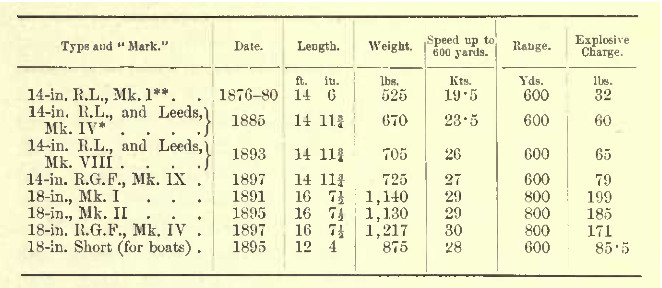
These torpedoes could be discharged in several ways, e.g.,
from dropping-gear a clip-like device by means of which the torpedo was lowered overboard into the water, and there started and released without extraneous impulse.
The ejector-tubes fitted to torpedo-boats and destroyers were, for the most part, training tubes mounted on deck. The tubes fitted in larger craft were chiefly either similar tubes, which were trained through above-water ports; or submerged tubes,which were fixed in position, and which had to be aimed by means of the vessel's helm. Towards the end of the century the tendency lay in the direction of fitting only submerged tubes to large ships, as it was recognised that a hostile projectile striking the detonator or air-chamber of a torpedo in an above-water tube would probably explode it with disastrous results.
It was sought to afford protection to ships against torpedoes by fitting them with moveable nets, or crinolines, which could be boomed out to a considerable distance from the hulls. Nets of this nature were supplied to the Thunderer as early as 1877. They were subsequently much improved, and after 1898 were made so substantial as to be almost impregnable to the assaults of the various cutters, nippers, and other devices with which the noses of Whiteheads were at length provided.
Controllable torpedoes, such as the Brennan, 1 the principle of which was purchased by the British Government in 1882, were never part of the armament of the Navy, but were employed by the War Department for purposes of coast defence. The Brennan was a torpedo driven and directed by means of wires, the home ends of which were on drums in the operating station on shore, and the outward ends of which were on much smaller drums inside the body of the weapon. The very rapid winding-in of the shore ends of the wires worked the propellers of the torpedo; and a very ingenious device enabled the Weapon to be steered with great accuracy. Such a torpedo could not be outmanoeuvred, and it possessed many other advantages; but it was not suitable for use by ships, which would have been liable to have their screws fouled, or to foul the screws of their consorts, by the wires, and which would have been obliged to carry special engines of considerable size wherewith to drive the drums at the necessary speed.
Akin to the torpedo is the submarine boat. Until the autumn of 1900 the British Admiralty appeared to pay but little attention to the assiduity with which certain foreign powers had been experimenting with submarines during the previous twelve or fifteen years. It then suddenly ordered the construction of five craft of the kind by Messrs. Vickers, Sons and Maxim, of Barrow. The type chosen was that of the American Holland boat; and the dimensions were to be: length, 63 feet 4 inches; beam. 11 feet 9 inches; submerged displacement, 120 tons. Propulsion was to be by means of an Otto gasolene engine for surface steaming, and by means of an electric motor of the waterproof pattern for work when submerged. The speed aimed at was 7 knots.
It was explained on behalf of the Admiralty that the ordering of these boats did not necessarily imply that the authorities had any faith in their usefulness for the purposes of war. The boats were required chiefly for experimental purposes. There were indications, however, that, even before the year 1900, the progress of invention had rendered it needless further to experiment with submarine boats which demanded the employment of officers and men in them, and which inevitably exposed their crews to extraordinary risks. Just as, by the Marconi system, it had been found possible to telegraph without wires, so, by the systems of Orling and Armstrong, Fiske, Govan, and others, it had been found possible to transmit to a distance, without the intervention of wires or other artificial connections, electrical impulses whereby automobile torpedoes or larger vessels could be started, stopped, steered, and otherwise controlled. It seemed, therefore, at the end of the century, as if the future, so far as submarine warfare was concerned, lay rather with some weapon like a wireless Brennan l than with the wholly self-contained and self-dependent submarine boat and its crew.
Concerning the progress of materiel in other directions there is room to say little here. The internal illumination of ships was revolutionised during the period under review, the old-fashioned lantern, with its dim candle, giving place first to the scarcely brighter and far more cumbrous oil-lamp, and finally to the electric light. Electric night sights, for guns, were also introduced; and, indeed, electricity on ship-board became of ever increasing importance as the century drew to its end, until at last it was employed, in preference to steam or hydraulics, as a power for the general service of many ships of war, and was applied, for example, to the loading, training, and elevating of heavy guns, as well as to the firing of them; to steering gear; to the working of ammunition hoists, capstans, and cranes; and to the transmission of orders within the vessel, by means not only of telephones, but also of speed, course, and other indicators. It was also used in searchlights; 2 in the working of mast-head and other signals, and of ventilating machinery; and in a hundred other ways far too numerous to specify. Apparatus for wireless telegraphy on the Marconi system was fitted in several British ships in the year 1900.
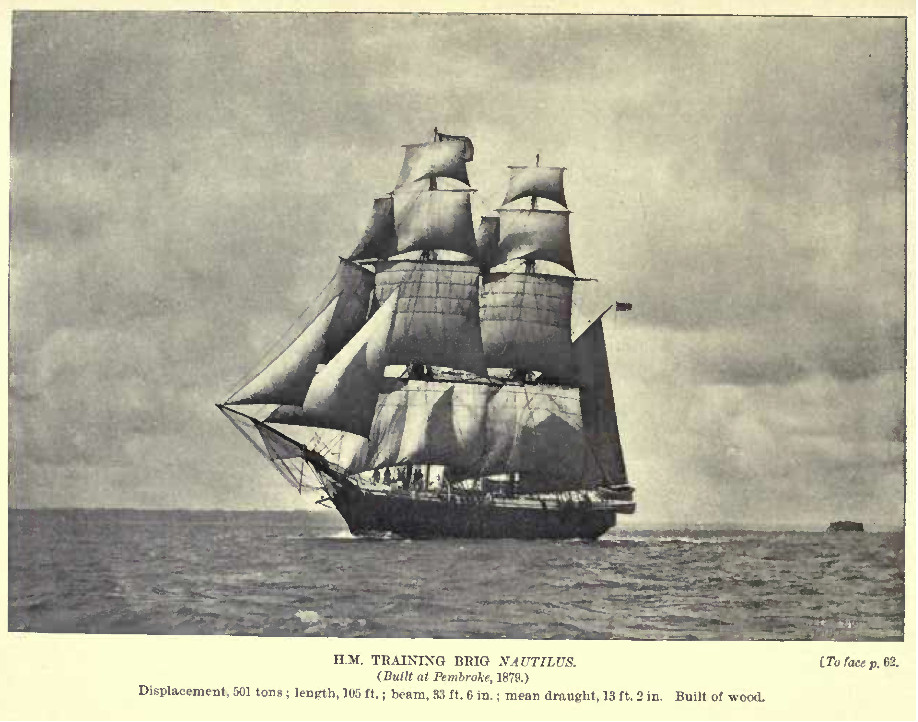
Masts and sails died out very slowly; and, even at the end of the nineteenth century, when they had all but disappeared from the ships of the Navy, their revival, especially in sea-going training vessels, was strenuously advocated by a certain number of naval officers who had been accustomed to them in their youth, and who retained exaggerated ideas of their value, if only as a means of giving physical exercise to seamen, and developing self-reliance, smartness and resourcefulness. By that date, however, the training squadron itself, which until two or three years before had consisted exclusively of masted cruisers, was composed solely of modern vessels without a single sail among them; and almost the only sailing-craft that lingered in commission were a few old brigs attached as tenders to the stationary training-ships for boys at Portland, Portsmouth, and Devonport, the Cruiser, training sloop for ordinary seamen in the Mediterranean, and some semi-obsolete ironclads and cruisers of little or no fighting value, which, though they had masts and sails, seldom moved except under steam.
In the larger craft, the military mast, and, in smaller vessels, the mere pole for signalling purposes, had taken the place of the old mast with yards and sails. The military mast began to come into vogue in the early 'seventies with the advent of the low-freeboard sea-going turret ships of the Devastation type; and, upon the general adoption eight or ten years later of machine and small quick-firing guns, the mast was generally provided with one or more capacious fighting tops in which such weapons could be mounted so as to command an enemy's upper deck in action, and in which searchlights could be placed. The military mast was of steel, and hollow; and the top could be reached either by shrouds or by footholds let into the mast, while, in some cases, there was also a ladder or stairway within the mast. It served not only to support the top, and to furnish lofty look-out posts, but also to carry light cross-jack yards and topmasts, whence signals could be advantageously displayed. To the topmasts semaphore arms and flashing lamps were also frequently fitted, and so arranged as to be worked by men under shelter below. ggg
Conning-towers were provided in all large war-ships of the last quarter of the century. In these, which were heavily armoured, fittings, electrical and otherwise, were placed, by means of which a commanding officer could control the general management of his vessel without quitting the position. But the conning-tower had the necessary disadvantage of occupying a known and exposed post, upon which an enemy would naturally endeavour to concentrate his fire; and it was recognised that the protection afforded, even by very thick armour, would scarcely save an officer within the tower from disabling if not fatal shock in case the tower should be struck fairly by a heavy projectile; while the effects of the impact would certainly involve the putting out of action of the various fittings and the delicate machinery within the tower. While, therefore, conning- towers continued to be built into all large ships of war, many officers held the opinion that their own efficiency in action would be best assured by taking up a position in some other part of the vessel. To meet their views, alternative fighting stations were almost always provided elsewhere, and furnished with facilities for transmitting orders throughout the ship.
The introduction, in 1857, of the International Commercial Code of flag-signals led to gradual improvement in the flag-signalling system in use in the Royal Navy. The Commercial Code is used by British men-of-war for communicating with merchant-vessels or foreign war-ships. This Code originally employed eighteen flags; to which eight have since been added. The Naval Code requires as many as forty-five different flags and pennants.
Great improvements in naval night-signalling 1 began to be made in the early sixties, indirectly in consequence of suggestions put forward by Mr. Charles Babbage, and directly in consequence of the energetic advocacy of Lieutenant Philip Howard Colomb, R.N., who induced Rear-Admiral Sidney Colpoys Dacres to adopt his new system of night-signalling in the Channel Squadron towards the end of 1863, although Rear-Admiral Hastings Reginald Yelverton temporarily restored the old system in 1866.
What the old systems were may be gathered from a paper contributed by Colomb to the Journal of the Royal United Service Institution:
"Simultaneously with the numbering of the flags, the plan adopted to get over the night-signalling difficulty was this: One light meant one: two lights two; three lights three; four lights four; then five was represented by false fires in any number; one gun meant ten; two guns twenty; three guns thirty. Each night-signal set down was then numbered as the day-signals, from one upwards.
"The signal twenty-one was made by two guns for twenty, and one light. The signal seventeen, by one gun for ten, false fires in any number for five, and two lights for two, making seventeen in all. This was the system in use sixty-four years ago, and I am quite satisfied that our present arrangements are not so good. It is found in practice that not more than fifteen forms of light can be used. They are all made with not more than four lights at a time. If, therefore, fifteen signals were all that could be required for night communication at sea, we might suppose that the want was fulfilled; and neither I nor anyone else would have much to say against it. Seeing, however, that 14,000 signals are the requirements of a fleet in the daytime, it would be rather a strain upon our imagination to suppose we could contentedly drop 13,985 of them the moment darkness came on; so that it has all along been the struggle to extend the number of our signals by night to some quantity less disproportionate than 15 to 14,000."
Lieutenant Colomb's energy was rewarded by his promotion to the rank of Commander on December 12th, 1863. The wreck of the gun-vessel Griffon, in October, 1866, after collision with the Pandora, consequent upon the defective condition of the night-signalling system, once more directed attention to Colomb's plan of conveying night messages by means of flashing-signals based upon the Morse Code of longs and shorts; and early in 1867 his plan was officially adopted throughout the service.
In the latter half of the nineteenth century the uniform of British naval officers underwent numerous modifications. At the end of the Russian war 1 changes were made in the distinction marks on the epaulettes;
Midshipmen were provided with dirks instead of swords;
the special engineer button was abolished;
the cap-badge was established; and
mohair instead of gold lace became the material for the cap-band.
Further alterations were made in I860, 2 1861 , 3 and 1863. 4
2 Circ. of July 3, 1860.
3 Mem. of Sept. 5, 1861.
4 Circ. of June 5, 1863, and a subsequent codification of the regulations.
The curl on the sleeve of officers of the executive branch dates from 1860; and in 1863, owing to changes which had been made in the relative rank of officers,
Commanders three, and
Lieutenants two stripes, and
Sub-Lieutenants one stripe of distinction lace on the sleeve.
The distinctive coloured stripes between the stripes of distinction lace on the sleeves of non-military officers also date from 1863, when
white to accountant officers, and
purple velvet to Engineers.
Blue velvet was subsequently assigned to the navigating branch, but it was abolished in 1867, 1 and afterwards given to Naval Instructors.
Narrow gold lace stripes were given to Sub-Lieutenants, and chief warrant officers; and
crimson and gold sashes, superseded in 1874 by aiguillettes, were ordered to be worn by naval aides-de-camp to the Sovereign.
In 1867, moreover, the distinguishing marks for gunnery instructors and seamen-gunners were introduced. Beards and moustaches, if worn together and kept close trimmed, were first allowed in 1869. 2
In 1877 3 Lieutenants of eight years' standing and upwards in that rank, and some other officers, were granted an additional narrow stripe between the two broader ones; and Honorary Physicians and Surgeons to the Sovereign were given a black and gold sash.
In 1879 4 a ship-jacket was introduced, and buttons were ordered to be worn upon the sleeves below the stripes.
In 1885 tunics and helmets, with puggarees for hot climates, were authorised.
In 1888 torpedo-men were granted distinguishing badges.
In 1889 the monkey-jacket was substituted for the blue tunic.
The entire regulations were amended in 1891, 5 when shoulder-straps indicative of rank were directed to be worn on great-coats, on white undress, and on white jackets; and in December, 1900, among other alterations, the collars and cuffs of flag-officers' full dress coats were directed to be decorated with gold oak-leaf embroidery.
Seamen's uniform, very similar to that which was worn until the end of the century, was established in 1857. 6 The tarpaulin hat and blue jacket which formed part of this were, however, abolished in 1891. Further instructions, involving other modifications, were issued in 1893, 7 and February, 1897.
The conferring of good-conduct badges, first established under an Order in Council of January 15th, 1849, was the subject of revised regulations which were promulgated in 1857,8 and which were subsequently amended from time to time. After 1892 patterns of naval uniform were exhibited at the Admiralty, and an illustrated manual on the subject was issued, with the object of ensuring that thenceforward there should be as little divergence as possible from the established types.
2 Circ. of June 24, 1869.
3 The regulations had been re-codified on Oct. 16, 1875: see Circ. of Oct. 30, 1877.
4 Regs, of May 7, 1879.
5 Circ. of Oct. 10, 1891.
6 Circ. of Jan. 30, 1857.
7 Jan. 11, 1893.
The healthiness of the Navy improved astonishingly in the period under review. The improvement was due to numerous causes, such, for example, as the general substitution of iron or steel ships for wooden ones, and the consequent disappearance of bilge-water and its noxious exhalations; the better education and finer moral character of the continuous-service seaman; the fact that the crews of the ships of the last half of the nineteenth century were composed of picked individuals, trained and hardened from boyhood, and not, as had been the case previously, of men drawn from none knew whence, and often old or constitutionally broken; the general advances in sanitation; the use of antiseptics, and the progress of medicine and surgery; the practice of employing distilled water for drinking purposes; and the closer attention paid to the men's comfort on board ship.
The passing of the Contagious Diseases Act in 1866 was another most beneficent factor, until the unwise agitation of a few well-meaning but fanatical enthusiasts induced the legislature, not many years later, to stultify its previous policy by resolving that the Act should no longer be enforced. But for that unfortunate retrogressive step the health of the Navy, in 1900, would have been even better than it was.
In that year, as shown by the Report which was issued in January, 1902, the death-rate in the service was but 7.27 per 1000, or about 3 per cent, less than the general death-rate in the healthiest town in the United Kingdom and that in spite of the fact that the list included 74 deaths from wounds received in South Africa and China, and 17 suicides. The bluejacket, however, was by no means specially exempt from slight illnesses, for during the year there were no fewer than 84,550 cases under medical treatment, or, in other words, 882.29 men out of every 1000 experienced some kind of sickness or accident in the course of the twelve months. It must be admitted, on the other hand, that the seaman of the end of the century was encouraged to appeal to the surgeon upon the smallest excuse, and that every attempt was made by the medical staff to
induce him rather to spend a day or two in the sick-bay than to risk serious results by neglecting himself even for an hour. It is mentioned incidentally in the Report that, during the fighting round Tientsin, the Americans, Germans, Italians, and Russians had neither medical officers nor hospitals, and that their sick and wounded were tended by the British a pleasant testimony to the efficiency of the organisation of the medical department of the Navy. It is also mentioned incidentally that the Boers painted the red cross of Geneva on all sorts of vehicles; that at Belmont they fired on the British from under the cover of "ambulance" wagons; and that at Magersfontein they used "ambulance" wagons to convey rifles and ammunition across exposed positions. 1
The period of the war with Russia marks, in a rough and general way, the line of demarcation between the old Navy of wood and sails, and the new Navy of iron and steam-power; but it also marks the opening of an era of progress and advancement more rapid as well as more striking than had ever been witnessed previously. When once the Navy began to change, it changed with almost bewildering speed, and continued to change with steadily increasing quickness. So much, indeed, was this the case, that it may be said with little or no fear of exaggeration that the best ship existing in 1867 would have been more than a match for the entire British fleet existing in 1857, and, again, that the best ship existing in 1877 would have been almost, if not quite, equal to fighting and beating the entire fleet of only ten years earlier.
By 1890, the ships of 1877 had become well-nigh obsolete; and by 1900 the best ships, even of 1890, were hardly worthy of a place in the crack fleets of the country. Nay, as a matter of fact, of the eight battleships which belonged to the Channel squadron at the end of 1900, the oldest had been less than eight years off the stocks; and of the ten battleships which at the same date were attached to the sea-going Mediterranean fleet, not one had been launched nine years. As with the battleships, so with the cruisers. By the end of 1900 the best cruisers of 1890 had been told off to the less important stations; and, in the meantime, the fleets everywhere had been reinforced with craft, such as destroyers, of types which in 1890 had been utterly unknown.
Training ships and schools
To keep pace with these continuous changes it was early recognised that fresh provision must be made for the technical and scientific training of officers and men. Up to 1854, Naval Cadets, upon nomination, went at once, as a rule, to sea-going and regularly commissioned ships, where they had to pick up their professional education as best they could from the Naval Instructors and other officers who were their shipmates. In 1854 an improvement was made by the commissioning at Portsmouth of an old wooden ship of the line, the Illustrious, Captain Robert Harris, as a stationary training ship, or school, for Naval Cadets.
A similar school was opened in the Implacable, at Devonport, in 1855; but one school was soon found to be enough for the purpose, and the Devonport establishment was closed. New regulations for the entry and training of Naval Cadets were issued in 1857 1; and on January 1st, 1859, the Britannia, 120, 2 was commissioned at Portsmouth by the same Captain Robert Harris to take the place of the less suitable Illustrious.
She was removed to Portland in 1862, and to more appropriate moorings at Dartmouth on September 30th, 1863; and although the original Britannia was later condemned, a new Britannia, previously known as the Prince of Wales, 3 took her place in July, 1869, and retained it until the end of the nineteenth century, at which time, however, preparations were in progress for the removal of the whole establishment to quarters on shore hard by. In 1870, the Trafalgar, 60, screw, was commissioned as a sea-going training-ship for cadets; and the Bristol, 31, Aurora, 28, and other vessels were subsequently used for the same purpose until the establishment of the regular Training Squadron in 1885.
Something has been written already 4 concerning the origin of the naval gunnery schools at Portsmouth and Devonport. At Portsmouth the establishment was housed afloat for many years in the Excellent (ex-Boyne, built in 1810), and subsequently in another Excellent (ex-Queen Charlotte, built also in 1810). In 1891, however, when barracks, practice-batteries, etc., had been erected on Whale Island, a piece of made land in Portsmouth Harbour, the establishment was transferred to the shore and housed in the commodious new buildings, although the officers and men
2 Blt. in 1820.
3 A 131-gun ship of 6201 tons, built in 1800.
4 See Vol. VI. p. 203.
attached to the school continued to be nominally borne afloat. The Excellent, which had been the Queen Charlotte, was in that year condemned; and the conventional headquarters of the school were lodged in a 508-ton gunboat, the Handy (built in 1883), which thereupon took over the name Excellent, and retained it until the end of the period under review. Numerous tenders were attached to her for gunnery training afloat; and on shore at Whale Island such parts of the gunnery course, including field exercises and theoretical instruction, as could be carried out as well or better on dry land were attended to.
The Devonport gunnery school was established in 1856 on board the Cambridge (built in 1815), and was eventually transferred to another Cambridge (ex-Windsor Castle, built in 1858), in which it remained afloat for the rest of the century. A gunnery school on shore was subsequently established at Sheerness, the staff and other officers and men attached to it being borne in the Wildfire, flagship at the Nore.
In the meantime, the increasing importance of electricity and submarine mining, and the introduction of the torpedo, necessitated the establishment of torpedo schools, the Vernon 1 being told off for the purpose at Portsmouth in 1876, 2 and the Defiance 3 at Devonport in 1884.
After the usefulness of destroyers had become evident, and when sufficient numbers of such craft became available, sea-going instructional flotillas of them were formed in 1895, with headquarters at Portsmouth, Devonport, and in the Medway respectively; and large numbers both of stokers and of seamen were systematically passed through them for purposes of practical training.
It may be added that a signal school was established at Portsmouth in 1888; and a school of telegraphy at Devonport in 1899; and that homing-pigeon lofts were opened at Portsmouth in 1896, and at Devonport in 1897. Several years earlier, while afloat during the Naval Manoeuvres, the author, from a ship thirty or forty miles from the Irish coast, sent by pigeon a message which duly reached and was published, with an explanatory note, by the Times. The bird used on that occasion belonged to Kingstown, and its services were lent to the writer by its owner, a naval officer.
2 The Vernon had previously, from 1873, been a kind of torpedo tender to the Excellent. The (T) prefixed to the names of Torpedo-Lieutenants first appeared in the Navy List of November, 1878.
3 The Defiance was an old 91-gun ship of 1861.
4 The Lion.
Of the training establishments for boys for the Navy, the one at Devonport, known as the Lion (built in 1847) and previously known as the Implacable l (the two ships being ultimately combined), dates from 1860; the one at Portland (formerly in Southampton Water), known as the Boscawen, 2 from 1861; and the one at Portsmouth, known as the St. Vincent, 3 from 1862. Other boys' training-ships were added from time to time, sailing brigs being attached to most of them for instructional purposes. The education of the boys was continued, at one time in the flying squadrons which were temporarily organised, and afterwards in the regularly constituted Training Squadron, which, only in the last year of the century, was modernised and made to consist exclusively of mastless ships. 4
The education of engineer officers for the Navy was furthered by the establishment of a school for engineer students in the Marlborough, and by the opening of Keyham College in 1880; the advanced training of officers, and especially of executive officers, in theoretical subjects, by the opening of the Royal Naval College at Greenwich in 1873 5; and the development of the science of naval architecture, by the establishment of a Royal School of Naval Architecture 6 at Kensington in 1863, and by the re-organisation of the Royal Corps of Naval Constructors in 1883. 7
The training of the reserves was, perhaps rather inadequately, provided for by the stationing at various points round the coast of antiquated vessels as drill ships for the Royal Naval Reserve; for all these craft mounted guns which were obsolete and useless, and only in the last few years of the century were comparatively modern ships substituted for a few of the old ones, and better guns supplied here and there for exercise purposes.
The sea-training of the Coast Guard was carried on in the Coast Guard District Ships. These, like the Drill Ships of Reserve, were often most unsuitable craft until 1870, when the ironclad Repulse was sent as guard-ship to Queensferry. Efficient fighting vessels gradually thenceforward found their way to the various ports, not only as coast guard-ships, but also as port guard-ships. These last, originally the flagships of the Port Admirals, were, in 1857 and for many years
2 The Boscawen, built in 1841.
3 The St. Vincent, built in 1815.
4 The Training Squadron became the Cruiser Squadron in 1901.
5 The first President was R.-Adm. Sir Astley Cooper Key. See Admlty. Min. of Jan. 17, 1873.
6 The Admiralty section of this was transferred to the R. N. Coll. at Greenwich in 1873.
7 Parl. Paper, No. 277 of 1883.
afterwards, old sailing ships of the line, with no fighting value save perhaps as floating batteries. In course of time, however, the salutary practice arose of employing as port guard-ships fighting craft ready to go to sea at a few hours' notice. It then became the custom to fly the Port Admiral's flag, not in the guard-ship, but in some yacht or other non-fighting vessel. Thus, in 1900, the flagships at the principal ports were:
at Portsmouth, Nelson's Victory, with the battleships Trafalgar and Inflexible as guard-ships; and
at Plymouth, the yacht Vivid, with the battleships Nile and Devastation as guard-ships.
The higher naval education was furthered somewhat, especially towards the end of the nineteenth century, by the influence of the Royal United Service Institution. The establishment of this was first advocated in 1829. The actual establishment dates from June 25th, 1831, when it was formed as "The Naval and Military Library and Museum," and was lodged in Vanbrugh House, Whitehall Yard, a small building furnished for the purpose by the Government. In 1833 a larger house, the old office of the Board of Works in Inner Scotland Yard, was also provided at the national expense, and the two buildings were connected. A lecture theatre was added in 1849-50.
In the meantime the name had been changed to the one which the Institution now bears. The Journal, in which the proceedings of the Institution and other matters of naval and military interest are recorded, has been published periodically since 1857; in which year also the Government began to recognise the usefulness of the Institution by making an annual contribution to its funds. In 1860 a royal charter of incorporation was granted; from 1874 onwards a gold medal was offered yearly for the best naval or military essay read before the members; and in 1890 Queen Victoria granted to the Institution the use of its present quarters, the Banqueting House, Whitehall, to which additions were made at the south end. These were completed and opened by H.R.H. the Prince of Wales on February 20th, 1895.
The Institution includes a very valuable museum, a large theatre, a council room, a library, two reading rooms, and a topographical room. Lectures on naval and military subjects are delivered periodically in the theatre, and are subsequently discussed. Ordinary membership is confined to officers, active or retired, of the two services, and to officials of the naval and military departments, the entrance fee being £1, and the annual subscription a like sum. 1 The Institution deserves the support of all naval officers.
Other changes
To attempt to give even a mere bald catalogue of the minor legislative and administrative changes which influenced the Navy during the second half of the nineteenth century is here impossible. A few departures of special interest which may be noted are: the establishment in 1866 of savings' banks for the Navy and Royal Marines (29 & 30 Viet. c. 43); the introduction in 1860 of uniform watch-bills, quarter-bills, and station-bills; the passing of the Naval Discipline Act of 1861, and of the New Naval Discipline Act of 1866; the issue in 1871 1 of a circular restricting the infliction of corporal punishment in peace time; the practical abolition of flogging in 1879; the withdrawal, in 1874, of flag-officers' privileges in connection with the filling of death vacancies, and with the making of haul-down promotions 2; and the adoption, in 1875, of a special form of service, compiled by the Archbishop of Canterbury, for use at the launching of H. M. ships. 3
On March 21st, 1862, the Royal Marine Artillery, with its headquarters at Eastney, was formed into a separate division; and in 1869 the Woolwich division of the Royal Marines was abolished. Unhappily it has been impossible in these volumes to do full justice to the splendid services of this magnificent corps, which during the reign of Queen Victoria amply maintained its old glorious reputation. When, for example, on December 14th, 1864, the screw line-of-battle ship Bombay was destroyed by fire off Montevideo, 34 of the 97 officers and men who perished were Marines, every sentry dying at his post. The record of the corps, indeed, has been equally fine in peace and in war. All its more conspicuous war services will, of course, be found chronicled in this book, but not, it may be feared, with as much detail as they deserve.
A valuable innovation, due, however, not to official but to private initiative, was the publication for the first time in January, 1878, of Lean's ' Royal Navy List,' a quarterly, giving the dates of all commissions, and a record of the war services of every officer of the Royal Navy and Royal Marines, retired as well as active. This indispensable work of reference continued to be edited until the end of the century by its founder, Lieut.-Colonel Francis Lean, R.M.
2 Circ, of Nov. 10, 1874.
3 First used on Jan. 19, 1875, at the launch of the tug Perseverance, at Devonport.
Honours and awards
Several orders and distinctions which were first created during the period under review have been, or may be, conferred upon naval officers, and should, therefore, be mentioned here. Of these are
the Most Eminent Order of the Indian Empire, instituted in 1878, and enlarged in 1887, the ribbon of which is of "imperial" blue;
the Distinguished Service Order, instituted in 1886, the ribbon of which is of red, with blue edges; and
the Royal Victorian Order, instituted in 1896, the ribbon of which is of dark blue with a narrow edging of three stripes, red, white, and red.
Open to all ranks is the Albert Medal, instituted in 1866 for gallantry in saving or attempting to save life at sea, and enlarged in 1877 so as to be available for rewarding similar acts performed ashore. The Royal Humane Society's medals for saving or attempting to save life at sea, and the same Society's Stanhope Gold Medal, granted for the greatest act of gallantry of each year, may be worn by naval officers and men, if specially authorised, upon the right breast, as also may be the medals awarded by the Royal National Lifeboat Institution, the Shipwrecked Fishermen and Mariners' Royal Benevolent Society, the honorary silver medal of Lloyd's, the Board of Trade medal, and the medal of the Liverpool Shipwreck and Humane Society.
In connection with this subject it may be added that the naval and Marine winners of the gold medal of the Royal United Service Institution, with their rank at the time, were as follows:
A few words on the subject of naval clubs may find a fit place here.
Clubs of naval officers existed in London in the seventeenth century; and, about the year 1675, one of them was in the habit of meeting at the Vulture Tavern in Cornhill on Tuesdays, and of dining there, assembling at 1 P.M., and separating at 5 P.M. Not many years afterwards a naval club existed at a tavern or coffee-house at Portsmouth. The oldest institution of the kind, however, that survived at the end of the nineteenth century was the Royal Navy Club of 1765, which, since January, 1889, had been united with an organisation, the Navy Club, only a few years its junior.
The Royal Navy Club of 1765 was founded on February 4th, 1765, at a meeting which was held at the house of Captain (later Sir) Basil Keith, R.N., among the other officers present being Captain (afterwards Admiral Sir) Richard Onslow, and Captain (afterwards Admiral Sir) Hyde Parker (2). The proceedings of that day were confirmed, and rules were drawn up, at a meeting at the St. Alban's Tavern on February 11th, when the club was formally named "The Navy Society."
In the beginning it seems to have dined on Tuesdays during the season between November and April, first, for a short time, at the St. Alban's Tavern, then at the Castle Tavern, Henrietta Street, and then at the Shakespeare's Head. At that time twelve dinners a year were held. Subsequently the number was thirteen. In 1806 it removed to the Crown and Anchor; in 1826, to the Piazza Coffee House, in Covent Garden; and in 1850, to the Thatched House Tavern, St. James's Street. In 1829 the title of the society became "The Royal Naval Club of 1765." Among the distinguished officers who at various times belonged to it were Kempenfelt, St. Vincent, Duncan, Hyde Parker (1), Howe, Bridport, Collingwood, Exmouth, de Saumarez, Nelson, Sidney Smith, Troubridge, and King William IV.
The Navy Club, founded in 1785, was also a dining club, but with a limited membership. It met while Parliament was sitting. Its first house was the Star and Garter, in the City, where it dined on alternate Wednesdays. In 1800 it migrated to the Thatched House Tavern in St. James's Street, and dined first at 4 P.M., then at 5, and, after 1810, at 6 P.M. In 1825 the hour was 7 P.M. from Lady Day to the end of the season, the meeting days being then, or soon afterwards, Thursdays. In 1858 the dinner-hour became 7.30 P.M., and in 1861 the club removed to Willis's Rooms (late Almack's). Among its members have been Keppel, Barrington, Hotham, Cornwallis, Gardner, Keith, Gambier, Nelson, Warren, Stopford, Hardy, Blackwood, Codrington, Hoste, and Broke. As has been mentioned already, it amalgamated with the older society in 1889. 1 After the closing of Willis's Rooms the club held its dinners at various places.
Attempts to found other exclusively naval clubs in London have not been on the whole successful; but naval, as well as military, officers are admitted to the United Service 1 (founded 1815), the Junior United Service (1827), the Army and Navy 2 (1838), the Naval and Military (1862), the Junior Army and Navy (1869), etc. At Portsmouth, however, an exclusively naval club, carried on after the fashion of the large clubs in London, has existed for many years; and there are clubs of the same kind at naval stations abroad.
England has been described as Mother of Parliaments. With almost equal fitness she may be called a Mother of Navies. Already in these volumes many examples have been given of services rendered by her officers to the rising or struggling navies of other powers, and especially to those of Russia, Portugal, and the South American republics. In the latter half of the nineteenth century she was frequently appealed to to furnish instructors and leaders to nations desirous either of creating fleets or of improving such fleets as they already possessed; and, with or without permission of the Admiralty, numerous British officers, whose names deserve to be remembered, went abroad at various times, and devoted themselves to the development of foreign navies.
Turkey, for example, secured the assistance of Captain Adolphus Slade, 3 who served her for about sixteen years, ending with 1866, and was known in the East as Muchaver Pasha. Captain the Hon. Augustus Charles Hobart 4 (later Hobart-Hampton), served her for many years from 1868 onwards, and as Pasha commanded her fleet during her war with Russia in 1877-78. Navigating-Lieutenant Henry Felix Woods 5 also entered her service about 1868, and was created a Pasha in 1883; and Commander Charles William Manthorpe 6 assumed the Ottoman uniform about the year 1877.
Egypt benefited by the services of Captain 'Henry Frederick M'Killop 7; Commander George Morice, 8 who joined the Khedive in 1871, and was made a Ferik in 1886; and Lieutenant Arthur Charles Middlemass, who was lent to the Egyptian coastguard in 1884.
2 Known as "The Rag."
3 Born 1804; Capt. R.N. 1849; died V.-Adm. on retd. list, 1877.
4 Born 1822; Capt. R.N. 1863; died 188G.
5 Nav.-Lieut. 1867; retd. 1874.
6 Com. 1866; capt. on retd. list, 1873.
7 Capt. R.N. 1862; retd. 1870.
8 Com. 1869; capt. on retd. list, 1884.
China obtained at various times the professional assistance of Captains Eichard Edward Tracey, Percy Putt Luxmoore, and William Metcalfe Lang, as well as of Commander Lawrence Ching, and of several Lieutenants and other officers. Both China and Japan also sent some of their own young officers to serve, by permission, in the British Navy, as did Germany, Chili, Denmark, Sweden, Norway, Greece, and other nationalities.
The Japanese Navy, which, in the last thirty years of the century, grew in efficiency as well as in size until it ranked with the navies of the great continental European powers, was, in its infancy, developed and trained entirely by British officers; among whom should be mentioned Commander Archibald Lucius Douglas, Lieutenant (retd. commander) Charles William Jones (who died Director of the Japanese Naval College in 1877), Navigating-Lieutenant Charles William Baillie, Lieutenant Albert George Sidney Hawes, R.M., Chief-Engineer Frederick William Sutton (2), and Engineer Thomas Skinner Gissing, all of whom served Japan during the decade 1870-1880, and Captain John Ingles, who was naval adviser to the Japanese government from 1887 to 1893.
In addition, many British officers served in the various Indian marines, all of which were amalgamated in 1877; and others had a share in the development, if not in the establishment, of the Colonial Navies which sprang into existence in the last half of the nineteenth century in New South Wales, Victoria, South Australia, and Queensland. 1 Some of these were able to contribute to the general service of the Empire during the troubles in North China in 1900.
Great Britain never derived, nor endeavoured to derive, compensating advantages from abroad. Instead of following the example of the other great powers, and appointing a naval attache to her diplomatic representative in each country possessed of a navy of any importance, she made it a practice to appoint one attache, who had to divide his attentions over the whole of Europe, and one other, accredited to the United States. Only occasionally and temporarily did she depart from this custom, the result being that, in spite of the goodwill and energy of her representatives, she has always been very indifferently served, at least in Europe.
Among the officers who did duty for her as naval attaches at different times were, in Europe, Captains Edward George Hore (who made Paris his official headquarters for eleven years prior to his death in 1871), James Graham Goodenough, Edward Henry Howard (1874-77), Henry Frederick Nicholson, Hubert Henry Grenfell, and Ernest Rice, and, at Washington, Rear-Admirals Edward Augustus Inglefield, and William Gore Jones, and Captain the Hon. William John Ward. The Naval Intelligence Department at the Admiralty, under the Director of Naval Intelligence, was formed in January, 1887. Its establishment should have been followed at once by the appointment of many more attaches; for there can be no doubt that capable and active attaches, especially if they be good linguists and professional enthusiasts, may be most valuable collectors of useful information, and that countries like France, Russia, Germany, Italy, and Japan are each worthy of having a representative sent to them by any navy which desires to keep abreast of all modern progress. At the end of the century, nevertheless, there were still only three officers so employed.
In the days of non-continuous service the British bluejacket was never properly appreciated by his country, except, indeed, during the great wars. Over and over again, when his services became urgently necessary, Great Britain was reminded by costly experience of his inestimable value, and of the difficulty of obtaining him keen, sound, and already trained for effective work in her fleets. Over and over again, when the peril had passed away, she thanklessly set him adrift in the world, and left him to shift for himself until she should again have need of men. It is true that Greenwich Hospital was open to him in the event of his disablement by wounds, disease, or old age, provided always that he could first qualify for admission to it; but, if he were still fit for service, his country was so short-sighted as to neglect him almost entirely, not only after he had been paid off, but also when he happened to be ashore for a few days' leave. Indeed, it seemed to be accepted that the country had little or no interest in him except when he was actually doing duty.
Wiser views began to prevail in the middle of the nineteenth century; and nothing, perhaps, is better illustrative of the change which has come over the bluejackets in regard as well to the estimation in which he is held as to the estimation in which he holds himself, than the history of the rise and progress of the Sailors' Home at Portsmouth, and of similar institutions there and elsewhere.
In 1850 or 1851, just before the introduction of continuous service, and when men were still being paid off with pockets full of money, to be the prey of sharks and harpies, far, perhaps, from home and friends, it occurred to three officers, Sir Edward Parry, Captain Robert Fitzgerald Gambier, and Captain William Hutcheon Hall, to found a home where bluejackets might find shelter from the perils and snares of the Portsmouth streets. Many excellent people laughed at the scheme; but Queen Victoria and the Prince Consort at once gave their support and subscriptions to it, and in 1852 the Home was established and opened, with twenty-four cabins, containing thirty beds.
Fresh accommodation was quickly discovered to be necessary. On the first Christmas night of the Home's existence, in spite of the fact that it had already been twice enlarged, more than half of the 250 men who slept in it had to lie on the bare floors. There could no longer be any doubt as to its utility. Supported chiefly by outside contributions, it continued to do steadily-increasing good work until 1864, when five-and-twenty petty officers and seamen who had enjoyed its hospitality set the example of contributing to its funds. From that time the Home began to become a club rather than a mere refuge, and soon seamen by the hundred subscribed to it.
In 1869 a canteen for the sale of malt liquors was opened; in 1870 an additional hundred cabins were fitted up; and it became a common practice among bluejackets and Marines to allot their half-pay to the manager for safe-keeping, and to entrust him with their little valuables. In 1871 a large recreation room was added, a room which soon became a favourite meeting-place for the members of naval friendly societies, and for parties of various kinds. In time and, strangely enough, at the instigation of a distinguished teetotaler the canteen was authorised to supply not only beer, but also all the liquors which are ordinarily provided at taverns, care being, of course, taken to supply them of good quality. The experiment, though bold, was in every way successful, and immensely increased the popularity and usefulness of this admirable institution, which was obliged to add largely to its sleeping accommodation in 1887, and again in 1897.
At the end of the century upwards of 100,000 men per annum lodged under its roof. Its influence in developing among bluejackets self-respect, esprit de corps, providence, and general culture has been most beneficial. Conversely, the ever-growing intelligence and good character of the men has enabled the managers of the Home gradually to broaden its scope and its rules without imperilling its orderliness and efficiency. 1
Miss Agnes E. Weston's Royal Sailors' Rests at Devonport (established in 1873) and Portsmouth, have done equally good work, but are conducted on somewhat narrower lines. The long devotion of this excellent lady, and her assistant, Miss Wintz, to the interests of bluejackets and other seamen, has had a powerful influence in the promotion of the cause of temperance, besides being most beneficial in other directions.
Another sign of the times was the establishment of the Royal Naval Fund. The Royal Naval Exhibition held at Chelsea in 1891 resulted in a profit of about £48,000. It was decided by the Committee to hand over this sum to trustees, who were instructed to devote the resultant income to the relief of widows, orphans, and other dependent relatives of seamen and Royal Marines dying in the service of the Crown. The Fund began work on January 1st, 1893, between which date and the end of the century it distributed £10,523, by way of relief, to 1,305 persons. The capital on December 31st, 1900, was £50,532.
Until well on in the second half of the nineteenth century the lay public seems to have taken but little practical interest in the Royal Navy. It read with natural avidity the numerous exciting accounts of maritime discovery, and the few nautical novels, such as Smollett's 'Roderick Random,' and John Moore's 'The Post-Captain,' which appeared during the eighteenth century; and, in the earlier part of the nineteenth, it eagerly perused the stirring records of polar exploration, and the nautical novels of writers like Michael Scott, 2 James Fenimore Cooper, 3 Frederick Marryat, 4 James Hannay, 5 and Frederic Chamier 6; but, upon the whole, it was content to accept the Navy as the traditional and invincible defender of the island empire, never questioning, nor even allowing itself to dream about, the fleet's permanent ability to do whatsoever work might be demanded of it.
2 Mich. Scott (1789-1835), author of 'Tom Cringle's Log,' and 'The 'Cruise of the Midge.'
3 Born 1789; d. 1851. From 1805 to 1811, Cooper was in the U.S. Navy.
4 Born 1792; Com. R.N. 1815; Capt. 1825; d. 1847.
5 Born 1827; d. 1873. From 1840 to 1845, Hannay served in the Navy
6 Born 1796; Com. R.N. 1826; retd. capt. 1856; d. 1870.
The truth is that the lay public generally regarded the Navy, nautical terminology, and naval men as mysteries which it could not hope to understand, and which certainly could not be benefited by the attentions or solicitude of landsmen. John Clerk, of Eldin, indeed, in the last quarter of the eighteenth century, offered a civilian's counsel to naval tacticians; but he stood almost alone in his generation, and, for many years after his death, British laymen scarcely raised their voices or used their pens to make either criticisms or suggestions concerning the conduct of naval affairs.
The last half of the nineteenth century witnessed a notable change in the popular attitude. Laymen were no longer satisfied to be told that all was well with the fleet, whereon, as they knew, so much depended. They began to take a practical interest in the Navy, and to see and enquire for themselves. The meagreness of the results attained by the Navy during the Russian war aroused them from their apathy; Mr. Hans Busk's volume on 'The Navies of the World' l rendered them uneasy as to the maritime position of their country; the naval display at the Exhibition of 1862 stimulated their curiosity with regard to the growing influence of scientific progress upon naval warfare. Then, in 1864, the Admiralty furthered the popular movement by transferring to South Kensington Museum, and throwing open to all, the collection of naval models which, since the first quarter of the century, had been gradually accumulated at Somerset House.
Ten years afterwards the collection was moved to a still more suitable resting-place at Greenwich Hospital. Not without its effect, too, was the establishment, in 1860, by Dr. William Howard Russell, of the Army and Navy Gazette, a service periodical which, especially in the early years of its existence, was singularly able and outspoken, and which pertinaciously exposed many naval abuses and procured the granting of many naval reforms.
Fifteen or sixteen years later, when Lord Charles Beresford, then a Commander, was member for Waterford, that active officer, in order to induce some of his brother legislators to examine into naval affairs, began a practice of occasionally inviting them to accompany him on a visit to Portsmouth Dockyard; and he resumed this practice, with excellent results, whenever he subsequently held a seat in Parliament.
Still, however, popular interest was not thoroughly awakened; nor was it until 1884 that the British pbhlic was induced to begin to take that intelligent and steadily growing interest in its fleet which, in the remaining sixteen years of the century, obliged successive governments, often against their will, to enlarge and improve the Navy, until it became more efficient than it had ever been before in time of peace.
The work was begun by means of the publication, in the Pall Mall Gazette, of the remarkable series of articles 1 entitled "The Truth About the Navy"; it was followed up, in 1885, by the exaction from the Admiralty of permission for the leading newspapers to depute correspondents to accompany the home fleets during their annual manoeuvres, which date from that year. In 1888-89 the City of London, influenced not only by naval officers such as Sir Geoffrey T. P. Hornby and Lord Charles Beresford, but also by civilians, put forward demands for a stronger fleet, and had its way.
In the interval the Jubilee naval review at Spithead, in 1887, had exhibited to the people the weakness as well as the strength of the Navy; and the lessons of the display had been interpreted to them by the numerous writers who, in the years immediately preceding it, had found means to make a special study of the subject, and to gain a hearing through the columns of the press. In 1888 had been made the first suggestions for a scheme which, a few years later, 2 resulted in the formation of the Navy League an organisation, mainly civilian in its constitution, pledged to do its utmost to secure naval efficiency and a fleet entirely adequate to the needs of the Empire.
All this prepared the way for the holding at Chelsea in 1891 of the extraordinarily successful and immensely instructive Royal Naval Exhibition, under the patronage of Her Majesty Queen Victoria, the presidency of H.R.H. the Prince of Wales, Honorary Admiral of the Fleet, the executive direction of Admiral Sir William Montagu Dowell, K.C.B., and the honorary secretaryship of Captain Alfred Jephson, 3 who was rewarded for the efficacy of his work with a knighthood.
2 In 1894.
3 Com. R.N. 1873; retd. as capt. 1889.

The Exhibition, which was open to the public on 151 days, was visited by 2,351,083 people, 1 and was, undoubtedly, of the highest educational value.
In the same year the present writer had the pleasure of making public 2 a suggestion which led, in 1893, to the foundation of the Navy Records Society a society for the printing of documents and papers connected with naval history, biography, and archaeology, much of the success of which has been due to the devotion of its secretary and editor, Professor John Knox Laughton. 3 And in 1895, when, after the heavy expenditure which had been authorised by the Naval Defence Act of 1889, it appeared that the effort to raise the Navy to an adequate point of strength was to be allowed to flag, popular opinion so quickly and markedly responded to a demand 4 for additional ships and men, that the government at once increased the ordinary estimates to an amount about £3,000,000 in excess of what they had ever before been in peace time, and never afterwards, until the end of the century, suffered them to fall below the level to which they then attained. Popular and civilian interest in the Navy, thus gradually aroused, remains an important factor in the policy of the Admiralty until to-day.
The Jubilee naval review, which has been already alluded to, was held on July 23rd, 1887. The total number of vessels in line, apart from yachts, troopships, tugs, etc., was 109, of which twenty-six were ironclads. The senior officer afloat on that occasion was Admiral Sir George Ommanney Willes, Commander-in-Chief at Portsmouth, who flew his flag in the battleship Inflexible.
A yet more impressive review was held at Spithead on August 6th, 1889, when His Majesty William II., German Emperor, 6 visited Spithead with a detachment of his own fleet in order to be present. The number of British men-of-war in line on that day was again 109, but of them no fewer than thirty-five were ironclads. The officer then in command was Admiral Sir John Edmund Commerell, V.C., Commander-in-Chief at Portsmouth. H.R.H. Prince George of Wales, 6 as a Lieutenant, was in command then, and during the subsequent manoeuvres, of torpedo-boat No. 79.
2 A. and N. Gazette, July 4, 1891, and subseq. corr. in the Times.
3 Born 1830; Nav. Inst. R.N. 1853; prof, of mod. hist, at King's Coll., Lond.
4 Made in a series of articles on "The Needs of the Navy," by the author (anonymously), in the Daily Graphic.
5 Hon. Adm. of the Fleet, Aug. 2, 1889.
6 Entered R.N. June 5, 1877; Mids. Jan. 8, 1880; Sub-Lieut. June 3, 1884: Lieut. Oct. 8, 1885; Com. Aug. 24, 1891; Capt. Jan. 2, 1893; R. Adm. Jan. 1, 1901. Served actively at sea in each rank.
Very much more impressive still was the last great review of the reign, on June 26th, 1897, to commemorate the sixtieth anniversary of Her Majesty Queen Victoria's accession. Numerous foreign men-of-war were present in honour of the event, and the number of British ships in line that day was as many as 164. There were somewhat fewer ironclads than in 1889; but, on the other hand, whereas the fleet of 1889 contained numerous obsolete craft such as could scarcely have been employed actively in war time, the fleet of 1897 was composed, with very few exceptions, of modern vessels in the highest state of efficiency. (see "Year of the Diamond Jubilee Naval Review: Royal Navy Ship Deployments 1897")
At the end of the day H.R.H. the Prince of Wales, Honorary Admiral of the Fleet, 1 genially desired Admiral Sir Nowell Salmon, V.C., Commander-in-Chief, to order the main-brace to be spliced. About 35,000 officers and men manned the British men-of-war present at that final and most magnificent of the naval reviews of the century; and American, German, Russian, Spanish, French, Austrian, Swedish, Norwegian, Japanese, and Siamese men-of-war attended to witness it, and to do honour to the aged sovereign of Great Britain.
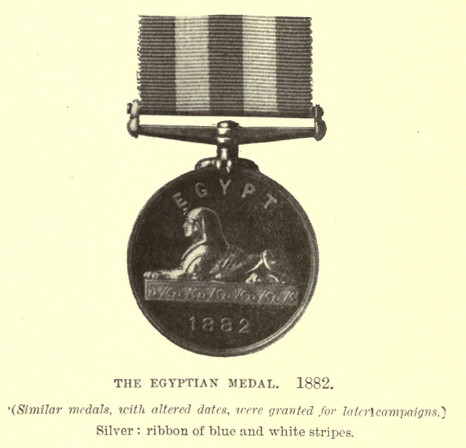
|
VOLUME
7
Contents in Full A
Modern Introduction
Introduction, 1857-1900 Ch 46. Civil History of the Royal Navy (here) Ch 47. Military History of the Royal Navy (in preparation) Ch 48. Voyages and Discoveries App
A to Ch 46-48: List of Flag-Officers Promoted
App B to Ch 46-48: List of H.M. Ships Lost, Etc., (in preparation) |
on
to App to Ch 46, Flag Officers
or
return to "Pax Britannica" 1815-1914
revised 12/10/15
